駅訪問記 0
[鉄道ミニエッセイ] カテゴリの記事
全75件 (75件中 1-50件目)
-
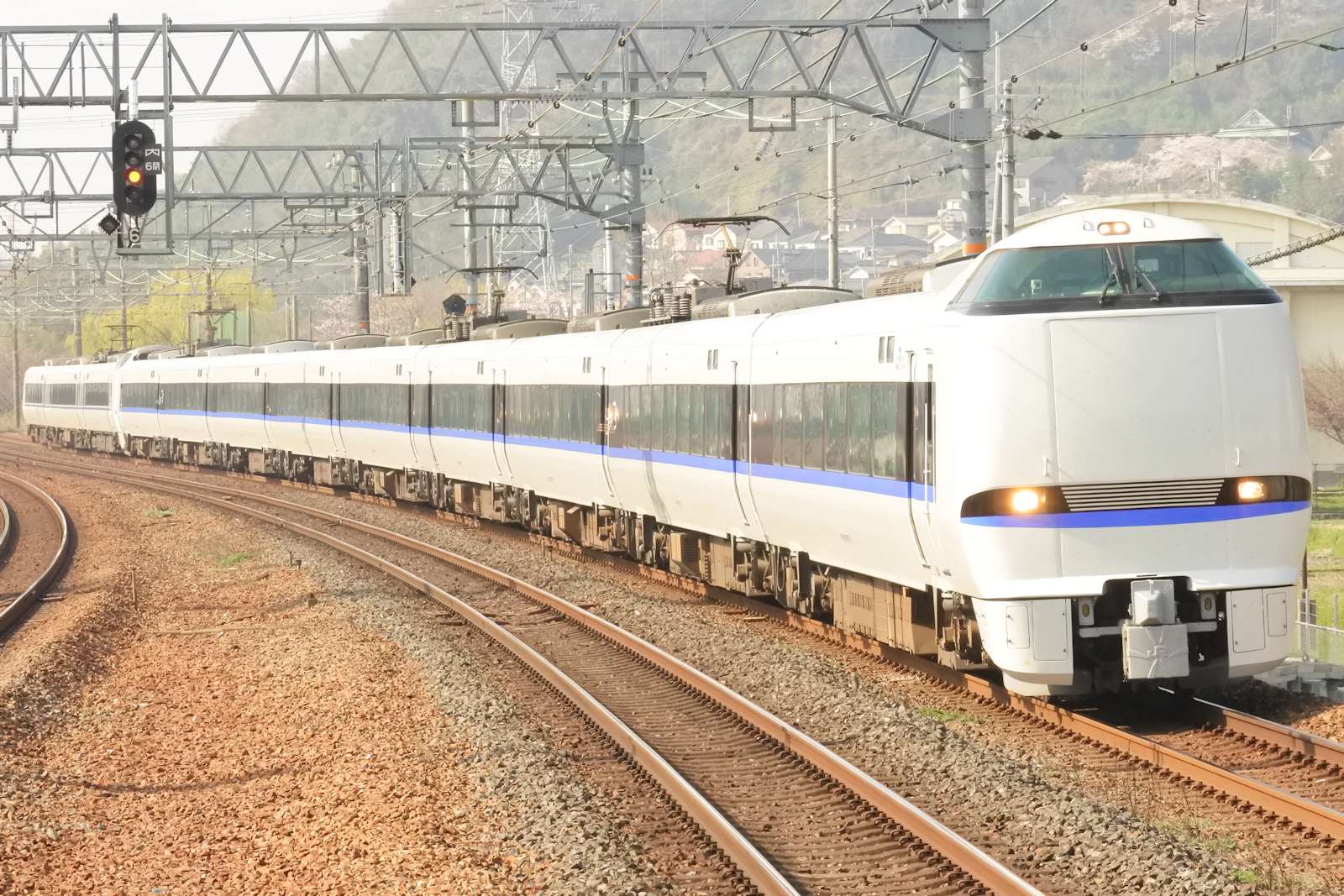
683系「サンダーバード」に乗る
金沢駅から、683系電車のリニューアル車による特急「サンダーバード」へと乗り継ぐ。僕が683系に乗るのは、2013(平成25)年の「はくたか」(当時北越急行所属だった8000番台)以来8年ぶりのことだが、体質改善(リニューアル)車は今回が初めてだった。金沢駅を発車すると、W7系新幹線列車と同様に「北陸ロマン」の車内チャイムが流れる。車窓を見ると、2025(令和7)年春頃開業予定の北陸新幹線の延伸区間の線路と近づいたり離れたりを繰り返す。今回僕が乗った列車の停車駅も、小松駅、加賀温泉駅、芦原温泉駅と、北陸新幹線も停車する予定の駅だった。どの駅も新幹線開業に向けてのホームの新設や在来線ホーム・駅舎のリニューアルが進行中だった。北陸本線のうち北陸新幹線金沢駅~敦賀駅間の延伸開業後は、金沢駅~大聖寺駅間はIRいしかわ鉄道線に、大聖寺駅~敦賀駅間は福井県並行在来線準備の路線になり、当然のことながら「サンダーバード」も走らなくなる。今回乗車したのは芦原温泉駅までだったが、あと数年しか乗れない北陸本線を走る「サンダーバード」を楽しめたと思う。From Kanazawa Station, I transferred to 683 Series "Thunderbird" express. It was the second time for me to travel with 683 Series. However, it was the first time to do with a refurbished set. The last time was "Hakutaka" express in 2013.This time, I did with a refurbished set. After departing from Kanazawa Station, "Hokuriku Roman" melody was performed like Hokuriku Shinkansen.Watching the view over the window, the constructing railway of Hokuriku Shinkansen sometimes appears and closes and separates several times. The train stopped at stations which new platforms for Shinkansen are under construction.After Shinkansen extension in 2025, the service of Thunderbird would shorten between Osaka Station and Tsuruga Station, the terminal of Shinkansen in future. Furthermore, the business of Hokuriku Main Line would transfer to the two local-interest railway companies.I got off the train at Awara-onsen Station. I could enjoy the travel.
Nov 23, 2021
コメント(0)
-
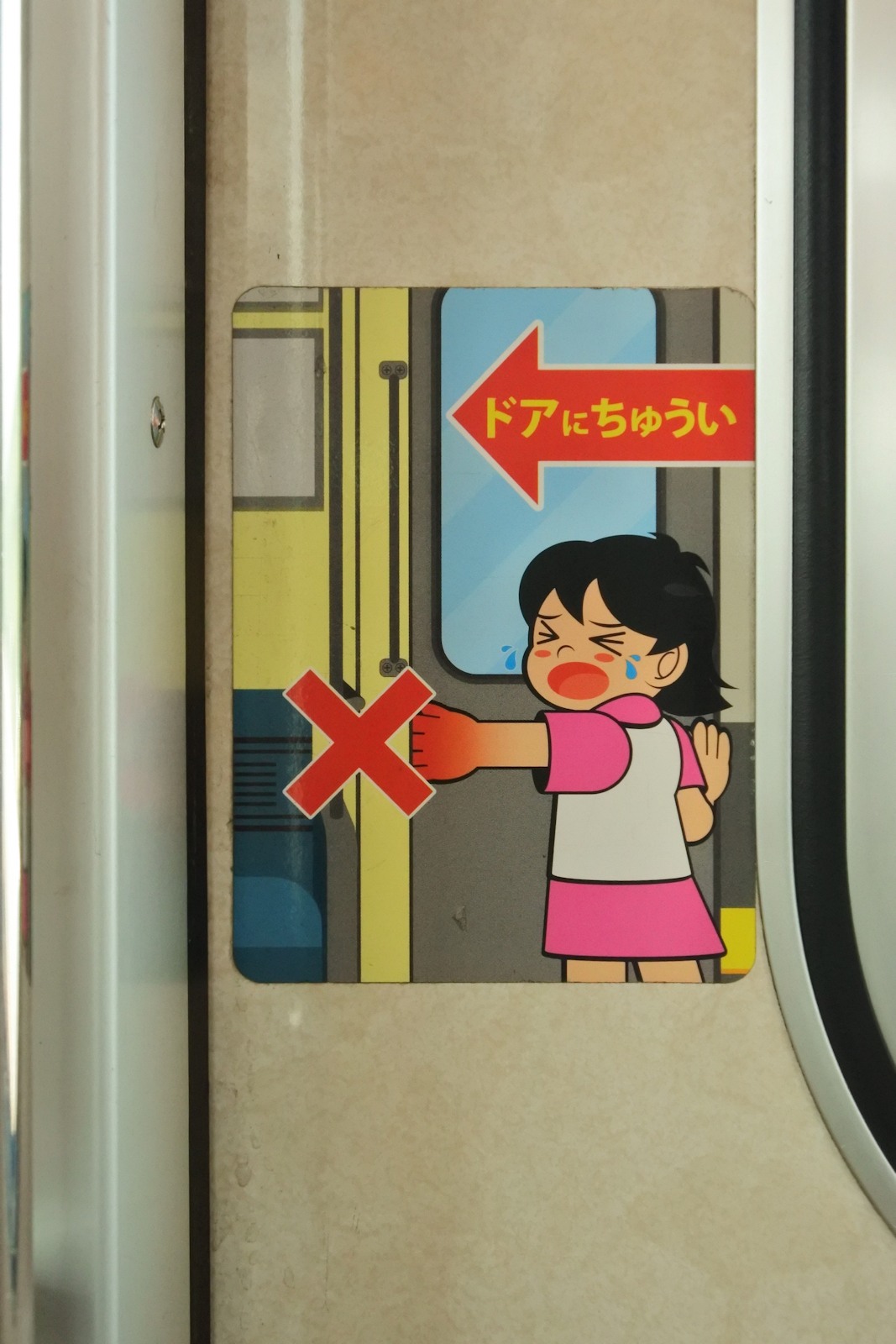
"地下鉄のお嬢ちゃん"ステッカーの魅力
2011(平成23)年より大阪市交通局(現在の大阪市高速電気軌道(Osaka Metro))の車両の側扉戸尻に貼り付けている"地下鉄のお嬢ちゃん"の引き込まれ注意ステッカー。鉄道事業者の個性を出す要素の1つと言える引き込まれ注意ステッカーの中で、僕が最も気に入っているものである。その理由はただかわいらしい絵柄だからだけではない。引き込まれ事故の被害者の多くを占める9歳以下の子供に伝わりやすいように数多くの工夫を凝らしたデザインと言えるからである。ステッカーは戸袋に近い戸尻のガラス底辺のR付近に貼り付けることで、乗車している子供たちの視界に自然に入ってくるように配慮されている。注意書きも「ドアにちゅうい」と全文ひらがな・カタカナのみを使って表記されている。絵柄は、引き込まれの被害に遭いやすい子供たちと同年代(おおむね幼稚園児か小学校低学年)程度の女の子のキャラクターを主役として描くことで共感を呼びやすくし、彼女の手を引き込まれ、ケガを負って泣いている姿を見ることで、引き込まれ事故の恐ろしさを彼らに、特に言葉や文字の理解力が未熟な子供たちにも、絵だけを見ても解ってもらえるようなものと言える。引き込まれた手が赤く腫れ上がっていることで、より痛みが伝わりやすくなる効果があるのであろう。改善すべき点を1つ挙げると、ステッカーの大きさの制約から難しいかもしれないが、側扉に「触らない」ように注意書きすることで、より丁寧に伝えられるのではないだろうか。しかし、それを補うように、お嬢ちゃんの引き込まれている左手だけでなく、引き込まれていない右手も側扉に触っているように描かれている。これによって、側扉に触っていると危ないということが、文字で説明しなくても絵を見て解るように工夫しているのかもしれない。そして、“地下鉄のお嬢ちゃん”のステッカーは本来のターゲットである子供だけでなく、大人をも魅了する可能性を秘めていると言えるだろう。誰が言ったか知らないが、「日本人は子供に弱い」とよく言われる。“地下鉄のお嬢ちゃん”のステッカーはその心理を巧みに利用しているとも言える。幼い子供は、その場にいるだけで可愛がりたい、見守っていたいと思えてくる存在だろう。ましてやケガをして泣いている子供を見捨てられるわけがないだろう。“地下鉄のお嬢ちゃん”を見ることで、彼女を助けてあげたい、慰めてあげたいという弱き者に対する優しさを覚えたり、それについて考えさせてくれる効果もあるのではないだろうか。“地下鉄のお嬢ちゃん”のステッカーは本来のターゲットである子供たちに引き込まれ事故の危険さを理解してもらえやすいだけでなく、大人の保護欲を掻き立てるイラストであると言ってよいだろう。その結果、多くの人に伝わりやすく、親しみを持ってもらえるような、引き込まれ注意ステッカーのあるべきデザインを示していると言える。僕もこれまでに、数多くの鉄道事業者の引き込まれ注意ステッカーを見てきたが、その多くが手のみが描かれたものであり、子供心ながらに何を伝えたいものなのか解らなかった。僕が子供だった頃、人差し指を戸袋方向に向けた手の絵柄の西武鉄道や京王電鉄のものを見ても、人差し指を向いている方向へ側扉が開くということは理解できたが、側扉に手をついていると開く時に扉と一緒に手も戸袋に吸い込まれるから危ないということまでは想像できなかった。それから時が流れて、僕もいつの間にか“地下鉄のお嬢ちゃん”くらいの歳の娘がいてもおかしくない年齢になってしまった。お嬢ちゃんを見ていると、なんだか娘を見守る父親のような気持ちにさせられる。そして、もしも僕に娘がいて、列車の乗り方を教える時には、その娘に側扉に手をつくと危ないということを教えるために、“地下鉄のお嬢ちゃん”のステッカーを見せるだろう。“地下鉄のお嬢ちゃん”は、子供たちにとっては友達のような存在であり、大人にとっては娘のような存在のキャラクターなのかもしれない。最後に改めて、自ら体を張って引き込まれ事故の恐ろしさを伝えようとする“地下鉄のお嬢ちゃん”と、“地下鉄のお嬢ちゃん”を描いてくれた当時の大阪市交通局の皆さんに、深い感謝の気持ちを表したい。I want to write about a mind-the-doors sign on the passenger doors of Osaka Metro carriages, in which "Osaka Subway Girl" whose left hand caught into the door pocket appears, has been shown since 2011.In my opinion, the design of the sign shows one of the ways to express railway companies' identity. Among them, Osaka Metro's one is the best design because it has many ideas to make passengers, especially children under nine years old, understand how horrible holding the doors is, the cute design.The sign is placed at the height of Children's, almost the same as the bottom of the windows on the doors, and Japanese text is written in only hiragana and katakana to be easy to read them. If they can't understand the words, they can do through the picture. A girl similar in age to them, especially primary-school-age or younger who account for much of the victims of the accident, makes them achieve a sense of affinity and draw their sympathy to beware of and avoid injury to hand or finger as the doors open. The inflammation of her hand makes them do how her hand hurt.I want to say that the sign needs the massage for passengers not to touch or hold on to the doors directly. However, her right hand also touches on the door to cover the lack of message.From my perspective, the sign can also be well-designed to attract not only the children but adults, which feed off the psychology of ordinary Japanese people going easy on little children.Some people say that little children make adults feel caring for them if they aren't their sons or daughters. If he or she is crying and getting injured, most adults can't ignore him or her.The sign also shows how the mind-the-doors sign should be to make it understandable and beloved by many people. An injured girl evokes passengers to learn their kindness to help or comfort her.I have seen many varieties of mind-the-doors signs of railway companies in Japan since I was little. However, I used to feel that it was difficult to understand what the signs said only the fingers pointing to the door pocket say.About 30 years later, it is no wonder that I have a child or children in the almost same age as "Osaka Subway Girl". Watching "Osaka Subway Girl" in the sign, I feel as if I were her father. If I had children and taught them the behaviour on the train, I would show them this well-designed sticker to avoid their injury."Osaka Subway Girl" maybe like a friend for the children and as a daughter for adults.Finally, I want to thank an illustrator for the well-designed sign.
Sep 7, 2019
コメント(0)
-

東急に「鉄道むすめ」がいない理由は「なでしこ銘柄」だから?
東京急行電鉄株式会社。日本の「資本主義経済の父」であり、2024(令和6)年より発行予定の新しい一万円札の肖像にも採用されることが決まっている渋沢栄一さんが現在の東京都大田区・世田谷区・目黒区での住宅の開発・販売を目的に設立した田園都市株式会社の鉄道部門を分社化した目黒蒲田電鉄に端を発し、現在の目黒線と東急多摩川線にあたる目蒲線目黒駅~丸子駅(現在の沼部駅)を1923(大正12)年に開通させ、営業を開始した。2019(令和元)年現在では、東横線・目黒線・東急多摩川線・大井町線・田園都市線・池上線・こどもの国線(線路等の施設は横浜高速鉄道所有)・世田谷線の8路線を営業している。来る2019(令和元)年9月2日には母体となった田園都市株式会社が設立101周年(東京急行電鉄の直接の前身である目黒蒲田電鉄の設立からは97周年)を迎え、社名を「東急株式会社」へと改め、鉄道事業を新設子会社の「東急電鉄株式会社」へと分社化する。田園都市株式会社という不動産会社を母体に誕生した経緯を持つことから、鉄道を主力事業とする大手民鉄各社とは性格が異なり、「土地開発の一部として鉄道を営業する」という理念を持っている。自社で開発した住宅地の住民以外にも乗客を恒久的に確保するために、沿線の宅地開発だけでなく、沿線に東京工業大学(大田区大岡山)、慶應義塾大学(横浜市日吉)、東京学芸大学(世田谷区下馬町 現在は小金井市に移転)、東京都立大学(目黒区八雲 現在の首都大学東京、八王子市に移転)など大学の校舎の誘致も積極的に進めた。戦後は神奈川県川崎市・横浜市・大和市、および東京都町田市にまたがる広大な住宅地、「多摩田園都市」を造成し、田園都市線を開通させるという、田園都市株式会社・目黒蒲田電鉄時代よりもさらに大規模な宅地開発に着手した。近年では渋谷ヒカリエや二子玉川ライズなどの商業ビル・オフィスビルの開発にも力を入れている。そんな東京急行電鉄は一方で、首都圏の大手民鉄では京浜急行電鉄と共に、トミーテックに「鉄道むすめ」のキャラクターを作ってもらっていない鉄道事業者でもある。東急グループの会社である伊豆急行や上田電鉄、元グループ会社の東急車輛製造(現在の総合車両製作所)は「鉄道むすめ」のキャラクターが存在するが、東京急行電鉄には存在しない。長年僕は東京急行電鉄が「鉄道むすめ」に参加しない理由を探っていたが、東京急行電鉄が女性の社会進出に積極的であり、「なでしこ銘柄」の1社であることがその理由の1つではないかとみられるのではないだろうか。「なでしこ銘柄」とは、経済産業省と東京証券取引所が共同で選定する、女性の活躍推進に優れた東証1部上場企業のこと。鉄道事業者としては、東京急行電鉄が唯一選定されており、2012(平成24)年より7年連続で選定された。東京急行電鉄は1988(昭和63)年より女性総合職の、2001(平成13)年より鉄道現業での女性正社員の採用を開始した。さらには2018(平成30)年版会社案内では、女性活躍推進法に基づく行動計画目標として、「女性管理職の登用について、2020(令和2)年度までに、2014(平成26)年度比較倍増」という目標を達成することを掲げている。「鉄道むすめ」のキャラクターを作ってもらった鉄道事業者でも、女性駅員・乗務員が1人もいない例が少なくないとも聞く。社外のキャラクターを頼って女性社員が活躍しているように見せかけるのではなく、自社努力で現実に女性社員が働く現場を提供することで、東京急行電鉄は「鉄道むすめ」への不参加の意思表示をしているのであろうとも見て取れる。2005(平成17)年のキャラクター展開のスタートから2010(平成22)年頃トミーテックのWebサイトで実施されていた「鉄道むすめキャラクター人気投票」に、「今後『鉄道むすめ』キャラクターが登場してほしい鉄道事業者」を書く欄があり、僕は何度もそこに「東京急行電鉄」と書き続けていた。長年スルッとKANSAI協議会加盟各社(PiTaPaが利用可能な事業者)が密かに不参加の意思を表明していたようだが、2013(平成25)年の京阪電気鉄道に始まり、泉北高速鉄道、大阪高速鉄道、水間鉄道の各社が相次いで取材に協力、キャラクターが制作されている。このことから、「最後の牙城」と言える事業者は、関東民鉄の雄、東京急行電鉄なのかもしれない。Tokyu Corporation was established as Meguro Kamata Railway, which was separated from Den-en-toshi Company, a residential developer in Den-en-chofu in Ota-ku and Setagaya-ku, Senzoku in Meguro-ku, Ookayama in Ota-ku, Tokyo, established by Eiichi Shibuysawa, who is appearing on the redesigned JPY 10,000 bill, to build and manage the railway (present Meguro Line and Tokyu Tamagawa Line) between Meguro Station and Maruko Station (present Numabe Station). The company has been built and managed eight railway lines, Toyoko Line, Meguro Line, Tokyu Tamagawa Line, Oimachi Line, Den-en-toshi Line, Ikegami Line, Kodomonokuni Line (its infrastructure and carriages are owned by Yokohama Minatomirai Railway), and Setagaya Line. Tokyu Corporation is spinning off its railway business into a newly-established separate company, Tokyu Railways, on September 2nd, 2019, the day marking 97th anniversary of the establishment and 101 anniversary of that of the ancestor of the company.Because of the unique history, start as the residential developer, Tokyu Corporation has a different management philosophy from the other major railway companies in Japan that the company manages the railway as a part of the infrastructures in the city. Not only residential development, but the company had invited campuses of Tokyo Institute of Technology (Ookayama, Ota-ku, Tokyo), Keio University (Hiyoshi, Yokohama City, Kanagawa Prefecture), Tokyo Gakugei University (Shimouma, Setagaya-ku, Tokyo, moved to Koganei City, Tokyo in the present), Tokyo Metropolitan University (Yakumo, Meguro-ku, Tokyo, moved to Hachioji City, Tokyo in the present) to gather more passengers not only citizens living in the self-developed residential areas. After World War Two, the company has developed a larger residential development in Kawasaki City, Yokohama City, and Yamato City in Kanagawa Prefecture and Machida City in Tokyo Metropolitan Area and had built Den-en-toshi Line. In recent years, the company also pours its efforts for constructing office and shopping buildings such as Shibuya Hikarie and Futako-tamagawa Rise.However, Tokyu Corporation hasn't collaborated with Tomytec to create a "Tetsudou-musume" character together with Keikyu Corporation among the major railway companies in Kanto Area.As searching why Tokyu Corporation hasn't collaborated with Tomytec, I found that Tokyu Corporation has been awarded as a "Nadeshiko Brand", one of the companies with a positive attitude toward providing the good workplace environment for female employees, by Ministry of Economy, Trade, and Industry and Tokyo Stock Exchange. Among the railway companies, only Tokyu Corporation has been listed for seven years since 2012. Since 1988, Tokyu Corporation has recruited women workers and they have been on railway business since 2001. According to the brochure of company prospectus, Tokyu Corporation achieves a plan for doubling the headcount of women manager by 2020 compared with that in 2014. Because I heard that several railway companies collaborated with Tomytec employ or recruit no women railway staffs, I see that "Nadeshiko Brand" may be one of the reasons that a "Tetsudou-musume" character on Tokyu Corporation has yet to be unrealised to show its attitude not to rely on an external character.Between 2005 and 2010, I had filled in the name of Tokyu Corporation many times in the brank for the railway companies to collaborated with Tomytec on online questionnaires.For many years, it had been said that the railway companies in Kansai Area that Surutto KANSAI stored fare card and PiTaPa smartcard are available hadn't collaborated with Tomytec, but since 2013, Keihan Electric Railway, Semboku Rapid Railway, Osaka Monorail, and Mizuma Railwayhas collaborated and "Tetsudou-musume" characters are created. Because of that, Tokyu Corporation must be the last stronghold for Tomytec creating "Tetsudou-musume" characters.
Aug 4, 2019
コメント(0)
-
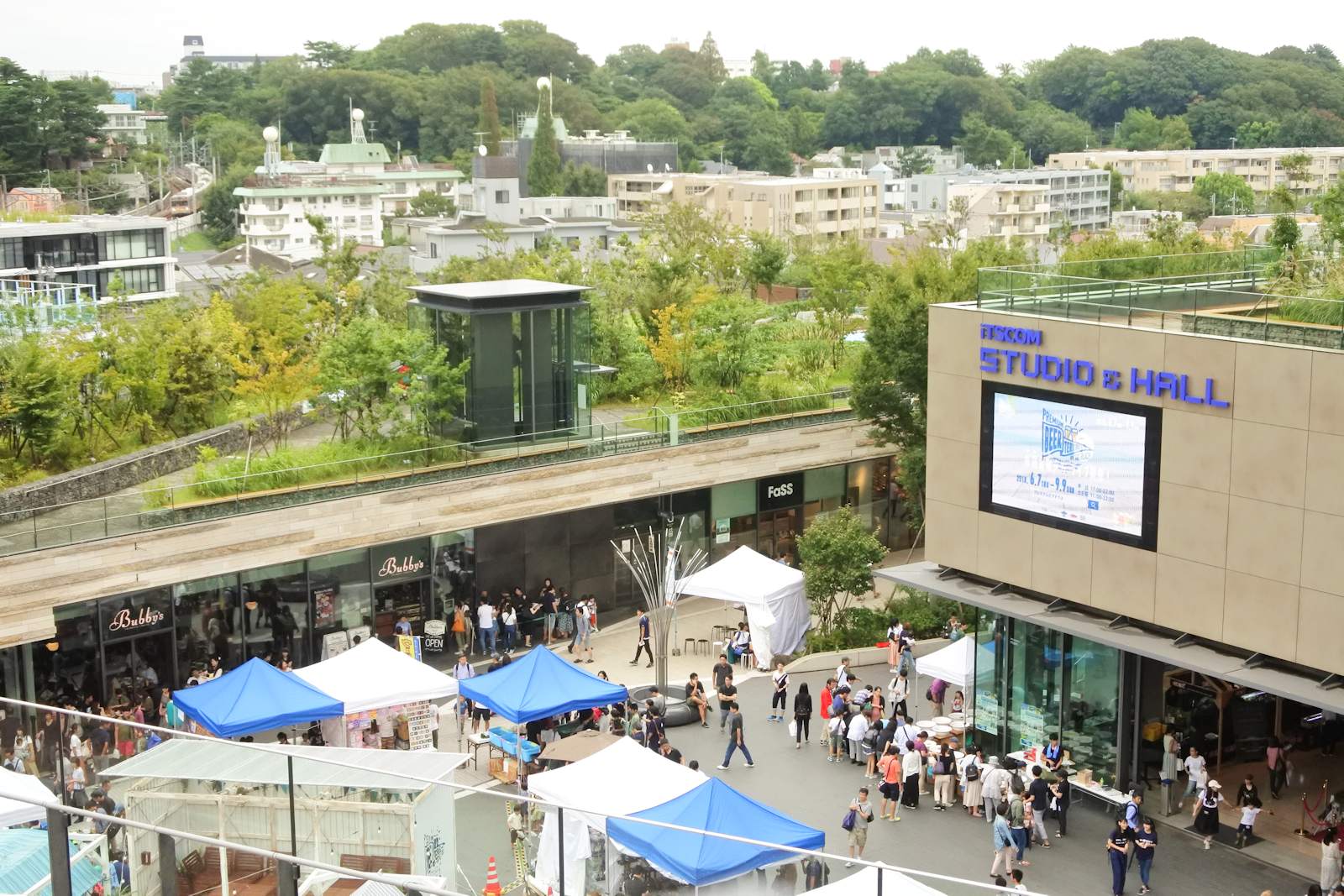
2019年9月に鉄道事業を分社化へ 東急グループの会社再編を見る
3月27日、東京急行電鉄が母体となった田園都市株式会社の設立から101周年(直接の前身である目黒蒲田電鉄の会社設立からは97周年)を迎える2019(令和元)年9月2日付けで、「東急株式会社」(英語名:Tokyu Corporation(現行と変わらず))に社名を変更、同時に同社から鉄道・軌道事業を引き継ぐ新設子会社の社名が「東急電鉄株式会社」(英語名:Tokyu Railways)に決定したと発表した。同社が鉄道・軌道事業の分社化を発表したのは2018(平成30)年9月12日のこと。同日付けで発表された「会社分割による鉄道事業の分社化に関するお知らせ」と題されたIR情報によると、同日に開催された取締役会において、2019(令和元)年9月を目途に鉄道・軌道事業の分社化に向けての準備を開始することが決議された。さらに同じ9月12日付けで発表された「機構改革に関するお知らせ」と題されたプレスリリースによると、2018(平成30)年10月1日付けで「サステナブル戦略推進委員会」を新設し、前出の鉄道・軌道事業と並んで鉄道・軌道事業以外の各事業についても今後の在り方が検討される見込みであるという。東京急行電鉄から社名を変更する東急株式会社は2019(令和元)年9月の鉄道・軌道事業の分社化後は、残る不動産開発事業と資産ポートフォリオマネジメント事業などその他の事業を担う事業持株会社となる。僕は以前から、東急グループの会社再編はいずれ行われると予測していた。2018(平成30)年時点の東急グループは、東京急行電鉄を中心に、同社の傘下にグループ各社が収まる体制を採っている。すなわち、東京急行電鉄は鉄道事業者でありながら、伊豆急ホールディングス、イッツ・コミュニケーションズ、東急百貨店(100%子会社の一部のみ記載)などの東急グループ各社の株式所有・統括も行っていた事業持株会社なのである。鉄道事業においては、新たに設立する子会社(東急電鉄株式会社)への分社化に伴う事業免許の移動(例として、阪急阪神ホールディングス(旧・阪急電鉄)から阪急電鉄(旧・阪急電鉄分割準備)への移動など)が国土交通大臣の認可を受ければ可能であるが、不動産事業は既存会社の事業免許を新会社に譲渡することができず、新会社が新たに免許を取得する必要がある。不動産事業を東急電鉄に引き継がせなかった理由はこういったこともあるのであろう。東急グループにおいては、東京急行電鉄と東急不動産の2社が不動産開発事業を担っているが、東京急行電鉄の鉄道路線沿線(多摩田園都市・渋谷など)のものは東京急行電鉄が自社で、都心部のものは東急不動産が担うように棲み分けがなされているが、両社で重複する事業が存在することにややこしさを覚えていた。さらには小売部門においては、東急百貨店・東急ストアは東京急行電鉄の子会社であるが、東急ハンズは東急不動産ホールディングスの子会社(東京急行電鉄から見ると孫会社)であり、これらの会社の関係も複雑なものになっている。前述の通り、東急株式会社は不動産開発事業・その他の事業についても今後の在り方が検討される見込みである。これらの事業についても分社化やグループ会社への事業譲渡により、東急株式会社の純粋持株会社化の可能性も十分にあり得ると言えるだろう。鉄道事業分社化を皮切りに、大掛かりな東急グループの会社再編が行われるものであると、僕は見ている。同社が担ってきた不動産事業は次回の免許切れ(2021(令和3)年11月19日(国土交通省 建設業者・宅建業者等企業情報検索システム調べ))をもって廃業とし、東急不動産に集約される可能性もあるであろう。新社名について言えば、長年同社は「東急グループ」というブランドに強いこだわりを持っていただけに、東京急行電鉄株式会社は「東急グループ株式会社」もしくは「東急グループホールディングス株式会社」といったものに社名変更され、そして新設される鉄道事業子会社が新たに「東京急行電鉄株式会社」の社名を同社から引き継ぐであろうと予想していたが、「東急株式会社」と「東急電鉄株式会社」という、僕の予想とは違う結果になった。3月27日付けのプレスリリースによると、「東急株式会社」という新社名には、「持続的成長を牽引する中核として、事業分野を超えた会社間の連携促進による新たな付加価値の創出を担う」「東急グループ全体の代表企業として、東急グループの持続的成長を主導する」という思いが込められているようである。そして、2006(平成18)年より東京急行電鉄の略称として使われてきた「東急電鉄」という言葉が、「東急電鉄株式会社」の誕生で正式な鉄道事業者名として採用される。それまでの略称・愛称が正式な社名に採用される例は、近年では株式会社ゆりかもめ(旧・東京臨海新交通株式会社)、万葉線株式会社(加越能鉄道株式会社(現・加越能バス株式会社)から鉄道・起動事業を引き継ぎ)、流鉄株式会社(旧・総武流山電鉄株式会社)などがある。1942(昭和17)年に東京横浜電鉄、小田原急行鉄道(小田急電鉄および京王井の頭線の前身)、京浜電気鉄道(京浜急行電鉄の前身)の合併(後に京王電気軌道(京王電鉄の前身)、神中鉄道(相模鉄道の前身)も合併)によって誕生し、長年、僕も含めて多くの鉄道ファンに親しまれた東京急行電鉄という社名がなくなることに、僕は残念な気持ちを隠せないでいるが、この先も東急株式会社を中心とする東急グループの事業再編を今後も見守っていきたい。On March 29th, Tokyu Corporation announced that a newly-established branch company which inherits its railway business on September 2nd, 2019, was named "Tokyu Railways".The inheritance was already announced on September 12th, 2018. According to a piece of IR information on that day, a board meeting had been held and the demerging its railway business from Tokyu Corporation itself resulted. Moreover, a press release on that day says that a new commission for promotion of sustainable administrative strategy had been established to consider its development business and portfolio management business as well as the railway business for the future.I had expected that Tokyu Corporation would plan and begin the process of reconstruction of branch companies .In the present, Tokyu Corporation functions as not only a railway company, but also as a holding company of many Tokyu Group companies, such as Izukyu Holdings (holding company of Izukyu Corporation), Its Communications, and Tokyu Department Store (part of wholly-owned companies), etc. Though Tokyu Corporation is transferring railway business to the newly-built branch company, it is keeping running development business after the transfer of the railway business because the transferring the license of railway business is available by permission of Ministry of Land, Infrastructure, Transport and Tourism, but that for real estate business can't other companies.In Tokyu Group companies, not only Tokyu Corporation, but also Tokyu Land Corporation function as the land development companies. Tokyu Corporation mainly undertakes the business along Tokyu Line, but Tokyu Land Corporation mainly in Tokyo Metropolitan Area. However, some joint project by the two exists, which bothers me to understand how the two separates.Moreover, among the retailing business, Tokyu Department Store and Tokyu Store are the branch companies of Tokyu Corporation, but Tokyu Hands is that of Tokyu Fudosan Holdings, which also holds the whole stock of Tokyu Land Corporation. It looks also an little complexed.As writing before, Tokyu Corporation also announced that it must be considering how its development business and portfolio management business as well as the railway business exist or manage. I would like to say that it means Tokyu Corporation can transfer the two businesses to its branch companies and can be becoming pure holding company. I see that Tokyu Corporation lost the license of the land development business until the next expiration to concentrate the business to Tokyu Land Corporation.Speaking of the company name, I expected that Tokyu Corporation changes its name to "Tokyu Group" or "Tokyu Group Holdings" before the announcement because Tokyu Corporation have had a strong brand of "Tokyu Group", and the name of "Tokyu Corporation" would be inherited by the newly-established railway company.According to the press release on March 27th, the name of "Tokyu Corporation" has a wish for sustainable growth and promotion of cooperation between the two or more the companies of Tokyu Group companies.I want to keep watching the growth of Tokyu Corporation and Tokyu Group companies.東京急行電鉄 IR情報 『会社分割による鉄道事業の分社化に関するお知らせ』 2018年9月12日東京急行電鉄 プレスリリース 『機構改革に関するお知らせ』 2018年9月12日東京急行電鉄 プレスリリース 『商号変更および定款一部変更、子会社(鉄道事業の分社化に向けた分割準備会社)の設立に関するお知らせ』 2019年3月27日東洋経済ONLINE 『なぜ今?東急が鉄道を「分社化」する真の狙い』 2018年9月13日東洋経済ONLINE 『東急電鉄が社名変更、電鉄を外して「東急」だけ』 2019年3月27日
Apr 1, 2019
コメント(0)
-

4月25日を忘れない
4月25日はJR西日本にとっての「鉄道安全の日」である。言うまでもなく、国鉄民営化後最大の死者・負傷者を出した大事故、「尼崎事故」が発生した日である。2005(平成17)年4月25日、9時18分、JR西日本福知山線(JR宝塚線)塚口駅~尼崎駅間を走行していたJR東西線・片町線(学研都市線)経由同志社前行き快速列車5418M(207系電車Z16編成+S18編成の7両編成)が横転・脱線し、乗客106人と高見隆二郎運転士(享年23)が死亡、562人が負傷した。なお、運輸安全委員会の報告書によると、事故で死亡した高見運転士は2004(平成16)年5月に甲種電気車運転免許(鉄道車両のうち電車を運転するのに必要な免許)を取得したばかりの新人運転士であった。現場は尼崎駅から塚口方へ約1.8km進んだ旧尼崎市場駅跡地付近の半径(R)304mのカーブ。事故当日、5418M列車は尼崎駅の1つ手前の停車駅であった伊丹駅で所定停止位置を40mオーバーランし、所定ダイヤよりも1分~2分遅れて運行していた。遅れを取り戻すために列車は本来の走行速度よりも速い速度で走行し、塚口駅通過時点で、所定ダイヤよりも1分20秒遅れであった。現場カーブの制限速度は70km/hであったが、5418M列車は現場に制限速度を大幅に超える116km/hで突入した。尼崎方から1両目(クハ207-17)はカーブの外側に放り出されるように横転し、沿線に立つマンション1階に突っ込んだ。続く2両目(モハ207-31)、3両目(モハ206-17)、4両目(クハ206-129)も線路から大きく脱線。5両目(クモハ207-1033)の台車も4軸とも脱線した。進行方向前方半分がマンション1階の機械式駐車場に突っ込んだ1両目は、後方半分も側面が後続車両に押し潰されてぺしゃんこに変形して大破した。続く2両目も横転して屋根からマンションの外壁に衝突した後、後続の車両に押しつぶされてマンションの外壁に巻き付くようにしてぺしゃんこに変形した。3両目と4両目は両車の側面が接触し重なるようにして線路を塞ぐようにして止まった。この時、反対の下り線には現場に向かって特急「『北近畿』3号」(列車番号「3013M」 183系電車 「北近畿」は2011(平成23)年に「こうのとり」に改称)が接近していたが、不幸中の幸いで、下り線を塞ぐようにして停車した4両目が下り線線路を短絡(信号機が前方に列車がいると感知)し、現場付近の信号機を停止信号に変えたと同時に、現場付近の踏切で異常を知らせる特殊信号発光機が作動したことから、「『北近畿』3号」は現場の約130m手前で停止。5418M列車との衝突を免れた。事故原因については、直接の原因である列車の速度超過に加えて、速度超過を抑止する対策として速度制限区間手前で強制的に制限速度まで減速させるATS-Pが福知山線に整備されていなかったこと、他路線との接続やアーバンネットワーク特有の阪急電車など民鉄各社との競合を理由としてダイヤに余裕がなかったことなどの設備面に起因するもの、前述の余裕のないダイヤを一因として伊丹駅でのオーバーランによる遅れを取り戻そうと(5418M列車は尼崎駅で東海道本線(JR神戸線)の列車と接続する予定だったことから他路線にまで遅れが波及しないように)するために通常よりも速い速度での運転を強いられたことや、オーバーランや人身事故を引き起こした運転士に対して数日間業務から外してレポートや反省文を書かせる「日勤教育」と呼ばれる懲戒処分を受けることへのプレッシャーや恐怖心という運転士の心理面やJR西日本独自の企業風土に起因するものなど、間接的な原因も複数あったとみられる。事故後、ATS-Pの設置など安全対策を怠り尼崎事故を発生させた責任を問われて、井手正敬元会長、南谷昌二郎元会長、垣内剛元社長のJR西日本の歴代社長3人が業務上過失致死傷罪で検察審査会によって強制起訴されたが、2017(平成29)年に最高裁判所で上告を棄却し、無罪が確定した。被災した車両のうち、Z16編成4両は乗客の救出作業の最中に現場で解体(事故廃車)された。S18編成3両は事故の証拠物件として、Z16編成の台車とともに兵庫県警に押収され、当時のJR西日本の経営陣の事故に対する責任を問う裁判で使われた。S18編成は2011(平成23)年2月1日に“釈放”されたものの、営業運転には復帰させず、JR西日本は乗務員への安全教育の資料としての活用を目指しているという。去る2018(平成30)年3月27日、僕は約10年ぶりに現場を訪れ、尼崎事故で犠牲になった107人と4両に祈りを捧げてきた。現場では、被災したマンション周辺を「祈りの杜 福知山線列車事故現場」という名の慰霊碑が立つ公園として保存するために向けての工事が進行中だった。9階建てだったマンションは1両目が突っ込んだ1階を含む4階までの部分を残して解体され、屋根で覆われる形で保存される予定となっている。僕が現場を訪れた時、207系電車体質改善リニューアル車による木津行き快速列車5504Mが通過した。この列車も「尼崎事故」で被災した5418M列車と同じ、福知山線(JR宝塚線)・JR東西線・片町線(学研都市線)を運行するものである。尼崎事故で犠牲になった107人と4両を忘れることなく、日本に限らず世界中の鉄道が安全に走り続けることを祈って、毎年この日を迎えている。April 25th is the railway safety day of JR West's because of Amagasaki Rail Crash in 2005.In Amagasaki Rail Crash, a 7-car rapid train given a number and a code "5418M" from Takarazuka Station on Fukuchiyama Line (JR Takarazuka Line) to Doshisha-mae [Doshisha University Kyotanabe Campus] Station via JR Tozai Line and Katamachi Line (Gakkentoshi Line) operated by 207 Series derailed and crashed into the ground/first floor of a flat/an apartment building between Tsukaguchi Station and Amagasaki Station on Fukuchiyama Line (JR Takarazuka Line), which killed 106 passengers and a driver, Ryujiro Takami, who got the qualification of train driver (for EMU) in 2004, according to the report by Japan Transport Safety Board, and injured 562 passengers.Where the crash happened is a curve with radius of 304 metres/997.38 feet located at about 1.8-kilometre/1.12-mile along the railway from Amagasaki Station. On that day, the train ran a couple of minutes behind the schedule because of an overrun at Itami Station and at faster speed to recover from delay. When passing at Tsukaguchi Station, the train delayed one minute and twenty seconds. The maximum speed at the curve was 70-kilometre/43.5-mile per hour, but the train entered at 116-kilometre/72.08-mile per hour.The first car (Kuha 207-17) overturned leftward and went into the ground/first floor of the flat/apartment building. The second car (Moha 207-31), third car (Moha 206-17), and forth car (Kuha 206-129) deviated from track. The fifth car (Kumoha 207-1033) also derailed.The rear half of the first car became flattened crushed up by the following cars. The second car also overturned, crashed into the wall of the flat/apartment building from its roof, and also became flattened and winded itself around the flat/apartment building. The the third car and fourth car spun, side of the two faced each other, and blocked the railway.When the crash happened, a limited express train "Kita-kinki" (coded "3013M", operated by 183 Series, "Kita-kinki" would be renamed to "Kounotori" in 2011) ran on the opposite track and was approaching to the accident site, but it stopped at 130 metre/426.51 feet before the accident site because a derailed car (4th car), which blocked the opposite track, of 5418M train made a signal on the opposite track turn red and a emergency stop alarm at a crossing near the site worked.Not only the overspeed, absence of ATS-P, the safety device that makes trains mechanically decelerate to the allowed speed, tight schedule caused by connection between the trains on the other lines and the competition between the other railway company, such as Hankyu Corporation, and driver's stress and fear of delay on the other lines, which was caused by waiting for his train, and disciplinary action for drivers who failed their driving and made them write an essay repenting their misdeed and make a report could cause the accident. After the accident, three successive president of JR West, Masataka Ide, Shojiro Nanya, and Takeshi Kakiuchi, were called to account for prevention of the accident and were indicted for professional negligence by Committees for the Inquest of Prosecution, but the judgement ended in a not-guilty verdict in 2017.Among the damaged seven cars, all four cars of Z16 set including the one went into the flat/apartment building were scrapped during rescue. S18 set were confiscated by the police as evidence, together with the broken bogies and axles of Z16 set's. S18 set was returned to JR West in 2011, but the company made S18 set restart its regular operation and have a plan to be used as the educational material to teach the railway safety to drivers. On March 27th, 2018, I visited the accident site to pray for the 107 victims and four scrapped cars. There, the construction for partial preserve of the flat/apartment building as a remain is undergoing. Though the fourth/fifth floor and taller of the 9-storied flat/apartment building are scrapped, the third/fourth floor and lower is covered by a roof and the land next to the flat/apartment building is also being prepared as a park, at which the monument to the crash.When I visited there, a rapid train "5504M" bound for Kizu Station, which also runs from Fukuchiyama Line (JR Takarazuka Line) to Katamachi Line (Gakkentoshi Line) via JR Tozai Line like old 5418M, operated by refurbished 207 Series passed.I always remember the crash and wish the railways all over the world can run safely.参考文献 Reference「福知山線脱線事故・事故調査報告書」 運輸安全委員会 2007年6月28日「福知山線脱線事故・事故調査報告書 添付資料目次 付図1~7」「福知山線脱線事故・事故調査報告書 添付資料目次 付図8~13」「福知山線脱線事故・事故調査報告書 添付資料目次 付図14~18」「福知山線脱線事故・事故調査報告書 添付資料目次 付図19~36」「福知山線脱線事故・事故調査報告書 添付資料目次 付図37~70」「福知山線脱線事故・事故調査報告書 添付資料目次 付図71~77」「鉄道ジャーナル」2005年7月号『福知山線脱線事故の問題を語る』永瀬和彦「JR福知山線列車事故検証報告書」 兵庫県 2006年1月18日「福知山線列車脱線事故の鉄道事故調査報告書に対する取り組み」JR西日本毎日新聞 「【写真特集】福知山線脱線10年:「風化させぬ」…尼崎で慰霊式」2015年4月25日毎日新聞 「JR西・歴代3社長の無罪確定へ」 2017年6月13日東洋経済ONLINE 「「福知山線事故」歴代社長はなぜ無罪だったか」 2017年9月14日産経WEST「事故現場の名称「祈りの杜」に JR西、遺族に提案 福知山線脱線事故」 2018年1月11日「変わる現場、遺族複雑 見るとつらい/JR西は隠したいだけ 進む保存工事、今夏完成」毎日新聞 2018年4月20日
Apr 25, 2018
コメント(0)
-
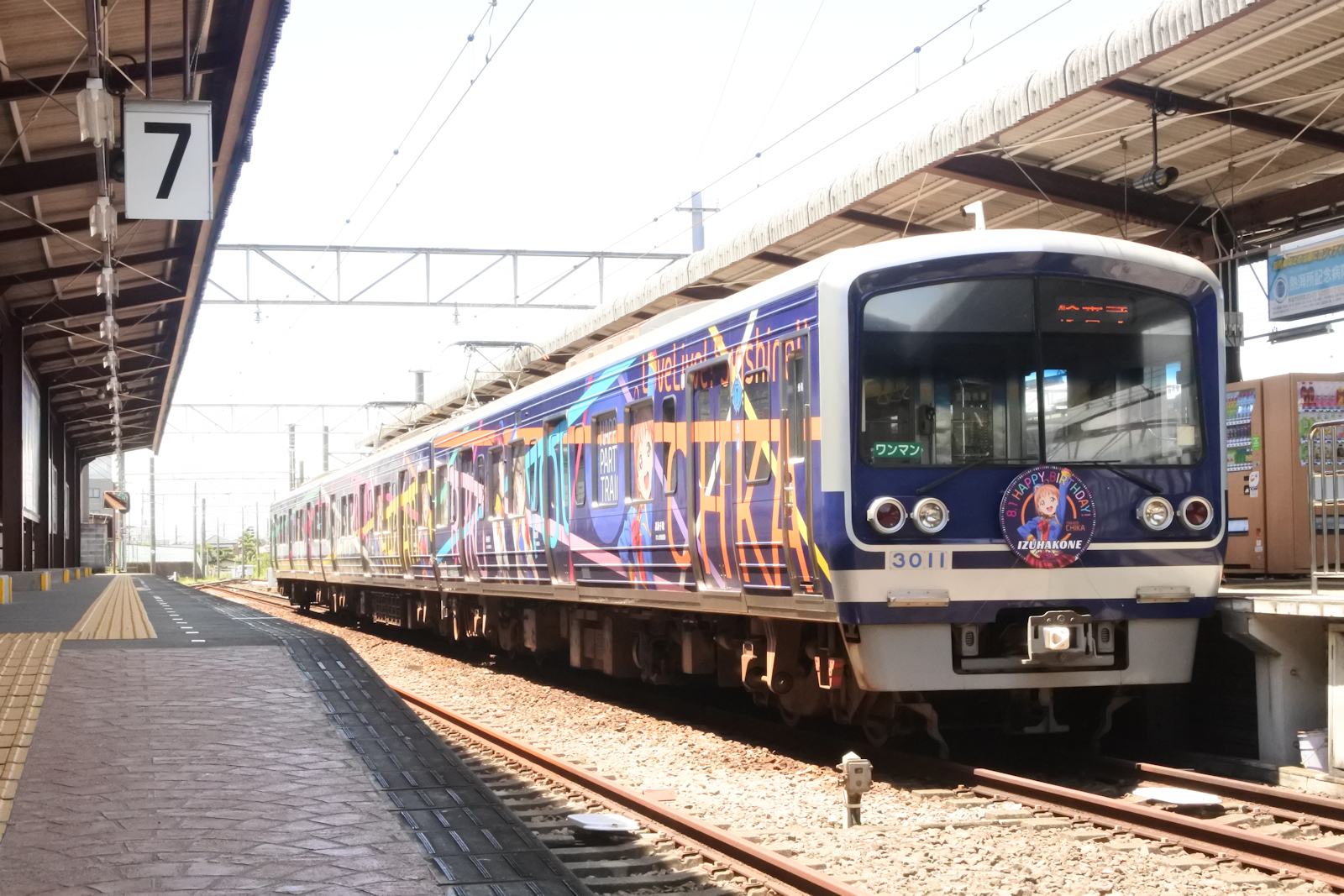
駿豆線にもIC乗車券は必要か
8月5日・6日に伊豆箱根鉄道駿豆線に乗車して不便に感じたことが1つある。それは、Suica・TOICAなどのIC乗車券が使えないという点だ。伊豆長岡駅・修善寺駅の構内にある売店・コンビニエンスストアではSuica・TOICAなどの電子マネー決済に対応しているものの、駿豆線列車の乗車券としてこれらのカードを使うことができないのである。伊豆箱根鉄道の営業エリアは、神奈川県の小田原・箱根エリアと静岡県の伊豆半島(熱海エリアと中伊豆・三島・沼津エリア)に広がる。このうち大雄山線、小田原・箱根エリアおよび熱海エリアの路線バスではIC乗車券が使用できる一方で、駿豆線や中伊豆・三島・沼津エリアの路線バスでは使用できない。今日では、Suica・PASMO・Kitaca・TOICA・manaca・ICOCA・PiTaPa・SUGOCA・nimoca・はやかけんのIC乗車券10種は、複数のエリアに跨いでの利用はできないものの、券種に関係なくこれらの利用可能エリアの鉄道・路線バスの運賃として、またPiTaPaを除く8種は対応店舗の電子マネーとして使えるが、元来は基本的にそれぞれのエリア内のみの利用、もしくはエリアが近接もしくは重複する乗車券との相互利用でしか使えないものだった。このうち、Suica、PASMO、TOICAのエリアを見ていこう。SuicaはJR東日本が発行、同社および東京モノレール・東京臨海高速鉄道の各社が販売するIC乗車券。静岡県内は東海道本線のJR東日本管内と伊東線、伊豆急行の伊豆急行線がSuica首都圏エリアに入る。PASMOは株式会社パスモが発行、関東地方の民鉄・地下鉄・路線バス各社が販売するIC乗車券で、販売を担う各社の路線と、発行当初より相互利用可能なJR東日本のSuica首都圏エリア(東京モノレール・東京臨海高速鉄道・伊豆急行・富士急行各社の路線を含む)での使用を想定して登場した。伊豆箱根鉄道の大雄山線と小田原・箱根エリア、熱海エリアの路線バスもこのPASMOエリアに入る。熱海エリアは静岡県であるものの、東海道本線のJR東日本管内と伊東線がSuica首都圏エリアに入り、それと接続する路線バスであるという理由から、熱海エリアの路線バスにもPASMOが導入されたものとみられる。TOICAはJR東海が発行・販売するIC乗車券。静岡県内では東海道本線のJR東海管内のうち函南駅以西と御殿場線の御殿場駅~沼津駅間、身延線の富士駅~西富士宮駅間がTOICAエリアに入る。一部の民鉄でも導入されているSuicaに対して、TOICAはJR東海の自社路線のみが当初の利用可能エリアとなっており、これらの路線と接続する民鉄各線での使用ができなかった(TOICAエリアと重複する名古屋近郊の民鉄各社はmanacaを導入)。ちなみに伊豆箱根鉄道と同じ静岡県内を営業エリアとする民鉄では、伊豆急行はSuicaを、静岡鉄道はPiTaPaと独自発行のLuLuCaを、遠州鉄道は独自発行のナイスパスを導入している。以上のような経緯から、伊豆箱根鉄道では大雄山線と小田原・箱根エリアおよび熱海エリアの路線バスのみでPASMOを導入し、駿豆線は、PASMOエリアからも、TOICAエリアからも外れてしまい、IC乗車券が使用できない状況が長く続いていると読み取れる。伊豆箱根鉄道はPASMO導入事業者となっていることから、駿豆線と中伊豆・三島・沼津エリアの路線バスに独自発行のIC乗車券を導入することも難しいだろう。2017(平成29)年時点で自動改札機が設置されている駿豆線の駅は三島・三島広小路・三島田町・大場・韮山・伊豆長岡・大仁・修善寺の各駅。それ以外の駅には自動改札機が設置されていないが、簡易改札機を設置することで対応できる。駿豆線のPASMOエリアへの組み込み(IC乗車券導入)も実現させてみてはと提案する。As I wrote before, I went travelling and photographing Izu Hakone Railway Sunzu Line on August 5th and 6th. While travelling, I felt it is inconvenient that passengers can't use rechargeable smart cards, such as Suica, PASMO, TOICA, etc. as the train fare, only available for e-money at convenience stores or kiosks in the stations.Railway and bus network of Izu Hakone Railway spreads in Kanagawa Prefecture and Shizuoka Prefecture; two railway lines, Daiyuzan Line between Odawara Station and Daiyuzan Station in Kanagawa and Sunzu Line between Mishima Station and Shuzenji Station in Shizuoka, and buses in Odawara and Hakone area in Kanagawa and Atami, Mishima, Numazu, and Shuzenji area in Shizuoka. Among those, Daiyuzan Line and buses in Odawara, Hakone, and Atami areas introduce smart cards. However, the cards are still unacceptable on the others in 2017.All of ten major smart cards for train and bus fare in Japan, Suica, PASMO, Kitaca, TOICA, manaca, ICOCA, PiTaPa, SUGOCA, nimoca, and Hayakaken are available in Tokyo, Osaka, Nagoya, Fukuoka, Sendai, Sapporo, Niigata, Toyama, Shizuoka, Okayama, Hiroshima, and cities around those. However, they originally used to be sold for use only in their specified area and neighbouring or overlapping area.Among these, Suica, sold by JR East, and PASMO, sold by PASMO corporation and private railway companies, were for Kanto Area (around Tokyo) and TOICA, sold by JR Central, were for Tokai Area (around Nagoya and Shizuoka). In Shizuoka Prefecture, JR East Tokaido Line (from Tokyo), Ito Line, and Izu Kyuko Line, not a JR East railway line but because of going-through service to/from JR East Tokaido Line and Ito Line, consists of Suica area, Buses in Atami area does of PASMO area, and Tokaido Line further than Kannami, Gotemba Line between Gotemba Station and Numazu Station, and Minobu Line between Fuji Station and Nishi-fujinomiya Station does of TOICA area.Private railway companies in Shizuoka Prefecture haven't had introduced TOICA but consists of the other cards' network, such as Shizuoka Railway does of PiTaPa, and Enshu Railway sells its own card, Nice Pass.In case of Izu Hakone Railway, Sunzu Line and buses in Mishima, Numazu, and central Izu Peninsula area are isolated from PASMO area because it may be unconnected to JR East Lines in Suica area. It also seems to be hard to introduce the companies' own smart card to Sunzu Line because the network of the company consists of a part of PASMO area.In 2017, the stations equipping automatic station gates are Mishima, Mishima-hirokoji, Mishima-tamachi, Daiba, Nirayama, Izu-nagaoka, Ohito, and Shuzenji. However, it must be easy to equip smart card readers to the others. I would like to suggest that smart cards service on Sunzu Line would start.
Sep 17, 2017
コメント(0)
-
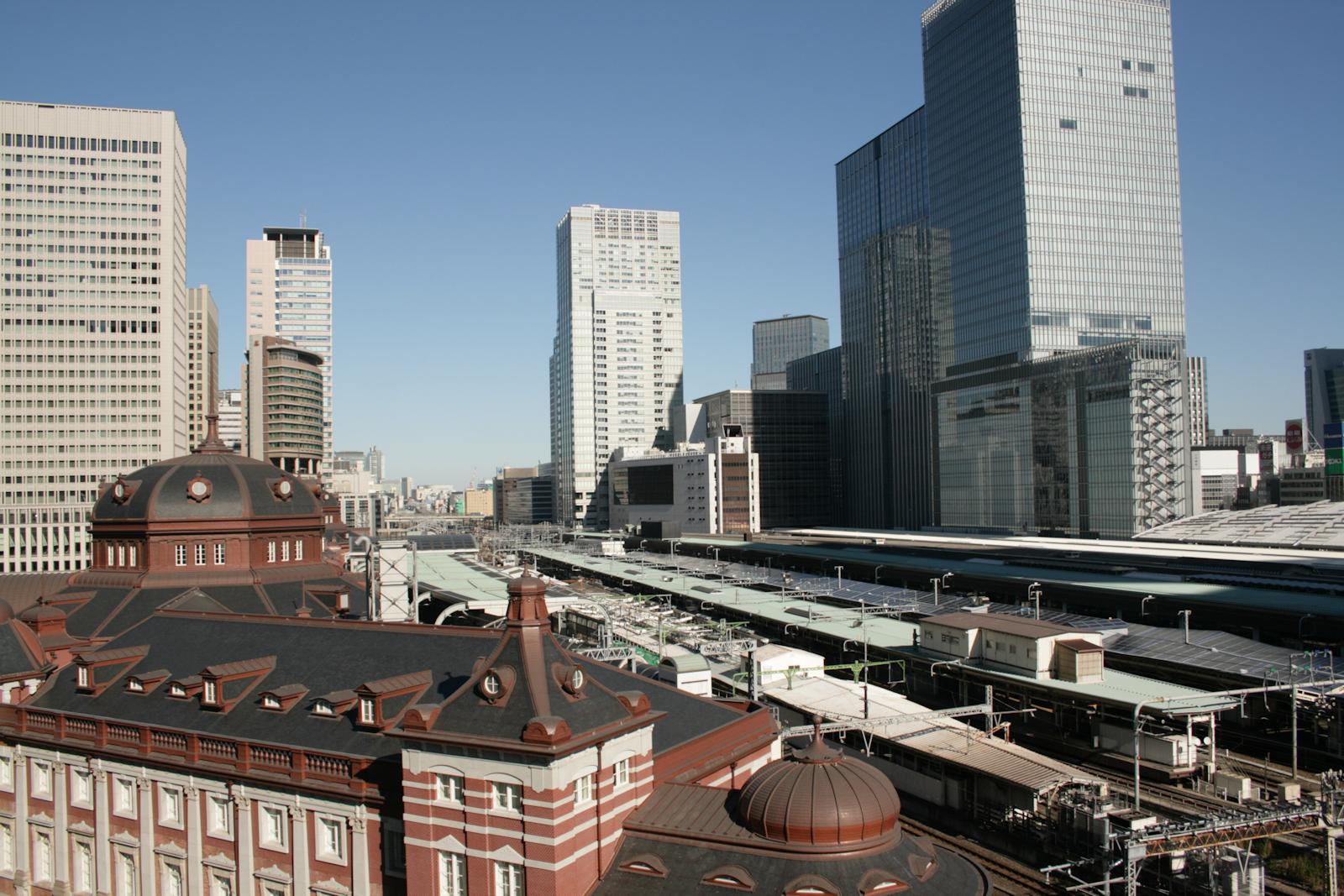
国鉄民営化を再考する
ご存じのとおり、1987(昭和62)年の国鉄民営化から4月1日で30年を迎えた。国鉄民営化についておさらいすると、1949(昭和24)年6月1日に運輸省の鉄道現業部門(旧鉄道省)を独立させる形で、公共企業体(国営企業)として誕生した日本国有鉄道(国鉄)が、1964(昭和39)年度以降の赤字経営に苦しみ続けた結果、最終的に約37兆1000億円もの累積債務を抱え、経営破綻した。債務が膨らんだ原因としては、以下の理由が挙げられる。日本国有鉄道法の条文により鉄道事業とそれに付随する事業以外への進出が規制されていたこと。同じく条文により国会の閣議決定もしくは承認を経なければ予算の執行や運賃の改定、路線の廃止ができなかったこと。公共企業体という独立採算と公共性を両立する立場が政治に利用され、自らの選挙区に国鉄路線を呼び寄せようとする「我田引鉄」思想を持つ国会議員の圧力が強かったこと。日本鉄道建設公団(鉄道建設・運輸施設整備支援機構の前身の1つ)が建設した路線の債務の一方的な押し付け。自動車の普及による貨物輸送の減少。職員の順法闘争や「スト権スト」と呼ばれるストライキなどに代表される労使関係の悪化。人件費、とりわけ退職者に支払われる退職金・共済年金の負担増1987(昭和62)年4月1日、公共企業体(国営企業)であった日本国有鉄道は、北海道・東日本・東海・西日本・四国・九州の旅客6社、日本貨物鉄道(JR貨物)、鉄道総合技術研究所などに分社化、旅客6社とJR貨物については株式会社化、鉄道総合技術研究所は財団法人(のちに公益財団法人)化された。ただし旅客6社とJR貨物は、この段階では旅客鉄道株式会社及び日本貨物鉄道株式会社に関する法律(JR会社法)の監督下による国鉄清算事業団全額出資の特殊会社という扱いであり、正確には株式会社化はされたものの、純然たる民営化ではなかった。その後、1993(平成5)年のJR東日本の東証一部上場に始まり、「本州3社」と呼ばれるJR東日本・JR西日本・JR東海は2005(平成17)年までに、JR九州も2016(平成28)年に株式の売却が完了し、JR会社法の監督下からも離れたことから、名実共に民営化された。国鉄が抱え込んだ巨額の債務のうち25兆5000億円は国鉄清算事業団が引き継ぎ、残りの11兆6000億円のうち、5兆9000億円は本州3社とJR貨物(JR東日本4兆2000億円、JR東海5000億円、JR西日本1兆1000億円、JR貨物1000億円)、鉄道通信(後のソフトバンクモバイル→ソフトバンク)、鉄道情報システム(JRシステム)に、5兆7000億円は民営化当初から1991(平成3)年まで東海道・山陽・東北・上越各新幹線の線路・駅等の資産を引き継ぎ、本州3社に貸し付けていた新幹線鉄道保有機構に債務をそれぞれ引き継がれた。しかし国鉄清算事業団による土地の売却が思うように進まず、1997(平成9)年の国鉄清算事業団解散時には、清算事業団が負担すべき債務は28兆3000億円にまで膨らんだ。この未返済の国鉄債務は政府の一般会計、鉄道建設公団、本州3社に改めて割り振られ、無利子借入金8兆1000億円の返済は政府によって免除された。また、本州3社と比べて経営基盤が弱く、鉄道事業の赤字が想定された「三島会社」と呼ばれるJR北海道・JR四国・JR九州に対しては、国鉄清算事業団(→鉄道建設公団→鉄道建設・運輸施設整備支援機構)が経営安定基金を拠出した。JR各社の誕生と同時に、国鉄の駅構内・列車内の警備・犯罪捜査に当たっていた鉄道公安職員(鉄道公安官)は警視庁および各道府県警察の鉄道警察隊に改組され、JR旅客6社に加えて民鉄各社の駅構内・列車内にも捜査権が拡大された。株式会社化後30年のJR旅客各社の性格を見てみよう。山手線をはじめとする国鉄時代に「国電」と呼ばれた各線を含む東京近郊区間が主力で、駅ナカ店舗の開拓・改装やIC乗車券・電子マネー「Suica」などの新規事業でも成功したJR東日本。東海道新幹線が運賃収入の92%を占め、新幹線のスピードアップと安全性の向上に力を注ぎ、近年はリニア中央新幹線の建設に踏み出した、新幹線優先姿勢のJR東海。民鉄との競合が熾烈な大阪近郊区間(アーバンネットワーク)の輸送改善に力を注いできた一方で、山陽新幹線の300km/h運転を実現させた、在来線と新幹線双方への注力の程よいバランスを保ってきたJR西日本。By Rsa (Own work) [GFDL or CC-BY-SA-3.0], via Wikimedia Commons工業デザイナーの水戸岡鋭治さんが手掛けた個性的なデザインの車両を積極的に投入し、九州新幹線と在来線の“水戸岡デザイン”車両への乗車を目的とした観光客を呼び込むことに成功したJR九州。By Tennen-Gas (Own work) [CC BY-SA 3.0], via Wikimedia CommonsBy Mitsuki-2368 (Own work) [GFDL or CC BY-SA 3.0], via Wikimedia Commonsそして、稼ぎ頭となる路線が存在せず、利用客の減少と資金難に悩むJR北海道とJR四国。上場を達成した本州3社・JR九州とJR北海道・JR四国とで顕著な違いが現れたと言える。それは経営姿勢の面だけでなく財務面でもである。民営化の最大の焦点である国鉄債務の返済が進んでいるかのように見える一方で、民営化によるマイナスの一面も表面化している。より正確に言えば、国鉄民営化だけでなく金融対策のマイナス面である。1990年代のバブル崩壊後の低金利政策は、本州3社の長期負債に対する金利負担を軽くさせた一方で、三島会社に対する経営安定基金の運用益も半減させてしまった。当初の想定では、三島会社に拠出した経営安定基金は、投資・運用して得た利益を鉄道事業の赤字の穴埋めに活用するはずだった。しかし低金利政策により、経営安定基金が想定以下の利益しかもたらさず、三島会社、中でもJR北海道とJR四国にとっては鉄道事業の赤字を補填できなくなってしまい、経営が悪化する事態を招いてしまった(JR九州の経営安定基金は上場時に鉄道建設・運輸施設整備支援機構が所有する九州新幹線の線路使用料と保有施設の帳簿価格の値下げ(減損処理)により消滅)。具体的には、本州3社に引き継がれた債務は、本州3社が新幹線保有機構から新幹線施設を買い取った後の1992(平成4)年度には3社合計で約12兆4000億円(JR東日本約5兆4000億円、JR東海約5兆5000億円、JR西日本約1兆6000億円)あったが、2015(平成27)年度にには3社合計で約6兆2000億円(JR東日本約3兆3000億円、JR東海約1兆9000億円、JR西日本約1兆円)にまで減った(1992(平成4)年度と2015(平成27)年度の長期債務の金額は「週刊ダイヤモンド」2017年3月25日号掲載の数値を100億円の位で四捨五入、合計値が各社の金額と必ずしも合致しない)。また、政府の一般会計へと繰り入れられた債務は1997(平成9)年の約24兆円から、2015(平成27)年には約17兆8000億円にまで、鉄道建設・運輸施設整備支援機構が引き継いだものも鉄道建設公団時代の1997(平成9)年度の約3兆9000億円から2015(平成27)年度には約8543億円にまで残高が減った。一方の経営安定基金は、JR北海道の場合、1987(昭和62)年の会社発足当初は6822億円あった経営安定基金が2011(平成23)年には2200億円が追加され、計9022億円となったものの、運用益は1987(昭和62)年度に498億円を計上したのに対し、2015(平成27)年度は元金が増えたにもかかわらず349億円にまで減ってしまった。2015(平成27)年度の鉄道事業収支は482億円の赤字を計上していることから、これを穴埋めするには経営安定基金の運用益が133億円不足している。また、JR四国も誕生以来鉄道事業が赤字続きであり、1987(昭和62)年当時2082億円の経営安定基金が支給され、2011(平成23)年には1400億円が追加された計3482億円となったが、その運用益は1987(昭和62)年度の151億円から2015(平成27)年度には72億円にまで減った。同社の2015(平成27)年度の鉄道事業収支は109億円の赤字を計上していることから、こちらも37億円足りない。JR北海道は2015(平成27)年度の路線別収支において、すべての路線(北海道新幹線は未開業、江差線は道南いさりび鉄道へ譲渡前)が赤字に陥り、営業係数(100円の収入を得るために必要な投資額を表す数値)も100を超えた。2016(平成28)年に運行路線の半分が会社単独での維持が困難であると、自ら窮地に立たされていることを告白し、北海道や沿線市町村の支援が必要な路線、廃線にして路線バスへの転換が必要な路線をそれぞれ公表した。JR四国も経営安定基金の運用益だけでは本業の赤字を全額補填できなくなったため、沿線自治体に対して、鉄道施設を所有してもらう「公有民営」方式での上下分離経営の導入など、支援の強化を願い出ている。JR北海道とJR四国は株式会社化(両社は2017(平成29)年現在も鉄道建設・運輸施設整備支援機構がすべての株を保有しているため、厳密には民営化したとは言えない)されたため政治の圧力はなくなったものの、「運行路線のすべてもしくはほとんどが赤字経営であるにもかかわらず、公共交通機関として重要な役目を担っている鉄道を簡単にはなくせない」という、両社の鉄道事業者としての採算性と公共性の両立が達成できずにもがき苦しむ姿は、国鉄時代から変わっていないようにも見えてくる。誕生から30年の時を経て、東日本・東海・西日本の本州3社と北海道・四国・九州の三島会社とでの経営地盤の違いが改めて明らかになった。鉄道の面でも地域格差が露呈され、改めて国鉄民営化が成功だったのか、そして今後の鉄道の在り方について、課題を残したと言える。また、国鉄債務の返済についても、政府の一般会計から支出される分の主な財源がたばこ特別税であることから、健康志向の高まりによりたばこの売り上げが減っている時代背景を考慮し、新たな財源を模索することも必要だと考える。(写真は特記以外花見友紀撮影)As I wrote on the other day, seven JR companies marked their 30th anniversary since their inheritance of the business from Japan National Railway on April 1st.Japan National Railway public company, starting its business inheriting from those of Railway Ministry in 1949, had operated at a loss since 1964.What caused those pieces of deficit were regulation of business which JNR was able to ran by Japan National Railway law, agreement of the Diet for financial plan and change of fare, decrease of freight shipment because of replacement by truck, assumption of the debt left by Japan Railway Construction Public Corporation (JRCC, one of the predecessors of Japan Railway Construction, Transport and Technology Agency) on construction of railways which JRCC built, and confliction between managers and employees.Finally, JNR went bankrupt involving total liabilities of 37 trillion 100 billion yen (JPY).JNR was separated into JR railway companies, all of which were converted to joint-stock corporations, which were established based on Business Regulation of JR Companies Act at first and all of whose stocks were held by JNR Settlement Corporation, and Railway Technical Research Institute, which was converted to private foundation and to public interest incorporated foundation in 2011, etc.. JNR Settlement Corporation had gradually sell all of the stocks of JR East, JR Central, and JR West from 1993 to 2005 and those of JR Kyushu in 2016, and these four companies were exempt from the law.Among the large amount of JNR debts, 25 trilion and 500 billion yen was assumed by JNR Settlement Corporation, 5 trillion 900 billion yen was done by JR East (4 trillion 200 billion yen), JR Central (500 billion yen), JR West (1 trillion 100 billion yen), JR Freight (100 billion yen), JR Communications (SoftBank Corp. in the present) , and Railway Information Systems, 5 trillion 700 billion yen was by Shinkansen Holding Corporation, which had existed for holding Shinkansen infrastructures between 1987 and 1991. However, because sale of lands by JNR Settlement Corporation faced difficulty and assumed debt increased to 28 trillion 300 billion yen when the Settlement Corporation was disappeared in 1997. The repayment obligation of the remaining debt of 28 trillion 300 billion yen was allocated by general accounts of Japanese National Diet, JRCC, JR East, JR Central, and JR West anew, and interest-free liabilities of 8 trillion 100 billion yen was absolved by National Diet. In addition JNR Settlement Company gave JR Hokkaido, JR Shikoku, and JR Kyushu, all of which were expected that their business environment was weaker than that of JR East, JR Central, and JR West, subvention for investment to raise money for compensation for the deficit in railway business budget.The outline of 30 years of six JR companies is written as follows.At the same time, JNR domestic security officers who worked at JNR railway stations or trains to guard them and investigate crimes happened at them changed to the railway police of the prefectural Police Department. JR East manages mainly Tokyo area including Yamanote Line, which earns the largest profit since JNR period, and succeeds on other businesses such as refurbishment of the station buildings to create shopping areas, and Suica e-money service. JR Central JR Central, because whose 92% of all income from railway business comes from Tokaido Shinkansen, has struggled to improve the speed-up and safety of Shinkansen and been constructing Chuo Shinkansen using Superconducting Maglev technology to connect between Shinagawa Station and Nagoya Station, which takes 40 minutes.JR West has improved the service in Osaka area, in which the trains has competed between the lines almost in parallel operated by private railway companies, such as Hankyu Corporation, Hanshin Electric Railway, Keihan Electric Railway, and Kintetsu Railway, etc. since JNR period and realised higher-speed operation at 300km/186.411ml per hour on Sanyo Shinkansen.JR Kyushu has aggressively introduce the cars designed by Eiji Mitooka on Kyushu Shinkansen and ordinary lines to create a new style of railway travel enjoying the ride, which succeeds to draw more people in Kyushu.On the other hand, JR Hokkaido and JR Shikoku have no or few profitable lines and are suffering from decrease of passengers and money shortage.Reviewing these 30 years of six JR companies, the change in social conditions brought the huge managerial and economic gap between four listed companies on Tokyo Stock Exchange, JR East, JR Central, JR West, and JR Kyushu and two unlisted companies, JR Hokkaido and JR Shikoku.National low-interest rate policy from 1990s brought JR East, JR Central, and JR West to lighten interest payment for the assumed deficits from JNR, but JR Hokkaido, JR Shikoku, and JR Kyushu to get less returns from invested subvention. Especially, JR Hokkaido and JR Shikoku worsens their income and expenditure on railway business and the returns can't completely compensate the deficit. Assumed deficits had been decreased to about 6 trillion and 200 billion yen (JR East 3 trillion 300 billion yen, JR Central 1 trillion 900 billion yen, JR West 1 trillion yen) in 2016 from about 12 trillion 400 billion yen (JR East 5 trillion 400 billion yen, JR Central 5 trillion 500 billion yen, JR West 1 trillion 600 billion yen) in 1993 after acquirement of Shinkansen infrastructures from Shinkansen Holding Corporation, and those inherited by National Diet had been done to about 17 trillion 800 billion yen in 2016 from 24 trillion yen in 1998 and those inherited by Japan Railway Construction, Transport and Technology Agency (JRTT) had been done to 8543 billion yen from 3 trillion 900 billion yen in 1997 (JRCC on that time).However, the more money for JR Hokkaido and JR Shikoku (6822 billion yen for JR Hokkaido and 2082 billion yen for JR Shikoku were prepared in 1987 and 220 billon yen for JR Hokkaido and 140 billion yen for JR Shikoku were added) were subvended, the less profits (about 50 billion yen in 1987 but about 35 billion yen in 2015 for JR Hokkaido, and 15 billion yen in 1987 but about 7 billion yen in 2015 for JR Shikoku) the two companies can get. JR Hokkaido post a deficit of 48 billion yen, which needs more 13 billion yen to eliminate the deficit on the railway business, and JR Shikoku did that of 11 billion yen, which is about 4 billion yen less than its profits from the railway business and invested subvention. At the end of a business year until March, 2016, JR Hokkaido announced that all of railway lines (Hokkaido Shinkansen didn't open yet and Esashi Line was before cession to Donan Isaribi Railway) went into red and which line needed more help by Hokkaido Prefectural Office and cities or towns along the railway to maintain them and have to discontinue.JR Shikoku is also working on prefectural or city or town offices to introduce new support plan, such as ownership transfer of the railway infrastructures, which would be used by the company for free.Though both JR Hokkaido and JR Shikoku were released from the political pressure, they are suffering from an matter that it isn't easy to close railways functioning as important transportation, though the company is in red, just like in JNR period.Passing 30 years, I see whether the privatisation of JNR succeeded or not and what the railways should be or function has to be discussed, and I also would like to argue that a new money source for the payment by National Diet because the repayable money is mainly earned from cigarette tax but the sales of cigarettes in Japan gradually decrease.(Images are photographed by T. Hanami myself unless otherwise specified)参考文献 References「週刊ダイヤモンド」 2017年3月25日号 ダイヤモンド社「国鉄改革について」 国土交通省「検証 国鉄改革」 一橋大学鉄道研究会 1994年「「国鉄改革」と国鉄清算事業団の評価」 近藤禎夫著 駒澤大學經營學部研究紀要 1995年「鉄道建設・運輸施設整備支援機構 広報パンフレット 国鉄清算事業関係」 2016年版「平成27年度 日本国有鉄道清算事業団の債務等の処理に関する法律に定める施策の実施の状況に関する報告」 国土交通省 2017年2月10日「国(一般会計)に承継された国鉄長期債務残高の推移」 国土交通省「第12回官業民営化等WG・第26回 市場化テストWG 合同WG 配布資料」 内閣府 規制改革・民間開放推進会議 2005(平成17)年10月26日「平成27年度 線区別の収支状況について」 北海道旅客鉄道 2016年11月4日 「北海道旅客鉄道株式会社 平成28年3月期決算公告」 北海道旅客鉄道 2016年5月9日「四国旅客鉄道株式会社 第29期決算公告」 四国旅客鉄道 2016年5月9日「鉄道建設・運輸施設整備支援機構 平成27事業年度 財務諸表 特例業務勘定」 鉄道建設・運輸施設整備支援機構 「JR北海道の経営危機を救う「5つの解決策」」 東洋経済ONLINE 2017年4月2日「民営化30年の明暗、JR北海道とJR四国の苦境」 Newsweek 2017年3月30日ご存じのとおり、1987(昭和62)年の国鉄民営化から4月1日で30年を迎えた。国鉄民営化についておさらいすると、1949(昭和24)年6月1日に運輸省の鉄道現業部門(旧鉄道省)を独立させる形で、公共企業体(国営企業)として誕生した日本国有鉄道(国鉄)が、1964(昭和39)年度以降の赤字経営に苦しみ続けた結果、最終的に約37兆1000億円もの累積債務を抱え、経営破綻した。債務が膨らんだ原因としては、以下の理由が挙げられる。日本国有鉄道法の条文により鉄道事業とそれに付随する事業以外への進出が規制されていたこと。同じく条文により国会の閣議決定もしくは承認を経なければ予算の執行や運賃の改定、路線の廃止ができなかったこと。公共企業体という独立採算と公共性を両立する立場が政治に利用され、自らの選挙区に国鉄路線を呼び寄せようとする「我田引鉄」思想を持つ国会議員の圧力が強かったこと。日本鉄道建設公団(鉄道建設・運輸施設整備支援機構の前身の1つ)が建設した路線の債務の一方的な押し付け。自動車の普及による貨物輸送の減少。職員の順法闘争や「スト権スト」と呼ばれるストライキなどに代表される労使関係の悪化。人件費、とりわけ退職者に支払われる退職金・共済年金の負担増1987(昭和62)年4月1日、公共企業体(国営企業)であった日本国有鉄道は、北海道・東日本・東海・西日本・四国・九州の旅客6社、日本貨物鉄道(JR貨物)、鉄道総合技術研究所などに分社化、旅客6社とJR貨物については株式会社化、鉄道総合技術研究所は財団法人(のちに公益財団法人)化された。ただし旅客6社とJR貨物は、この段階では旅客鉄道株式会社及び日本貨物鉄道株式会社に関する法律(JR会社法)の監督下による国鉄清算事業団全額出資の特殊会社という扱いであり、正確には株式会社化はされたものの、純然たる民営化ではなかった。その後、1993(平成5)年のJR東日本の東証一部上場に始まり、「本州3社」と呼ばれるJR東日本・JR西日本・JR東海は2005(平成17)年までに、JR九州も2016(平成28)年に株式の売却が完了し、JR会社法の監督下からも離れたことから、名実共に民営化された。国鉄が抱え込んだ巨額の債務のうち25兆5000億円は国鉄清算事業団が引き継ぎ、残りの11兆6000億円のうち、5兆9000億円は本州3社とJR貨物(JR東日本4兆2000億円、JR東海5000億円、JR西日本1兆1000億円、JR貨物1000億円)、鉄道通信(後のソフトバンクモバイル→ソフトバンク)、鉄道情報システム(JRシステム)に、5兆7000億円は民営化当初から1991(平成3)年まで東海道・山陽・東北・上越各新幹線の線路・駅等の資産を引き継ぎ、本州3社に貸し付けていた新幹線鉄道保有機構に債務をそれぞれ引き継がれた。しかし国鉄清算事業団による土地の売却が思うように進まず、1997(平成9)年の国鉄清算事業団解散時には、清算事業団が負担すべき債務は28兆3000億円にまで膨らんだ。この未返済の国鉄債務は政府の一般会計、鉄道建設公団、本州3社に改めて割り振られ、無利子借入金8兆1000億円の返済は政府によって免除された。また、本州3社と比べて経営基盤が弱く、鉄道事業の赤字が想定された「三島会社」と呼ばれるJR北海道・JR四国・JR九州に対しては、国鉄清算事業団(→鉄道建設公団→鉄道建設・運輸施設整備支援機構)が経営安定基金を拠出した。JR各社の誕生と同時に、国鉄の駅構内・列車内の警備・犯罪捜査に当たっていた鉄道公安職員(鉄道公安官)は警視庁および各道府県警察の鉄道警察隊に改組され、JR旅客6社に加えて民鉄各社の駅構内・列車内にも捜査権が拡大された。株式会社化後30年のJR旅客各社の性格を見てみよう。山手線をはじめとする国鉄時代に「国電」と呼ばれた各線を含む東京近郊区間が主力で、駅ナカ店舗の開拓・改装やIC乗車券・電子マネー「Suica」などの新規事業でも成功したJR東日本。東海道新幹線が運賃収入の92%を占め、新幹線のスピードアップと安全性の向上に力を注ぎ、近年はリニア中央新幹線の建設に踏み出した、新幹線優先姿勢のJR東海。民鉄との競合が熾烈な大阪近郊区間(アーバンネットワーク)の輸送改善に力を注いできた一方で、山陽新幹線の300km/h運転を実現させた、在来線と新幹線双方への注力の程よいバランスを保ってきたJR西日本。By Rsa (Own work) [GFDL or CC-BY-SA-3.0], via Wikimedia Commons工業デザイナーの水戸岡鋭治さんが手掛けた個性的なデザインの車両を積極的に投入し、九州新幹線と在来線の“水戸岡デザイン”車両への乗車を目的とした観光客を呼び込むことに成功したJR九州。By Tennen-Gas (Own work) [CC BY-SA 3.0], via Wikimedia CommonsBy Mitsuki-2368 (Own work) [GFDL or CC BY-SA 3.0], via Wikimedia Commonsそして、稼ぎ頭となる路線が存在せず、利用客の減少と資金難に悩むJR北海道とJR四国。上場を達成した本州3社・JR九州とJR北海道・JR四国とで顕著な違いが現れたと言える。それは経営姿勢の面だけでなく財務面でもである。民営化の最大の焦点である国鉄債務の返済が進んでいるかのように見える一方で、民営化によるマイナスの一面も表面化している。より正確に言えば、国鉄民営化だけでなく金融対策のマイナス面である。1990年代のバブル崩壊後の低金利政策は、本州3社の長期負債に対する金利負担を軽くさせた一方で、三島会社に対する経営安定基金の運用益も半減させてしまった。当初の想定では、三島会社に拠出した経営安定基金は、投資・運用して得た利益を鉄道事業の赤字の穴埋めに活用するはずだった。しかし低金利政策により、経営安定基金が想定以下の利益しかもたらさず、三島会社、中でもJR北海道とJR四国にとっては鉄道事業の赤字を補填できなくなってしまい、経営が悪化する事態を招いてしまった(JR九州の経営安定基金は上場時に鉄道建設・運輸施設整備支援機構が所有する九州新幹線の線路使用料と保有施設の帳簿価格の値下げ(減損処理)により消滅)。具体的には、本州3社に引き継がれた債務は、本州3社が新幹線保有機構から新幹線施設を買い取った後の1992(平成4)年度には3社合計で約12兆4000億円(JR東日本約5兆4000億円、JR東海約5兆5000億円、JR西日本約1兆6000億円)あったが、2015(平成27)年度にには3社合計で約6兆2000億円(JR東日本約3兆3000億円、JR東海約1兆9000億円、JR西日本約1兆円)にまで減った(1992(平成4)年度と2015(平成27)年度の長期債務の金額は「週刊ダイヤモンド」2017年3月25日号掲載の数値を100億円の位で四捨五入、合計値が各社の金額と必ずしも合致しない)。また、政府の一般会計へと繰り入れられた債務は1997(平成9)年の約24兆円から、2015(平成27)年には約17兆8000億円にまで、鉄道建設・運輸施設整備支援機構が引き継いだものも鉄道建設公団時代の1997(平成9)年度の約3兆9000億円から2015(平成27)年度には約8543億円にまで残高が減った。一方の経営安定基金は、JR北海道の場合、1987(昭和62)年の会社発足当初は6822億円あった経営安定基金が2011(平成23)年には2200億円が追加され、計9022億円となったものの、運用益は1987(昭和62)年度に498億円を計上したのに対し、2015(平成27)年度は元金が増えたにもかかわらず349億円にまで減ってしまった。2015(平成27)年度の鉄道事業収支は482億円の赤字を計上していることから、これを穴埋めするには経営安定基金の運用益が133億円不足している。また、JR四国も誕生以来鉄道事業が赤字続きであり、1987(昭和62)年当時2082億円の経営安定基金が支給され、2011(平成23)年には1400億円が追加された計3482億円となったが、その運用益は1987(昭和62)年度の151億円から2015(平成27)年度には72億円にまで減った。同社の2015(平成27)年度の鉄道事業収支は109億円の赤字を計上していることから、こちらも37億円足りない。JR北海道は2015(平成27)年度の路線別収支において、すべての路線(北海道新幹線は未開業、江差線は道南いさりび鉄道へ譲渡前)が赤字に陥り、営業係数(100円の収入を得るために必要な投資額を表す数値)も100を超えた。2016(平成28)年に運行路線の半分が会社単独での維持が困難であると、自ら窮地に立たされていることを告白し、北海道や沿線市町村の支援が必要な路線、廃線にして路線バスへの転換が必要な路線をそれぞれ公表した。JR四国も経営安定基金の運用益だけでは本業の赤字を全額補填できなくなったため、沿線自治体に対して、鉄道施設を所有してもらう「公有民営」方式での上下分離経営の導入など、支援の強化を願い出ている。JR北海道とJR四国は株式会社化(両社は2017(平成29)年現在も鉄道建設・運輸施設整備支援機構がすべての株を保有しているため、厳密には民営化したとは言えない)されたため政治の圧力はなくなったものの、「運行路線のすべてもしくはほとんどが赤字経営であるにもかかわらず、公共交通機関として重要な役目を担っている鉄道を簡単にはなくせない」という、両社の鉄道事業者としての採算性と公共性の両立が達成できずにもがき苦しむ姿は、国鉄時代から変わっていないようにも見えてくる。誕生から30年の時を経て、東日本・東海・西日本の本州3社と北海道・四国・九州の三島会社とでの経営地盤の違いが改めて明らかになった。鉄道の面でも地域格差が露呈され、改めて国鉄民営化が成功だったのか、そして今後の鉄道の在り方について、課題を残したと言える。また、国鉄債務の返済についても、政府の一般会計から支出される分の主な財源がたばこ特別税であることから、健康志向の高まりによりたばこの売り上げが減っている時代背景を考慮し、新たな財源を模索することも必要だと考える。(写真は特記以外花見友紀撮影)As I wrote on the other day, seven JR companies marked their 30th anniversary since their inheritance of the business from Japan National Railway on April 1st.Japan National Railway public company, starting its business inheriting from those of Railway Ministry in 1949, had operated at a loss since 1964.What caused those pieces of deficit were regulation of business which JNR was able to ran by Japan National Railway law, agreement of the Diet for financial plan and change of fare, decrease of freight shipment because of replacement by truck, assumption of the debt left by Japan Railway Construction Public Corporation (JRCC, one of the predecessors of Japan Railway Construction, Transport and Technology Agency) on construction of railways which JRCC built, and confliction between managers and employees.Finally, JNR went bankrupt involving total liabilities of 37 trillion 100 billion yen (JPY).JNR was separated into JR railway companies, all of which were converted to joint-stock corporations, which were established based on Business Regulation of JR Companies Act at first and all of whose stocks were held by JNR Settlement Corporation, and Railway Technical Research Institute, which was converted to private foundation and to public interest incorporated foundation in 2011, etc.. JNR Settlement Corporation had gradually sell all of the stocks of JR East, JR Central, and JR West from 1993 to 2005 and those of JR Kyushu in 2016, and these four companies were exempt from the law.Among the large amount of JNR debts, 25 trilion and 500 billion yen was assumed by JNR Settlement Corporation, 5 trillion 900 billion yen was done by JR East (4 trillion 200 billion yen), JR Central (500 billion yen), JR West (1 trillion 100 billion yen), JR Freight (100 billion yen), JR Communications (SoftBank Corp. in the present) , and Railway Information Systems, 5 trillion 700 billion yen was by Shinkansen Holding Corporation, which had existed for holding Shinkansen infrastructures between 1987 and 1991. However, because sale of lands by JNR Settlement Corporation faced difficulty and assumed debt increased to 28 trillion 300 billion yen when the Settlement Corporation was disappeared in 1997. The repayment obligation of the remaining debt of 28 trillion 300 billion yen was allocated by general accounts of Japanese National Diet, JRCC, JR East, JR Central, and JR West anew, and interest-free liabilities of 8 trillion 100 billion yen was absolved by National Diet. In addition JNR Settlement Company gave JR Hokkaido, JR Shikoku, and JR Kyushu, all of which were expected that their business environment was weaker than that of JR East, JR Central, and JR West, subvention for investment to raise money for compensation for the deficit in railway business budget.The outline of 30 years of six JR companies is written as follows.At the same time, JNR domestic security officers who worked at JNR railway stations or trains to guard them and investigate crimes happened at them changed to the railway police of the prefectural Police Department. JR East manages mainly Tokyo area including Yamanote Line, which earns the largest profit since JNR period, and succeeds on other businesses such as refurbishment of the station buildings to create shopping areas, and Suica e-money service. JR Central JR Central, because whose 92% of all income from railway business comes from Tokaido Shinkansen, has struggled to improve the speed-up and safety of Shinkansen and been constructing Chuo Shinkansen using Superconducting Maglev technology to connect between Shinagawa Station and Nagoya Station, which takes 40 minutes.JR West has improved the service in Osaka area, in which the trains has competed between the lines almost in parallel operated by private railway companies, such as Hankyu Corporation, Hanshin Electric Railway, Keihan Electric Railway, and Kintetsu Railway, etc. since JNR period and realised higher-speed operation at 300km/186.411ml per hour on Sanyo Shinkansen.JR Kyushu has aggressively introduce the cars designed by Eiji Mitooka on Kyushu Shinkansen and ordinary lines to create a new style of railway travel enjoying the ride, which succeeds to draw more people in Kyushu.On the other hand, JR Hokkaido and JR Shikoku have no or few profitable lines and are suffering from decrease of passengers and money shortage.Reviewing these 30 years of six JR companies, the change in social conditions brought the huge managerial and economic gap between four listed companies on Tokyo Stock Exchange, JR East, JR Central, JR West, and JR Kyushu and two unlisted companies, JR Hokkaido and JR Shikoku.National low-interest rate policy from 1990s brought JR East, JR Central, and JR West to lighten interest payment for the assumed deficits from JNR, but JR Hokkaido, JR Shikoku, and JR Kyushu to get less returns from invested subvention. Especially, JR Hokkaido and JR Shikoku worsens their income and expenditure on railway business and the returns can't completely compensate the deficit. Assumed deficits had been decreased to about 6 trillion and 200 billion yen (JR East 3 trillion 300 billion yen, JR Central 1 trillion 900 billion yen, JR West 1 trillion yen) in 2016 from about 12 trillion 400 billion yen (JR East 5 trillion 400 billion yen, JR Central 5 trillion 500 billion yen, JR West 1 trillion 600 billion yen) in 1993 after acquirement of Shinkansen infrastructures from Shinkansen Holding Corporation, and those inherited by National Diet had been done to about 17 trillion 800 billion yen in 2016 from 24 trillion yen in 1998 and those inherited by Japan Railway Construction, Transport and Technology Agency (JRTT) had been done to 8543 billion yen from 3 trillion 900 billion yen in 1997 (JRCC on that time).However, the more money for JR Hokkaido and JR Shikoku (6822 billion yen for JR Hokkaido and 2082 billion yen for JR Shikoku were prepared in 1987 and 220 billon yen for JR Hokkaido and 140 billion yen for JR Shikoku were added) were subvended, the less profits (about 50 billion yen in 1987 but about 35 billion yen in 2015 for JR Hokkaido, and 15 billion yen in 1987 but about 7 billion yen in 2015 for JR Shikoku) the two companies can get. JR Hokkaido post a deficit of 48 billion yen, which needs more 13 billion yen to eliminate the deficit on the railway business, and JR Shikoku did that of 11 billion yen, which is about 4 billion yen less than its profits from the railway business and invested subvention. At the end of a business year until March, 2016, JR Hokkaido announced that all of railway lines (Hokkaido Shinkansen didn't open yet and Esashi Line was before cession to Donan Isaribi Railway) went into red and which line needed more help by Hokkaido Prefectural Office and cities or towns along the railway to maintain them and have to discontinue.JR Shikoku is also working on prefectural or city or town offices to introduce new support plan, such as ownership transfer of the railway infrastructures, which would be used by the company for free.Though both JR Hokkaido and JR Shikoku were released from the political pressure, they are suffering from an matter that it isn't easy to close railways functioning as important transportation, though the company is in red, just like in JNR period.Passing 30 years, I see whether the privatisation of JNR succeeded or not and what the railways should be or function has to be discussed, and I also would like to argue that a new money source for the payment by National Diet because the repayable money is mainly earned from cigarette tax but the sales of cigarettes in Japan gradually decrease.(Images are photographed by T. Hanami myself unless otherwise specified)参考文献 References「週刊ダイヤモンド」 2017年3月25日号 ダイヤモンド社「国鉄改革について」 国土交通省「検証 国鉄改革」 一橋大学鉄道研究会 1994年「「国鉄改革」と国鉄清算事業団の評価」 近藤禎夫著 駒澤大學經營學部研究紀要 1995年「鉄道建設・運輸施設整備支援機構 広報パンフレット 国鉄清算事業関係」 2016年版「平成27年度 日本国有鉄道清算事業団の債務等の処理に関する法律に定める施策の実施の状況に関する報告」 国土交通省 2017年2月10日「国(一般会計)に承継された国鉄長期債務残高の推移」 国土交通省「第12回官業民営化等WG・第26回 市場化テストWG 合同WG 配布資料」 内閣府 規制改革・民間開放推進会議 2005(平成17)年10月26日「平成27年度 線区別の収支状況について」 北海道旅客鉄道 2016年11月4日 「北海道旅客鉄道株式会社 平成28年3月期決算公告」 北海道旅客鉄道 2016年5月9日「四国旅客鉄道株式会社 第29期決算公告」 四国旅客鉄道 2016年5月9日「鉄道建設・運輸施設整備支援機構 平成27事業年度 財務諸表 特例業務勘定」 鉄道建設・運輸施設整備支援機構 「JR北海道の経営危機を救う「5つの解決策」」 東洋経済ONLINE 2017年4月2日「民営化30年の明暗、JR北海道とJR四国の苦境」 Newsweek 2017年3月30日
Apr 9, 2017
コメント(0)
-
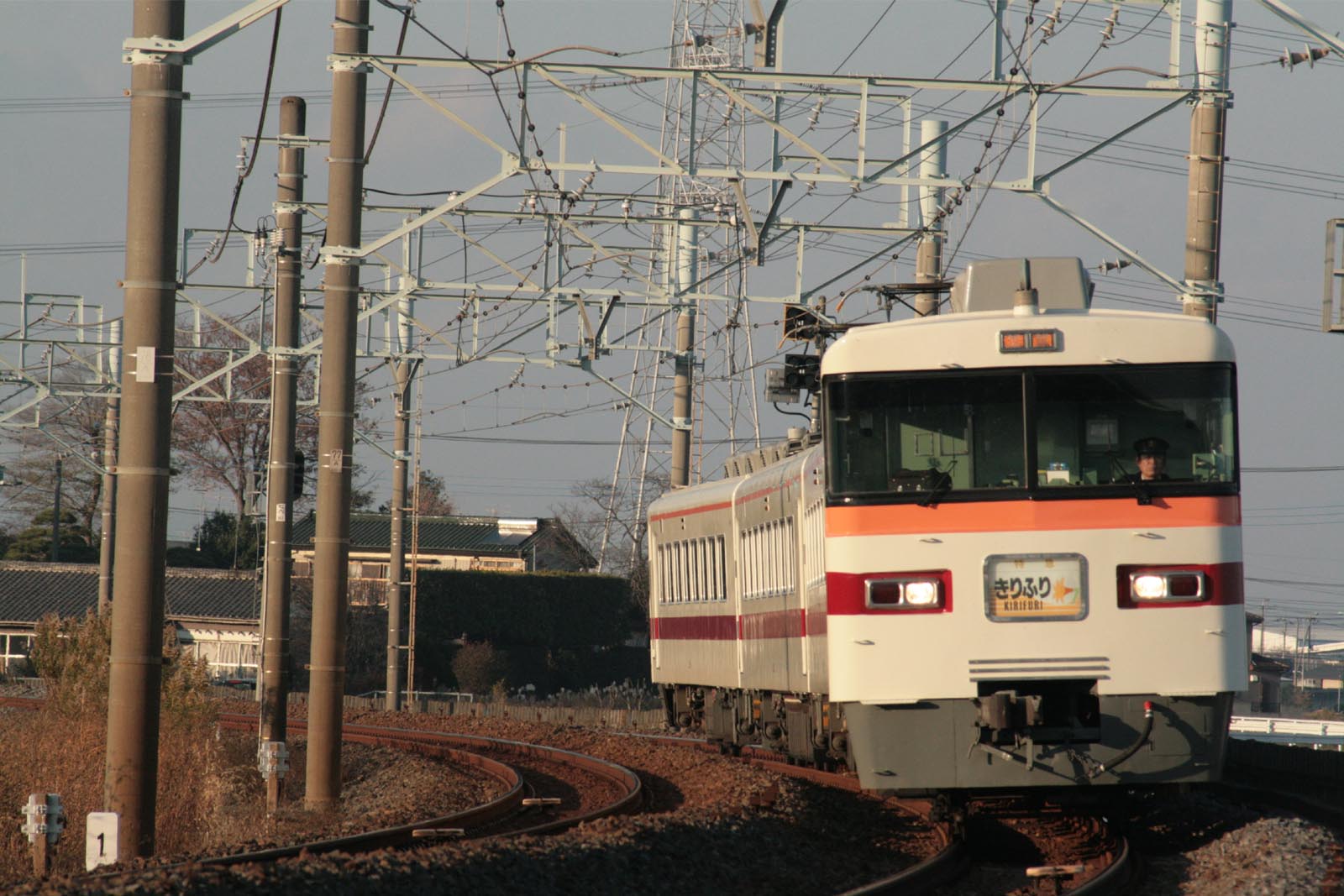
東武特急新ダイヤを見る
1月18日、東武鉄道が来る4月21日に本線系統各線(東武スカイツリーライン・伊勢崎線・日光線・鬼怒川線・野田線等)のダイヤ改正を実施すると発表され、このうち特急列車の変更内容の概要が明らかになった。今回のダイヤ改正の注目ポイントは、新型車両500系「Revaty」がデビューすることと、運行される日が限定されている季節列車の廃止により「きりふり」の定期運行(土休日のみ)が復活すること。まずは新型車両500系「Revaty」を使用して運行される各列車について紹介する。500系「Revaty」で運行される列車は、いずれも新設の浅草駅~会津田島駅の「リバティ会津」、浅草駅~東武日光駅間の「リバティけごん」、浅草駅~鬼怒川温泉駅間の「リバティきぬ」、浅草駅~館林駅間の「リバティりょうもう」、浅草駅~春日部駅間の「スカイツリーライナー」(一部は100系「スペーシア」で運行)、浅草駅~大宮駅・野田市駅間、および大宮駅~運河駅間の「アーバンパークライナー」の各列車。日光線・鬼怒川線系統の「リバティ会津」「リバティけごん」「リバティきぬ」の3列車の浅草駅~下今市駅間は現行の100系「スペーシア」による「けごん」「きぬ」とほぼ同じとうきょうスカイツリー駅・北千住駅・春日部駅・杉戸高野台駅(夕方・夜の2本のみ)・板倉東洋大前駅(朝の1本のみ)・栃木駅・新鹿沼駅・下今市駅に停車。鬼怒川線を走る「リバティ会津」「リバティきぬ」の2列車は、100系「スペーシア」で運行されている「きぬ」が通過していた大谷向駅・大桑駅・小佐越駅にも停車し、野岩鉄道会津鬼怒川線内は男鹿高原駅を除く全駅に全列車が停車(一部列車は男鹿高原駅にも停車)、会津鉄道会津線内は一部列車が会津高原尾瀬口駅~会津田島駅の各駅に停車する。「リバティ会津」は4往復、「リバティきぬ」は浅草行き1本のみ運行され、全列車が浅草駅~下今市駅間で東武日光駅発着の「リバティけごん」と連結する。「リバティりょうもう」は浅草駅~館林駅間で運行される。夜の館林行き1本のみで、浅草駅~東武動物公園駅間は「リバティけごん」と連結する。「スカイツリーライナー」は東武スカイツリーライン内で完結する浅草駅~春日部駅間の通勤客向けの列車で、朝と夕方・夜に運行される。とうきょうスカイツリー駅・北千住駅・せんげん台駅(春日部行きのみ)に停車する。なお「スカイツリーライナー」には500系「Revaty」の他、100系「スペーシア」も使用される。「アーバンパークライナー」は、「東武アーバンパークライン」の愛称を持つ野田線を定期運行する初めての特急列車であり、東武スカイツリーラインから直通の浅草駅発は大宮行きの1号と春日部駅で行き先が2つに別れる3号の2本、野田線内完結の大宮駅発は9号の1本が、平日の夜に運行される。3号は東武スカイツリーライン浅草駅を2編成繋げた6両編成で発車し、春日部駅で3両ずつへの分割(切り離し)を行い、一方は大宮駅へ、もう一方は野田市駅へそれぞれ向かう。停車駅は1号と3号の大宮行きがとうきょうスカイツリー駅・北千住駅・せんげん台駅・春日部駅・八木崎駅・豊春駅・東岩槻駅・岩槻駅に、3号の野田市行きは春日部駅より先、野田市駅までの各駅にそれぞれ停車する。野田線のみを走る大宮駅発運河駅行きの9号は、春日部駅~運河駅の各駅に停車する。一方で300系・350系によって運行される列車群(「しもつけ」「きりふり」「ゆのさと」)についても動きが見られる。朝夜に上下1本ずつ運行されている「しもつけ」はダイヤを変更したうえで運行が継続される。そして300系・350系絡みの注目ポイントは現行ダイヤでは運行日が限定されていた浅草駅~東武日光駅間の「きりふり」が、今回のダイヤ改正により季節列車が廃止されることに伴い、改正後は毎土休日に運行される定期列車に昇格することとなった。夜間に運行されている浅草駅~南栗橋駅間の「きりふり」は「スカイツリーライナー」に置き換わる形で廃止される。また季節列車の廃止と「リバティ会津」の運行開始により「ゆのさと」は廃止される。この他、「りょうもう」の全列車が久喜駅に停車するようになり、平日ダイヤにおいては、浅草駅を18:00以降に発車する「きぬ」「けごん」、「リバティけごん」、「しもつけ」が新たに杉戸高野台駅に停車するようになる。加えて現行ダイヤでは朝の東武日光行き「けごん」1本が停車している板倉東洋大前駅に、夕方の浅草行き「きぬ」1本も停車するようになる。なお板倉東洋大前駅に停車する「けごん」は改正後は「リバティけごん」「リバティ会津」として車両・ダイヤを変更する。これより僕の考察を書き表す。注目の「リバティ会津」については、同じ鬼怒川線方面の「リバティきぬ」と共に、これまで特急列車が通過していた大谷向駅・大桑駅・小佐越駅に停車するようになった理由は、ホームが4両分の長さしかないことから6両編成の100系「スペーシア」が停車できなかった一方で、500系「Revaty」は下今市駅以北を3両編成で運行するためとみられる。野岩鉄道会津鬼怒川線内はほとんどの列車が男鹿高原駅を除くすべての駅に(一部列車は男鹿高原駅にも)停車する。男鹿高原駅に一部列車が停車しない理由は、やはり利用客の少なさが原因であろう。会津鉄道会津線の七ヶ岳登山口駅・会津山村道場駅・会津荒海駅・中荒井駅の各駅が一部列車が停車となっている点については、会津高原尾瀬口駅~会津田島駅間ノンストップの列車と各駅停車の列車があるものと推測される。鬼怒川温泉駅~会津田島駅間に限って見れば、男鹿高原駅・七ヶ岳登山口駅・会津山村道場駅・会津荒海駅・中荒井駅通過というパターンは、会津鉄道の車両(AT-700形・AT-750形)による「AIZUマウントエクスプレス」と同じものである。ちなみにかつて浅草駅~会津田島駅間を運行していた急行「南会津」は下今市駅~会津田島駅間は、新高徳駅・鬼怒川温泉駅・鬼怒川公園駅・新藤原駅・川治温泉駅・湯西川温泉駅・上三依塩原駅(現在の上三依塩原温泉口駅)・会津高原駅(現在の会津高原尾瀬口駅)に停車していた。「リバティ会津」は特急列車でありながら急行「南会津」よりも停車駅が多いということになる。「急行」の種別を東京メトロ半蔵門線・東急田園都市線直通の通勤列車に譲り、「特急」に編入されたことから、単純な比較はできないが、鬼怒川線・会津鬼怒川線・会津線の停車駅を増やすことでより一層の観光客の誘致はもちろんのこと、特急料金が加算されるため快速・区間快速列車および「AIZUマウントエクスプレス」よりも乗車コストが高くなってしまうものの、3線間のみの利用を狙っているのではないかと見ている(2月28日付けの追加情報において、下今市駅~東武日光駅間および下今市駅~会津田島駅間の各駅間のみ「リバティけごん」「リバティきぬ」「リバティ会津」に乗車する場合は、特急券なしでも空席に座れるようになることが発表された)。500系「Revaty」の登場により、東武鉄道の特急型車両としては最高齢の300系・350系の引退が危ぶまれていると見ていたが、今回のダイヤ改正ではなんと運行日が限定された季節列車の廃止による「きりふり」の土休日のみの定期運行復活という願ってもいなかったサプライズが盛り込まれた。「きりふり」の定期列車(土休日のみ)が運行されるのは2001(平成13)年以来16年ぶりのことである。300系・350系に復権の兆しかと言いたいところだが、新造から50年近く、リニューアルからも25年以上の時が経っていることから、「しもつけ」「きりふり」の両列車が500系「Revaty」へ世代交代してもおかしくない(500系「Revaty」は3両編成のため宇都宮線へも入線可能)状況にあることには変わりないと言えることから、300系・350系が近年中に引退する可能性は高い。最後に平日ダイヤにおける夕方・夜時間帯の杉戸高野台駅への停車については、最初はなぜ杉戸高野台駅なのかという疑問が湧いた。改正後は平日夜に運行されている南栗橋行き「きりふり」が廃止となり、幸手駅と南栗橋駅に停車する特急列車がなくなることから、杉戸高野台駅の2面4線のホーム配置を活かして、同駅で特急列車と各停・区間準急・準急・急行列車のいずれかと接続させることで、幸手駅・南栗橋駅への帰宅客を取り込む意図があるのではと見て取れる。On January 12th, Tobu Railway announced that timetable would change on this coming April 21st. As a first piece of information, the new one of limited express trains on Tobu Skytree Line, Isesaki Line, Nikko Line, Kinugawa Line, and Noda Line.The two notable points of this time timetable revision are the debut of newly-built 500 Series "Revaty" and the return of regular operation of "Kirifuri" on Saturdays and holidays.At first, I would like to write about the new trains operated by 500 Series "Revaty". 500 Series "Revaty" is going to run as new six trains, "Revaty Aizu" between Asakusa Station and Aizu-tajima Station on Aizu Railway Aizu Line, "Revaty Kegon" between Asakusa Station and Tobu Nikko Station, "Revaty Kinu" between Asakusa Station and Kinugawa-onsen [Kinugawa Hot Spring] Station, "Revaty Ryomo" between Asakusa Station and Tatebayashi Station, "Skytree Liner" between Asakusa Station and Kasukabe Station, and "URBAN PARK Liner" between Asakusa Station and Omiya Station or Nodashi Station, or between Omiya Station and Unga [Tone Canal] Station.Among these trains, the three going toward Nikko, Kinugawa, or Aizu area stops at almost the same stations as where "Kegon" and "Kinu" limited express trains operated by 100 Series "SPACIA" does, Tokyo Skytree, Kita-senju, Kasukabe, Sugito-takanodai (two operations in the evening only), Itakura-touyoudaimae [Toyo University Itakura Campus] (one operation in the morning only), Tochigi, and Shin-kanuma stations between Asakusa Station and Shimo-imaichi Station.On Kinugawa Line, "Revaty Aizu" and "Revaty Kinu" stops at Daiyamuko Station, Okuwa Station, and Kosagoe Station, where "Kinu" (by "SPACIA") doesn't stop in the present. On Yagan Railway Aizu Kinugawa Line, all of the trains do at stations except Ojika-kogen Station (some of them also stops there). On Aizu Railway Aizu Line, some of them stop at all stations between Aizu-kogen-ozeguchi Station and Aizu-tajima Station, others do at only the two stations."Revaty Aizu" makes four round trips and "Revaty Kinu" does run one way bound for Asakusa Station only one time, and the two are combined with "Revaty Kegon" between Asakusa Station and Shimo-imaichi Station."Revaty Ryomo" operates one-way trip only for Tatebayashi on evening and is combined with ”Revaty Kegon" between Asakusa Station and Tobu-dobutsu-koen [Tobu Zoo] Station."Skytree Liner" runs in the morning and evening and functions as the one for carrying commuters, which stops at TOKYO Skytree Station, Kita-senju Station, and Sengendai Station (only operations for Kasukabe). Not only 500 Series "Revaty", 100 Series "SPACIA" also runs as this train."Urban Park Liner" is the first regular limited express train on Noda Line, which is nicknamed "Tobu Urban Park Line" and has three kinds of routes. The most characteristic route is one of the two trains going through from Tobu Skytree Line; it consists of 6 cars when departing Asakusa Station, but it divided into three and three at Kasukabe Station, and each of the two goes different destination, Omiya Station or Nodashi Station. The other one from Asakusa Station runs to Omiya Station and the last one does between Omiya Station and Unga [Tone Canal] Station. All of them operates on the weekday evening. The ones between Asakusa and Omiya stops at the same stations as "Skytree Liner" on the evening between Asakusa Station and Kasukabe Station and Yagisaki, Toyoharu, Higashi-iwatsuki, and Iwatsuki stations. The one for Nodashi Station after division stops at all stations to the last stop. The one between Omiya and Unga [Tone Canal] stops at Kasukabe and all stations from there.On the other hand, something on the trains operated by 300 Series or 350 Series "Shimotsuke", "Kirifuri", and "Yunosato" also changes."Shimotsuke" limited express serving between Asakusa and Tobu-utsunomiya, both in the morning and evening, continues to serve but its timetable changes.It can be the most notable point that "Kirifuri" limited express between Asakusa and Tobu-nikko, only on stated days mainly in high season in the present, restarts its service on every Saturday, Sunday, and holidays.Two "Kirifuri" on the weekday night between Asakusa and Kaukabe or Minami-kurihashi end their service to be replaced by "Skytree Liner" and, because of discontinuance of on-season trains and debut of "Revaty Aizu", "Yunosato" does its service.As the other changes are that all "Ryomo" limited express serving toward Isesaki Line, Kiryu Line, or Sano Line start to stop at Kuki Station, limited express trains toward Nikko Line departing from Asakusa after 18:00, such as "Kinu", "Kegon" (these two by 100 Series "SPACIA"), "Revaty Kegon", and "Shimotsuke", do at Sugito-takanodai Station, and a "Kinu" does at Itakura-toyodaimae [Toyo University Itakura Campus] ."Revaty Aizu" combined with "Revaty Kegon" stopping at Itakura-toyodaimae [Toyo University Itakura Campus] Station in the morning operates on one hour earlier than "Kegon" (by 100 Series "SPACIA") in the present timetable.From here, I would like to write my opinion, impression, and questions.The first is about "Revaty Aizu" .Between Shimo-imaichi and Aizu-tajima, "Revaty Aizu" stops at the almost same stations as those where "Aizu Mount Express" does. Why "Revaty Aizu" and "Revaty Kinu" stop at Daiyamuko, Okuwa, and Kosagod stations may be the length of platforms of these stations; they are shorter than 6-car 100 Series "SPACIA", but suitable for 3-car 500 Series "Revaty". Why some or few "Revaty Aizu" stops at Ojika-kogen Station on Aizu-kinugawa Line may be the little number of people getting on and off there."Minami-aizu" express, which used to run between Asakusa and Aizu-tajima, stopped at shin-takatoku, Kinugawa-onsen [Kinugawa Hot Spring], Kinugawa-koen [Kinugawa Park], Shin-fujiwara, Kawaji-onsen [Kawaji Hot Spring], Yunishigawa-onsen [Yunishigawa Hot Spring], Kamimiyori-shiobara (present Kamimiyori-shiobara-onsenguchi [Kamimiyori Shiobara Hot Spring]), and Aizu-kogen [present Aizu-kogen-ozeguchi] stations. To stop at more stations than "Minami-aizu" express, it may aim to get more passengers travelling between the stations on Kinugawa Line, Aizu-kinugawa Line, and Aizu Line, though the passengers need limited express ticket. (an additional piece of information on February 28th said that it would be available for people to ride on "Revaty Kegon", "Revaty Kinu", and "Revaty Aizu" without additional fee between Shimo-Imaichi Station and Tobu-nikko Station or Shimo-imaichi Station and Aizu-tajima Station.)The second is about "Kirifuri". I was surprised at the restart of the regular operation of "Kirifuri" on every Saturday, Sunday and holidays. It has passed 16 years since "Kirifuri" discontinued its regular operation. I would like to say that it may be the restore of 300 Series and 350 Series, but these two cars can be replaced by 500 Series "Revaty" in a couple of years because they are built about 50 years ago and refurbished over 25 years ago.When I first heard the news, I wonder why the limited express trains in the evening and night time need to stop at Sugito-takanodai Station.I see it can be a method to keep passengers' convenience that they connect to a local train for passengers going to Satte and Minami-kurihashi stations, where a "Kirifuri" on the weekday night stops and no limited express train does after the revision.東武鉄道プレスリリース 2017年1月18日 『2017年4月21日(金) ダイヤ改正を実施! 東武スカイツリーライン・伊勢崎線・日光線・東武アーバンパークライン 【特急列車概要 】』
Feb 20, 2017
コメント(0)
-
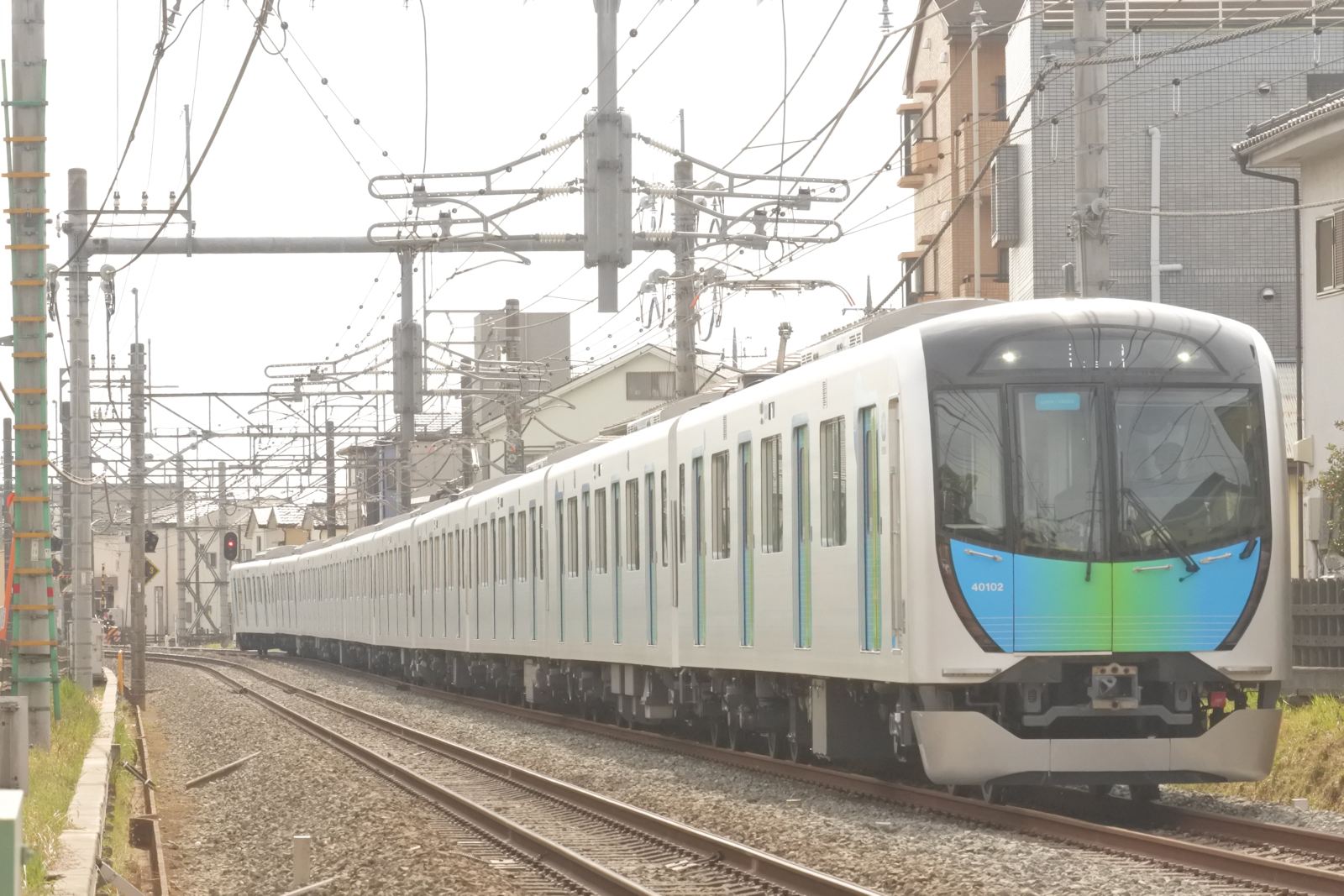
3月25日デビューの西武40000系「S-TRAIN」に対して思うこと
2017(平成29)年期待の新星の1車種、西武40000系が「S-TRAIN」の列車愛称で3月25日にデビューすることが1月10日に西武鉄道と運行各社(東京メトロ・東急電鉄・横浜高速鉄道)から発表された。同時にダイヤと指定席料金も発表され、土休日は元町・中華街駅~所沢駅・飯能駅・西武秩父駅間(西武秩父駅発着・飯能駅発着各1往復、所沢行き北行き1本)、平日は豊洲駅~所沢駅間で運行される。停車駅は、土休日の元町・中華街駅発着列車が、元町・中華街 - みなとみらい - 横浜 - 自由が丘 - 渋谷 - 新宿三丁目 - 副都心線池袋 - 石神井公園- 所沢 - 入間市 - 飯能 - 西武秩父平日の豊洲駅発着列車が、豊洲 - 有楽町 - 飯田橋 - 石神井公園 - 保谷 - 所沢となる。なお、土休日ダイヤでは、横浜駅とみなとみらい駅は南行き(元町・中華街方面行き)の場合は降車専用駅、北行き(所沢・飯能・西武秩父方面行き)の場合は乗車専用駅、副都心線池袋駅は南行き・北行き共に降車専用駅となる。また副都心線内のみの乗車もできない。平日ダイヤでは、東行き(豊洲方面行き)の場合、保谷駅と石神井公園駅が乗車専用駅、飯田橋駅と有楽町駅が降車専用駅となり、西行き(所沢方面行き)の場合はその逆で、有楽町駅と飯田橋駅が乗車専用駅、石神井公園駅と保谷駅が降車専用駅となる。土休日ダイヤでは元町・中華街駅~西武秩父駅間を北行きは2時間14分、南行きは2時間33分で、平日ダイヤでは豊洲駅~所沢駅間を最速58分で結ぶ。指定料金は、主要駅間を見ると、土休日ダイヤの元町・中華街駅および横浜駅から渋谷駅までが350円、副都心線池袋駅までが560円、飯能駅までが860円、西武秩父駅までが1060円、平日ダイヤは東京メトロ有楽町線各駅~池袋線各駅間いずれも510円となる。西武鉄道・東京メトロ・東京急行電鉄・横浜高速鉄道が西武鉄道の新型車両40000系を使用した座席指定列車を西武池袋線~東京メトロ有楽町線、および西武西武秩父線・池袋線~東京メトロ副都心線~東急東横線~横浜高速鉄道みなとみらい線での運行を開始すると発表したは、2016(平成28)6月16日のことだった。西武鉄道では初めてのロング・クロス両用のデュアルシートを備える車両である40000系を投入し、通勤型車両でありながらクロスシート時の特性を活かした座席指定列車としたこと、そしてそれまで追加料金が必要な座席指定もしくは整理券制の列車がなかった東急電鉄と横浜高速鉄道では、他社の車両で運行されるものの初めての座席指定列車が運行されることから、鉄道ファンから大きな注目を集めていた。これより、僕の考察を書き表す。停車駅については、僕はこの発表がある以前から、「S-TRAIN」の停車駅を予想していた。以下に僕の予想を示す。土休日ダイヤ元町・中華街 - 横浜 - (武蔵小杉) - 渋谷 - 新宿三丁目 - 副都心線池袋 - 練馬 - 所沢 - 入間市 - 飯能 - 西武秩父平日ダイヤ新木場 - 豊洲 - 有楽町 - 永田町 - 飯田橋 - 有楽町線池袋 - 練馬 - 所沢 - 入間市 - 飯能最初に土休日ダイヤの副都心線・東横線・みなとみらい線方面の列車については、みなとみらい線・東横線内は横浜高速鉄道と東急電鉄にとっては座席指定列車の運行は初めてであることから、現行の東横線・みなとみらい線の最速列車、東横特急(Fライナー)よりも停車駅が少ないものになると予想していた。僕の予想は、2001(平成13)年に東横特急が運行を開始した当初と同様に、それまで急行が停まっていた、なおかつ東急電鉄にとっては歴史上重要な駅であった田園調布駅や日吉駅を思い切って通過させた前例があることから、今回も思い切って減らした、横浜駅~渋谷駅間ノンストップ、もしくは路線全体のほぼ中間に武蔵小杉駅のみ停車というパターンだったが、結果は途中駅は自由が丘駅のみ停車というものとなった。副都心線内も、急行列車が停車する明治神宮前駅(2008(平成20)年の開業当初は急行列車も明治神宮前駅を通過していた)と、東京メトロと西武鉄道の境界駅である小竹向原駅が通過駅となる点は予想通りだった。池袋線・西武秩父線内の停車駅は、ほぼ特急レッドアロー号のものに準じたものとなることを予想していたが、以前にも書いたとおり、飯能駅~西武秩父駅間の駅で10両分の長さのホームを持つものは飯能駅・東飯能駅・西武秩父駅の3駅だけであることから、池袋駅発の特急レッドアロー号が停車する横瀬駅には10両編成の40000系は停車しないと見ていた点は予想通りであった。反面、西武有楽町線と池袋線で保安装置の違いがあるため、両線の接続駅である練馬駅には停車すると見ていたが、通過駅となり、石神井公園駅に停車するパターンとなった。続いて平日ダイヤの東京メトロ有楽町線方面の列車については、豊洲駅~所沢駅間の運行であるということが予想から大きくずれた。日中に運行される東京メトロ有楽町線直通列車が新木場駅~小手指駅間での運行であるため、それよりも長距離での利用を意識した列車になると予想し、新木場駅~飯能駅での運行を予想していた。東京メトロ有楽町線内の停車駅は、かつて不定期に運行されていた、小田急小田原線・東京メトロ千代田線から東京メトロ有楽町線へ直通していた特急「ベイリゾート」の停車駅も参考にしながら予想したが、駅周辺にオフィス街が広がる飯田橋駅と有楽町駅に停車することは正解だったが、官庁街に近い永田町駅は通過となった。そして、利用客が多い有楽町線池袋駅が通過駅となったという点は、池袋駅の混雑を解消するための施策であると見て取れる。続いて所要時間の点では、元町・中華街駅および横浜駅から池袋駅では、東横特急・副都心線急行(Fライナー)と比べて停車駅が4駅も少ない(「S-TRAIN」は東横特急の停車駅のうち菊名駅、武蔵小杉駅、中目黒駅を、副都心線急行列車の停車駅のうち明治神宮前駅を通過する)にもかかわらず、1分の短縮にしかなっていないうえに、所沢駅もしくは飯能駅まででは、「S-TRAIN」のほうが1分長くなってしまう。「S-TRAIN」が朝と夕方・夜間のみの運行であり、時間帯の違いを考慮しても、停車駅が少ないことを活かせていないと言いたい。3点目は、みなとみらい線内における誤乗対策である。「S-TRAIN」の休日ダイヤの停車駅が東横特急(Fライナー)と同じとなったにも関わらず、みなとみらい線内のみの乗車が南行き・北行き共にできない点に。「S-TRAIN」のみなとみらい線内の停車駅が横浜駅・みなとみらい駅・元町・中華街駅と東横特急(Fライナー)と同じであることから、南行き列車のみを対象に、みなとみらい線内のみを座席指定料金なしで「S-TRAIN」の空席に座れるようにしてはいかがだろうか(当然満席の場合は乗車不可)。南行き列車の場合、自由が丘駅以北からの乗車の場合は横浜駅より先は降車専用でも構わないが、「S-TRAIN」に完全にみなとみらい線内のみの乗車ができなくしてしまうと、指定券のない誤乗が少なからず発生してしまうだろうとみられる。そのため、みなとみらい線内は横浜駅以北からの乗客が減少する一方であることから、東横特急(Fライナー)と停車駅の面で差別化できなかった代償という訳ではないが、みなとみらい線内のみを指定券なしで「S-TRAIN」に乗車できるようにすると、より利便性が向上するのではないだろうか。なお北行き列車はみなとみらい線・東横線から副都心線・池袋線・西武秩父線方面への速達列車という性格が強いことから、前述の特例は設けない。最後に、1つ残る疑問点として、元町・中華街駅発着、豊洲駅発着のどちらも東京メトロと西武鉄道の境界駅である小竹向原駅と、保安装置が違う西武有楽町線と池袋線の接続駅である練馬駅が停車駅とならなかった点である。ということは、土休日ダイヤの副都心線池袋駅~石神井公園駅間、ならびに平日ダイヤの飯田橋駅~石神井公園駅間では、小竹向原駅と練馬駅で2回の運転停車(乗客の乗り降りができない停車)が発生してしまうかもしれないということである。小竹向原駅は東京メトロと西武鉄道の事業者境界駅であるため、同駅で乗務員交代(副都心線からの列車の場合は自動運転から手動運転への切り替えも実施)のための運転停車が実施されるものとみられるが、練馬駅では、西武有楽町線と池袋線で保安装置の違いがあるため、保安装置の切り替えが必要となる。もしも40000系が保安装置の自動切り替えができない場合には、小竹向原駅で乗務員交代と運転モードの切り替え(土休日ダイヤの場合)、練馬駅で保安装置切り替えのための運転停車が立て続けに発生してしまう。そしてこれらの運転停車が、所要時間短縮の大きな壁となっていることだろう。所要時間の短縮には、土休日ダイヤにおける東京メトロ副都心線のうち、池袋駅~小竹向原駅間はATO運転ではなく手動運転とし、車両に保安装置自動切り替え機能を取り付け、小竹向原駅と練馬駅では通過時に保安装置を自動で切り替えられるようにするなどの工夫が必要であると言いたい。確実に着席できるという点では「S-TRAIN」は魅力的な列車と言えるが、現段階では所要時間の短縮が課題と言えよう。東横線・副都心線の最大の課題とも言うべき、JR東日本湘南新宿ラインとの競争で優位に立つには、横浜駅~渋谷駅および池袋駅の所要時間を、今回発表されたダイヤよりもさらに2分程度短縮させる必要があると言いたい。着席保証と所要時間の短縮の2点で「S-TRAIN」の導入効果を得られるのは、現段階ではそれまで直通する全列車が練馬駅~豊洲駅間各駅停車だった東京メトロ有楽町線内にも通過駅がある平日ダイヤと、休日ダイヤではそれまで直通する列車が運行されていなかった元町・中華街駅、みなとみらい駅、横浜駅から西武秩父駅まで乗車した場合に限られるであろう。僕個人の気持ちとしても、停車駅が東横特急(Fライナー)よりも少ないことに過剰な期待を寄せてしまったことを反省している。運行開始時点では、40000系が2編成しか在籍していないため、運行本数が少ない状況となるが、今後40000系が増備され次第、「S-TRAIN」の運行本数も増発され、より利便性の高い列車となることを期待したい。On January 10th, Seibu Railway and relative railway companies, Tokyo Metro, Tokyu Corporation, and Yokohama Minatomirai Railway, announced that a new reserved-seating train named "S-TRAIN", operated by Seibu 40000 Series, would start to run on March 25, 2017, which would run between Seibu-chichibu Station on Seibu Seibu-chichibu Line and Motomachi-chukagai [Motomachi・Yokohama Chinatown] Station on Yokohama Minatomirai Railway Line on Saturdays and holidays, and does between Toyosu Station on Tokyo Metro Yurakucho Line and Tokorozawa Station on Seibu Ikebukuro Line.Reserved-seating charge and timetable were also announced. "S-TRAIN" stops at Motomachi-chukagai [Motomachi・Yokohama Chinatown], Minatomirai, Yokohama, Jiyugaoka, Shibuya, Shinjuku-sanchome, Ikebukuro (on Fukutoshin Line), Shakuji-koen [Shakujii Park], Tokorozawa, Irumashi, Hanno, and Seibu-chichibu Stations in Saturday and holiday service, and Toyosu, Yurakucho, Iidabashi, Shakuji-koen [Shakujii Park], Hoya, Tokorozawa Stations in weekday service.It takes 2 hours and 14 minutes (north bound)/2 hours 33 minutes (south bound) between Motomachi-chukagai [Motomachi・Yokohama Chinatown] and Seibu-chichibu, and it does 58 minutes as the fastest between Toyosu and Tokorozawa. Seating charge costs 350 yen to Shibuya, 560 yen to Ikebukuro, 860 yen to Hanno, and 1060 yen to Seibu-chichibu from Motomachi-chukagai [Motomachi・Yokohama Chinatown] or Yokohama, and 510 yen wholly within the weekday services.Riding only on Fukutoshin Line or Yokohama Minatomirai Railway Line on Saturdays and holidays isn't available.When the press release that a reserved-seating train by Seibu 40000 Series, which was first Seibu Railway car convertible seating between longitudinal and forward-facing, would debut was announced was June 16, 2016. Many railfans paid attention to it because not only reserved-seating commuter train, but it was first train that passengers required an additional charge on Tokyu Corporation and Yokohama Minatomirai Railway.From here, I would like to write my opinion.At first, I would like to treat the stations. Before the stations at which "S-TRAIN" stops were officially announced, I expected which stations "S-TRAIN" stopped. My expectation was as follows.On Saturdays and holidays, Motomachi-chukagai [Motomachi・Yokohama Chinatown], Yokohama, Musashi-kosugi (not all trains), Shibuya, Shinjuku-sanchome, Ikebukuro (on Fukutoshin Line), Nerima, Tokorozawa, Irumashi, Hanno, Seibu-chichibu, and on weekdays, Shin-kiba, Toyosu, Yurakucho, Nagatacho, Iidabashi, Ikebukuro (on Yurakucho Line), Nerima, Tokorozawa, Irumashi, Hanno.On Tokyu Toyoko Line and Yokohama Minatomirai Railway Line, the stations could be less than those of limited express (F-Liner), the fastest train stopping at Motomachi-chukagai [Motomachi・Yokohama Chinatown], Minatomirai, Yokohama, Kikuna, Musashi-kosugi, Jiyugaoka, Nakameguro and Shibuya, which almost comes true. My expectation was no middle station or only one middle station, such as Musashi-kosugi, would stop because limited express train passes Den-en-chofu Station and Hiyoshi Station, both of which are regarded as the most important stations in the history and express train stops. Comparing the result to my expectation, stopping only one middle station is the same, but it is Jiyugaoka.On Fukutoshin Line, it is the completely same as my expectation. Just like Toyoko Line and Yokohama Minatomirai Railway Line, the stations at which "S-TRAIN" stops is less than those of express (F-Liner), which stops at Shibuya, Meiji-jingu-mae [Meiji Jingu Shrine], Shinjuku-sanchome, Ikebukuro, and Kotake-mukaihara; it stops at Shibuya, Shinjuku-sanchome, and Ikebukuro only.On Seibu Yurakucho Line and Ikebukuro Line I expect "S-TRAIN" would stop at the almost same stations as those of limited express "Red Arrow" from Ikebukuro on Ikebukuro Line, but, as I wrote before, 10-car "S-TRAIN" wouldn't stop at Yokoze Station because of the length of platform, which also comes true. On the other hand, Nerima Station doesn't stop (or stops but no passengers can't get on or off). It fell short of my expectation that "S-TRAIN" on weekday would operate between Shin-kiba and Hanno actually to operate between Toyosu and Tokorozawa.I expected that "S-TRAIN" on weekday would operate longer than local train on daytime (between Shin-kiba and Kotesashi) to target passengers going farther than Kotesashi.My expectation which station "S-TRAIN" would stop on Tokyo Metro Yurakucho Line was based on those of "Bay Resort" limited express, which used to operate on Odakyu Odawara Line, Tokyo Metro Chiyoda Line, and Tokyo Metro Yurakucho Line.Comparing to my expectation, Nagatacho Station and Ikebukuro Station aren't chosen.I see why "S-TRAIN" doesn't stop at Ikebukuro Station on Tokyo Metro Yurakucho Line may be to decrease the crowdedness.The second is travel time. Though "S-TRAIN" stops at less stations than limited express ("F-Liner"), it could shorten its travel time only one minute than limited express between Motomachi-chukagai [Motomachi・Yokohama Chinatown] or Yokohama and Ikebukuro and takes more one minute between Motomachi-chukagai [Motomachi・Yokohama Chinatown] or Yokohama and Tokorozawa or Hanno. I would like to say that "S-TRAIN" couldn't fully use its merit.The third is the solution for wrong ride on Yokohama Minatomirai Railway Line.Though it stops at the same stations as limited express (F-Liner) on Yokohama Minatomirai Railway Line, no passengers can ride on south bound "S-TRAIN" only on Yokohama Minatomirai Railway Line, which can make some people confused and cause wrong ride.It may be better to create new rule that passengers could ride on south bound "S-TRAIN" without seat reservation from Yokohama Station or Minatomirai Station because passengers travelling from farther than Jiyugaoka Station gradually decrease from Yokohama Station. The more passengers get off, the more unoccupied seatings there are in the train.At last, I have a question; I wonder how to switch the safety devices or drive mode at Kotake-mukaihara Station, the border of Tokyo Metro Yurakucho Line or Fukutoshin Line and Seibu Yurakucho Line, and Nerima Station, the border of Seibu Yurakucho Line and Ikebukuro Line, both of which "S-TRAIN" passes on timetable, which means that "S-TRAIN" stops twice on its way to Shakuji-koen [Shakujii Park] Station both on Saturdays and holidays and weekdays.At Kotake-mukaihara Station, the trains going through Seibu Yurakucho Line and Ikebukuro Line need to change driver and conductor because of the border between the two railway companies. In addition, in case of Fukutoshin Line trains, the driver changes its driving mode between automatic control to manual control. Though the timetable says that "S-TRAIN" passes Kotake-mukaihara, those both on Saturday and holiday and weekday also has to stop to change them.Not only that, because Seibu Yurakucho Line and Ikebukuro Line introduce different safety devices, though the two lines are operated by the same company, "S-TRAIN" also has to stop at Nerima Station to switch between the two devices if the car doesn't install automatically-switcher for the safety devices."Pass" at Kotake-mukaihara and Nerima can mean that "no passengers can get on and off, in other words, stop only for change of driver and conductor, or switch between different safety devices."It is needed to resolve the stops, such as making a transition from automatic control to manual control between Ikebukuro and Kotake-mukaihara on Fukutoshin Line and equipment of the automatically-switcher with the car."S-TRAIN" looks attractive from the point of view of a train ensuring the seating, but speed-up can be an issue. Especially, to be faster than JR East Shonan-shinjuku Line train between Yokohama and Shibuya or Ikebukuro, more two minute shortening is needed.The travels reaping a benefit "S-TRAIN" may be weekday operation, on which all trains stop at all stations between Nerima and Toyosu, and between Yokohama Minatomirai Railway and Seibu-chichibu Line only.I have to reflect on my overexpectation that the stations where "S-TRAIN" stops are less than limited express (F-Liner) leads the shortening the travelling time.Seibu 40000 Series exists only two sets and "S-TRAIN" operates five times on Saturdays and holidays and seven times on weekdays a day from this coming March 25, but I look forward to being more "S-TRAIN" operates as more Seibu 40000 Series are built.西武鉄道プレスリリース「2017年3月25日(土)から「S-TRAIN」運行開始!」 2017年1月10日
Jan 28, 2017
コメント(0)
-
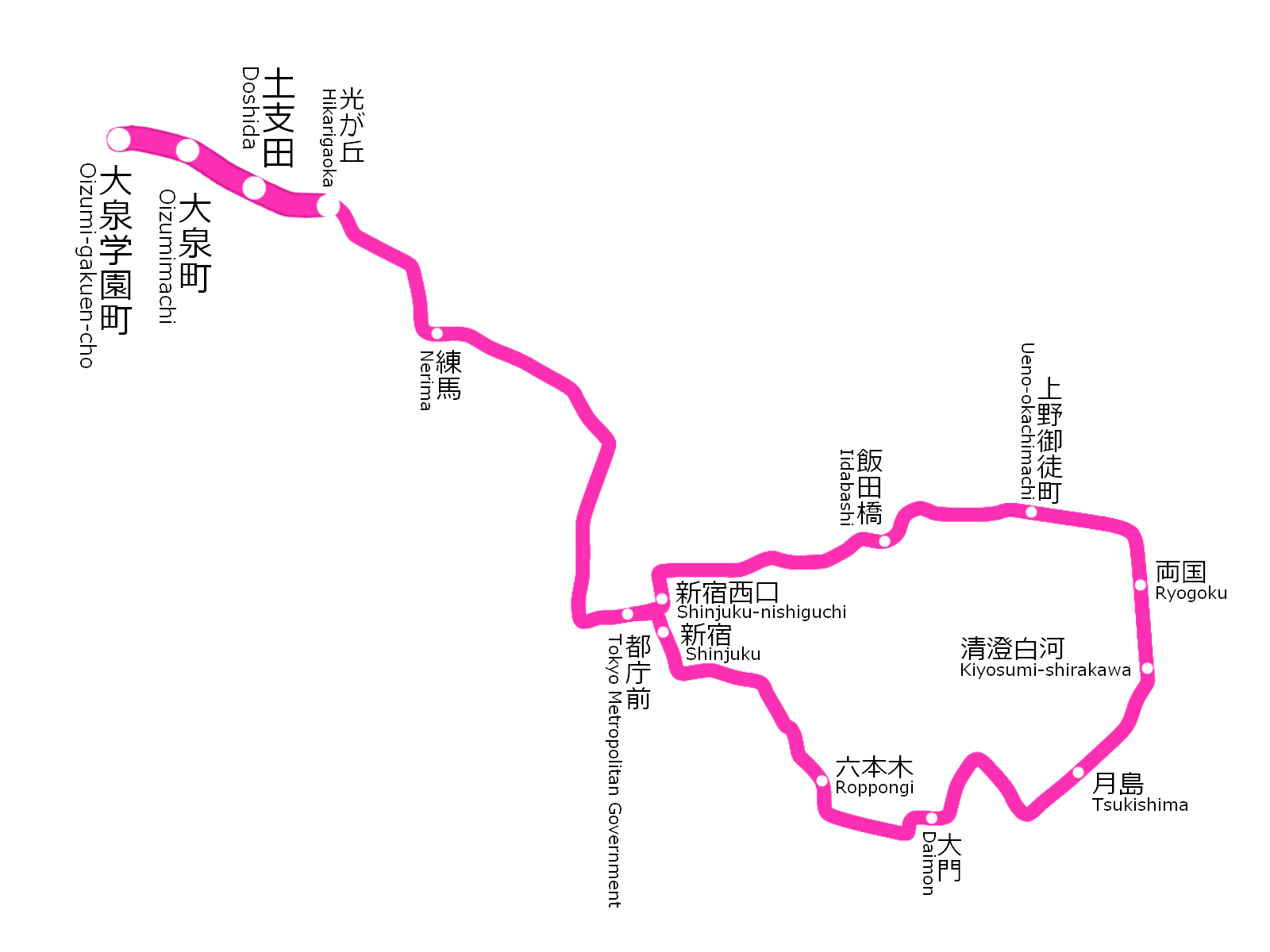
高まる延伸への期待 大江戸線延伸促進大会に再び参加
10月30日、2013(平成25)年以来3年ぶりに開催された「大江戸線延伸促進大会」に参加した。「大江戸線延伸促進大会」は、2016(平成28)年現在、都庁前駅~新宿西口駅~清澄白河駅~新宿駅~都庁前駅~光が丘駅間で営業している都営地下鉄大江戸線を光が丘駅より先、練馬区大泉学園町、埼玉県新座市、東京都清瀬市を経由して、埼玉県所沢市にあるJR東日本武蔵野線の東所沢駅まで延伸させる計画のうち、光が丘駅~練馬区大泉学園町までの区間の開業の早期実現を目指して開催された。会場は前回と同じ、大泉町駅建設予定地のすぐ近くにある練馬区立大泉第一小学校の体育館。大会は1988(昭和63)年の第1回から数えて、今回で第12回目となる。都営大江戸線路線図 太線区間が延伸計画区間(営業区間は主要駅のみ記載) Route map of Toei Oedo Line (large stations only on existed line) adding planning section (bold line)校庭に展示されていた延伸区間の駅名標イメージ panel of station name board on planning section exhibited in the school garden大会には練馬区大江戸線延伸促進期成同盟会長を務める前川燿男(まえかわ・あきお)練馬区長、練馬区議会大江戸線延伸促進および沿線地域まちづくり促進議員連盟の区議会議員の方々、同じく大江戸線の延伸計画がある埼玉県新座市の並木傑(なみき・まさる)市長、東京都清瀬市の今村広司(いまむら・こうじ)企画部長、埼玉県所沢市の三上昌美(みかみ・まさみ)経営企画部長、東京都交通局の牧野和宏(まきの・かずひろ)企画担当部長等が参列した。前川区長が冒頭の挨拶で「1947(昭和22)年に人口11万人で誕生した練馬区は2015(平成27)年には人口72万人を超えた。しかし人口増加が急激なものだったために、交通インフラの発達が人口増加に追い付いていけなかった。練馬区に必要なものは鉄道網を拡充させ、より便利なものにすることであり、大江戸線の大泉学園町方面への延伸は、東京23区に残る、半径1km以内に鉄道の駅が存在しない地域(『鉄道空白地帯』)を解消し、練馬区を今後も成長する都市にさせてくれる。」と大江戸線の延伸の必要性を述べ、続けて「延伸を実現させるために関係各機関に働きかけ続けた結果、2015(平成27)年には東京都の広域交通ネットワーク計画における『整備について優先的に検討すべき路線』と位置付けられ、2016(平成28)年には国の諮問機関である交通政策審議会において『進めるべき6つのプロジェクト』の1つと位置付けられた。東京都や国に延伸の必要性を認識していただけた。」とこれまでの成果を述べた。最後に「トンネルの地上部分にあたる道路の建設も笹目通り~大泉学園通りの全区間で建設が認可され、一部区間(笹目通り(高松六丁目交差点)~土支田通り(交差点名なし))を開通させることができた。しかし今後、実際に路線を建設し、列車を運行させる東京都交通局へ延伸区間の早期着工を働きかけていくことが課題である。」と、延伸に向けての準備とも言うべき地上部分の工事の現状を述べると同時に、東京都交通局の今後の姿勢が重要であることを強調した。前川区長の弁論に呼応するかのように、東京都交通局の牧野企画担当部長は「東京都交通局は高速電車(都営地下鉄)事業において、1日あたり260万人のお客様にご利用していただき、2006(平成18)年度決算以降単年度黒字を計上し続けているが、2016(平成28)年3月時点で3275億円の累積欠損金と7980億円の長期債務を抱えている。一方で大江戸線の1日あたりの利用客数が90万人いるものの、路線単位での収支が黒字化できていないことが現状である。」と交通局と大江戸線の現状について語った反面、この大江戸線延伸計画を「都市鉄道の在り方を目指すプロジェクト」であると位置づけた。その他、豊洲市場の盛り土問題や東京オリンピックの予算削減等の課題への対応等のため多忙な日々を送る小池百合子東京都知事からの祝電の読み上げと、都営大江戸線の計画から今日に至るまでが紹介された。最後に、大江戸線の大泉学園町延伸の必要性を認識し、1日も早く延伸を実現させることを盛り込んだ大会決議に出席者全員が相違ないことを確認した。僕の個人的な意見としては、前回2013(平成25)年の延伸促進大会の時よりも、延伸を実現させるための条件が整い、さらに期待が高まったものと言えるだろう。2000(平成12)年の運輸政策審議会における答申では、2015(平成27)年までに整備着手することが望ましい路線とされたものの、その目標を達成することができなかった。しかし遅れても光が丘駅~大泉学園町の区間は開業させる必要があると、僕も考える。On October 30th, I joined "Convention for Oedo Line extension to Oizumi-gakuen-cho" at gymnasium of Oizumi-daiichi elementary school standing very close to future Oizumi-machi Station being held first time for these three years.The aim of this convention was the realisation of the extension plan of Toei Oedo Line, one of underground railway lines in Tokyo running between Tochomae (Tokyo Metropolitan Government) Station and Hikarigaoka Station, Nerima-ku, via Ueno-okachimachi, Ryogoku, Kiyosumi-shirakawa, Roppongi, Shinjuku, and Nerima, to Oizumi-gakuen-cho, Nerima-ku, a part of the one between Hikarigaoka and Higashi-tokorozawa Station in Tokorozawa City, Saitama Prefecture, where JR East Musashino Line already comes, via Nerima-ku, Niiza City, Saitama, and Kiyose City, Tokyo. It had been held 12 times since 1988.Mayor of Nerima-ku, Akio Maekawa, local assembly members consisting of team for extension of Toei Oedo Line and development of towns around future stations, mayor of Niiza City, Masaru Namiki, planning manager of Kiyose City, Koji Imamura, and corporate planning manager of Tokorozawa City, Masami Mikami, planning manager of Bureau of Tokyo Metropolitan Transportation, Kazuhiro Makino, etc. attended.Mayor Maekawa addressed a speech to an audience. His speech was that Nerima-ku needed to improve the transportation infrastructure which hadn't able to follow the increase of population since 1947, the extension of Toei Oedo Line solve the transportation problem in the areas still be over 1-kilometre/0.6215-mile far away from an railway station, which made Nerima-ku keep growing, the extension plan was designated as a preferentially-considered section on transportation network plan in 2015 and one of six projects with which were forged ahead on the recommendation by an advisory body to Ministry of Land, Infrastructure, Transport and Tourism in 2016, which he saw as the sign for recognition of Tokyo Metropolitan Government and National Government, and the orientation of Bureau of Tokyo Metropolitan Transportation, which would be constructing the new railway, would become important.Like a response to Mayor Maekawa's speech, Planning Manager Makino gave a speech on the project and the present financial condition of Toei Subways. According to his speech, though Toei Subway trains carried 2.9-million passengers a day and remained in surplus for over 10 years on the subway line business, the Bureau had 325 billion-yen cumulative loss and 798 billion-yen long-term debt, Oedo Line couldn't achieve a budget on single line surplus. However, he also saw the project as the one which made Bureau reconsider the existence of railways in urban area.On the convention, a message from Tokyo Metropolitan Governor, Yuriko Koike, was read out and the history of Toei Oedo Line was introduced.At the last part, the attendee and audience checked their will to realise the extension.In my opinion, it is said that the conditions for the extension gets more satisfied to realise. Though the aim in 2000 that the construction of extended section should start by 2015 couldn't achieve, the project must be achieved if it falls behind schedule.
Oct 30, 2016
コメント(0)
-
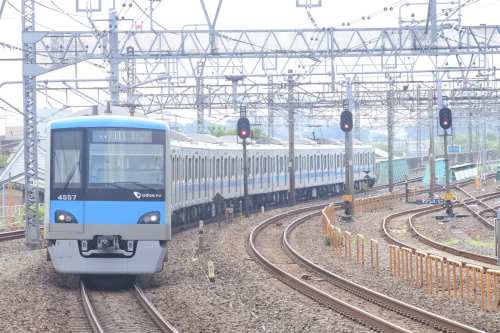
小田急4000形の常磐緩行線対応で藤沢駅発の千代田線直通列車は実現するか
2016(平成28)年3月26日より、小田急小田原線・多摩線から東京メトロ千代田線への直通列車に使用されている小田急4000形電車の運用範囲が、それまでの東京メトロ千代田線に加えて、綾瀬駅以遠のJR東日本常磐緩行線にも広がった。これを受けて、僕は秘かに小田急江ノ島線藤沢駅からの千代田線・常磐緩行線直通列車の登場に期待を寄せている。小田急電鉄の東京メトロ千代田線・JR東日本常磐緩行線への直通列車は、通勤型(2016(平成28)年現在小田急電鉄は4000形が担当)車両による列車が多摩線唐木田駅もしくは小田原線本厚木駅から、小田急60000形「MSE」による特急ロマンスカー「メトロはこね」が箱根登山鉄道鉄道線箱根湯本駅から、同「メトロさがみ」ならびに「メトロホームウェイ」が小田原線本厚木駅から出発しており、江ノ島線からの列車は臨時列車を除いて運行されていない。江ノ島線からの千代田線直通列車がない理由は、江ノ島線の沿線住民が「綾瀬」の行き先を掲げる列車を嫌がったためだと言われている。なぜ「綾瀬」行きの列車を嫌うのかといえば、江ノ島線が綾瀬駅と名前が紛らわしい綾瀬市を掠めるためである。江ノ島線の駅では、長後駅の駅勢圏(駅の利用者が多い範囲)に綾瀬市の一部が含まれている。綾瀬市に鉄道路線が存在しない訳ではないが、JR東海東海道新幹線が市内を通過する唯一の鉄道路線であり、駅が1箇所も存在しないのである。そのため鉄道駅が1箇所も存在しない綾瀬市の至近を通る小田急江ノ島線に綾瀬行きの列車が、特に小田急電鉄の車両が「綾瀬」の行き先を表示して走ると、綾瀬市と綾瀬駅との混同を招き、綾瀬市方面に行く列車であったり、綾瀬市に鉄道駅が存在すると勘違いされることを危惧しているのである。これは列車の行き先が綾瀬駅でなければ、千代田線への直通列車が運行できるとみられるため、綾瀬駅以遠(常磐緩行線)での小田急4000形の運行が可能となったことで、同車による松戸行き、柏行き、我孫子行き、取手行きの列車も実現した。そのため藤沢駅からの列車は必ず綾瀬駅以遠まで直通させるダイヤにすることで江ノ島線沿線住民、特に綾瀬市民の不快感を軽減させながら、列車の利便性のさらなる向上を実現させることができると言えよう。常磐線といえば、快速線の列車(快速・中電・特急列車)が2015(平成27)年3月のダイヤ改正より、上野東京ラインへの直通運転を開始し、東海道本線品川駅まで運行されるようになった。しかし同じく同日より上野東京ライン・東海道本線への直通運転を開始した東北本線・高崎線の列車が小田原駅・熱海駅・沼津駅・伊東線伊東駅などまで運行していることに対して、常磐線の列車は前述のとおり品川駅までの運行となっている。常磐線の快速・中電・特急列車が品川駅止まりとなった背景には、品川駅のホームや留置線の容量が十分に確保できるためとみられるが、緩行線列車が小田急小田原線へ直通運転し、将来の小田原駅もしくは小田急江ノ島線藤沢駅までの入線も想定されていることから、取手駅~小田原駅間、および取手駅~藤沢駅間で快速線列車と緩行線列車とが競合関係となることを避けるためとも見て取れる。以上2つの準備が整ったことから、藤沢駅~我孫子駅・取手駅を運行する小田急江ノ島線・東京メトロ千代田線・JR東日本常磐緩行線の列車がいつ登場してもおかしくないと言えるだろう。From March 26th, 2016, Odakyu 4000 Series started to go through JR East Joban Line local service farther than Ayase Station, as well as Tokyo Metro Chiyoda Line.I look forward to appearing trains between Fujisawa Station on Odakyu Enoshima Line and Abiko Station or Toride Station on JR East Joban Line.In 2016, Odakyu 4000 Series and 60000 Series Romancecar MSE go through those lines. Odakyu 4000 Series operates as the local or express trains on those lines between Karakida Station on Odakyu Tama Line or Hon-atsugi Station on Odakyu Odawara Line and Abiko Station or Toride Station, and 60000 Series MSE does as "Metro Hakone" limited express between Hakone-yumoto Station on Hakone Tozan Railway Line and Kita-senju Station, and as "Metro Sagami" limited express and "Metro Homeway" limited express between Hon-atsugi Station and Kita-senju Station. However, except the special trains, those from/to Fujisawa Station or Katase-enoshima Station on Odakyu Enoshima Line haven't operated.It is said that some people living in the cities along Enoshima Line, especially in Ayase City, which is sometimes confused with Ayase Station, object the operation.Enoshima Line doesn't pass through Ayase City, but some people in Ayase City use Chogo Station on Enoshima Line, which stands near the border between Fujisawa City. Though a railway line (Tokaido Shinkansen) passes through, there is no railway station in Ayase City. Some people in the city still feel misgivings that the train's destination indicator saying Ayase makes misunderstanding that the train goes toward the city or Ayase Station stands in the city.This problem may be solved if the train's destination is Ayase. Starting the going-through service on Joban Line local service by Odakyu 4000 Series may lead to realize the regular train operation from Odakyu Enoshima Line.Meanwhile, since 2015, Joban Line rapid and limited express train go through Ueno-tokyo Line, as well as Tohoku Line, Takasaki Line, and Tokaido Mine Line trains. However, though Tohoku, Takasaki, and Tokaido Main Line run between Utsunomiya Station on Tohoku Main Line or Takasaki Station on Takasaki Line and Atami Station on Tokaido Main Line. However, Joban Line trains terminate at Shinagawa.Why Joban Line trains terminate at and depart from Shinagawa Station seems to be that Shinagawa has enough tracks and arailyard to adapt Joban Line trains' long-time stop.From my point of view, it also may be to avoid competing between Joban Line rapid train and local train between Toride Station and Fujisawa Station or Odawara Station.Because of these two affair, it can be waiting to happen to appear the regular train going through Tokyo Metro Chiyoda Line and Joban Line from Odakyu Enoshima Line.
Aug 27, 2016
コメント(0)
-
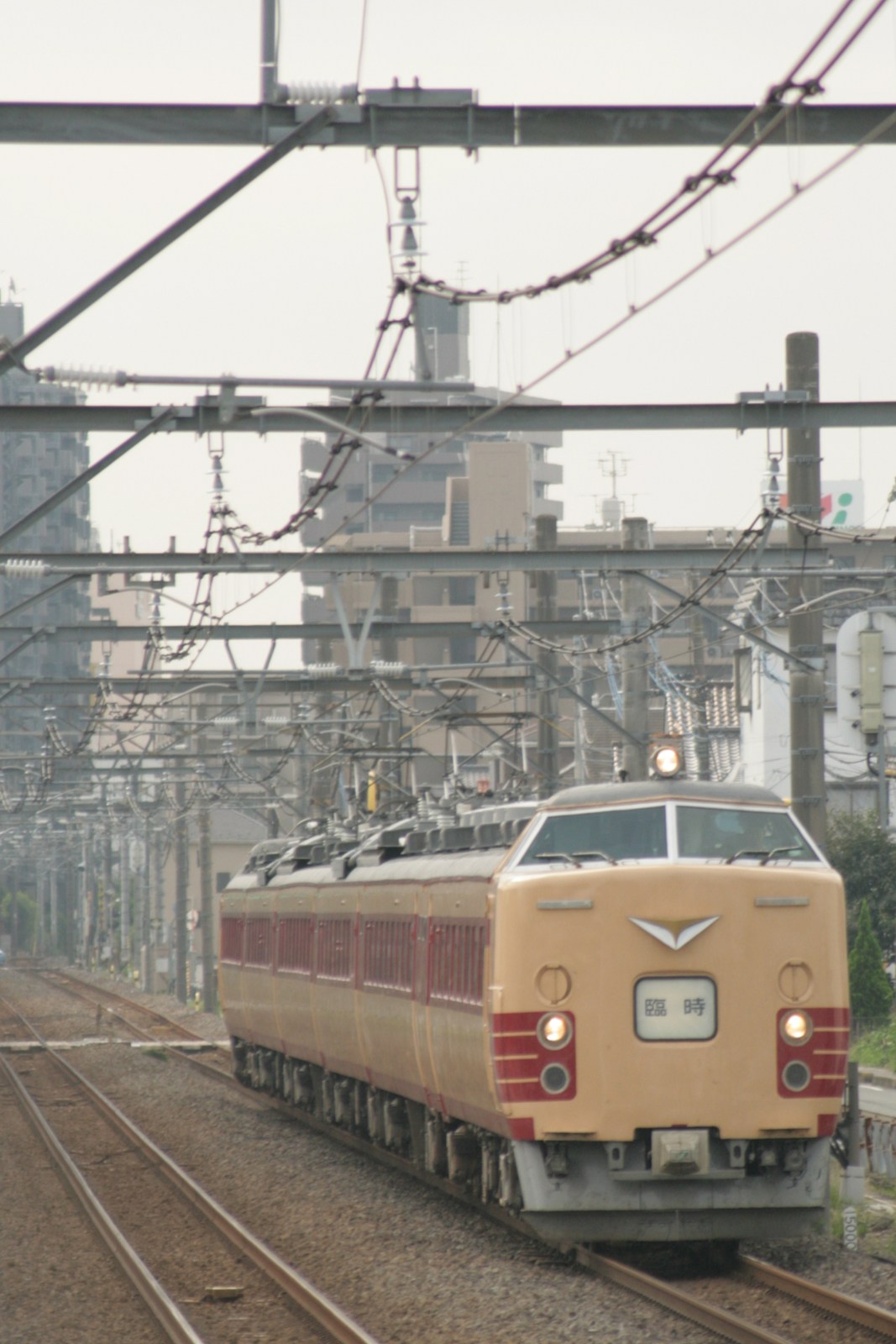
485系時代の終焉
6月19日、JRで最後となる国鉄特急色の485系、JR東日本仙台車両センター所属のセンA-1・A-2編成が引退した。日本の鉄道の一時代を築いた名車両、国鉄485系電車がJRの特急列車から引退したのが去る2016(平成28)年3月21日のことであった。それから3ヶ月、クリーム色(クリーム4号)と赤色(赤2号)の組み合わせの国鉄特急色の編成が営業運転から姿を消した。485系は1968(昭和43)年に登場した国鉄を代表する特急型電車。1958(昭和33)年に登場した国鉄初の特急型電車で、「こだま形」の愛称で親しまれた151系電車を基本とする設計で、直流・50Hz交流・60Hz交流に対応した、電化された国鉄線を全て走ることができる万能型車両だった。北は北海道の「いしかり」から南は九州の「有明」「にちりん」「きりしま」まで、幅広く活躍した。485系の礎を築いた481系電車・483系電車、そしてEF63形電気機関車との連結が可能な、かつての国鉄・JR最大の勾配だった碓氷峠越えに対応した489系電車を併せて、以下「485系一族」と称する。485系一族は1964(昭和39)年から1979(昭和54)年にかけて1,453両が製造された。先頭車両となるクハ481形およびクハ489形の前面で見ると、1964(昭和39)年から1971(昭和46)年にかけて製造された車両が151系に準じたボンネット形、1972(昭和47)年以降に製造された車両が583系に準じた「月光型」スタイルの貫通型もしくは非貫通型(特に非貫通型は鉄道ファンからは「電気釜」の愛称で呼ばれる)となっている。ボンネット型のクハ489形を組み込んだ489系 long-nosed ("bonnet style") 489 Series非貫通型(電気釜)のクハ481形・クロハ481形を組み込んだ485系 Non-penetration ("rice cooker") style 485 Series485系一族の歴史は、大阪駅~富山駅間を結んだ特急「雷鳥」、および名古屋駅~富山駅間を結んだ特急「しらさぎ」用に製造された481系電車にまで遡る。481系は1964(昭和39)年12月25日に登場した、直流と60Hz交流に対応した車両で、向日町運転所(現在の吹田総合車両所京都支所)に配属された。翌1965(昭和40)年10月1日には上野駅~仙台駅間の「ひばり」用の483系電車が、直流と50Hz交流に対応した車両として登場、仙台運転所(現在の仙台車両センター)に配属された。483系のデビューと同日の1965(昭和40)年10月1日、向日町運転所所属の481系が名古屋駅~熊本駅間の特急「つばめ」、新大阪駅~博多駅の特急「はと」としても運行されることとなった。この時から、向日町を出庫し、まずは大阪駅へと向かい、大阪駅~富山駅の「雷鳥」運用、富山駅~名古屋駅の「しらさぎ」運用をこなして名古屋駅で一夜を明かし、翌日に名古屋駅~熊本駅の「つばめ」運用を連続でこなすようになった。これが後の485系一族の広範囲な運用へと発展していく。当時の国鉄では、481系の運行範囲が広がっていくにつれて、日本の電力供給ならではの問題に直面する。「富士川・糸魚川ライン」と呼ばれる境界で変わる東西での交流電気の周波数の違いである。交流電化区間のうち、これよりも東の北海道・東北地方各線は50Hz交流で、これよりも西の北陸本線と九州地方各線は60Hz交流で電化されていることから、将来の広域転配と呼ばれる車両の遠隔地への転属と、50Hz交流電化路線と60Hz交流電化路線へ直通運転する列車への対応を想定し、交直両用電車においては50Hzと60Hzの2種類の交流電気に対応した車両の開発が進められた。こうして、50Hzと60Hzの2種類の交流、そして直流のすべての電気に対応した485系電車が1968(昭和43)年10月1日のダイヤ改正(いわゆる「ヨンサントオ」改正)で営業運転を開始した。以来、日本全国の特急列車として活躍した。中でも485系のすべての電気に対応した設計を発揮した列車と言える存在が、大阪駅~青森駅間、東海道本線・湖西線・北陸本線(現在のIRいしかわ鉄道線・あいの風とやま鉄道線・えちごトキめき鉄道日本海ひすいラインを含む)・信越本線・白新線・羽越本線・奥羽本線の各線、実に1,040kmを走破した「白鳥」であろう。それまでキハ80系による気動車列車として運行されてきたが、「日本海縦貫線」と総称される前述の各線の電化により、1972(昭和47)年10月2日より485系で運行され、2001(平成13)年3月2日まで運行された「白鳥」は、485系が起用された列車としてはもちろんのこと、歴代の国鉄・JRの昼行特急列車としても最長距離を誇る。485系はすべての電化区間を走れる特急型電車として誕生したものの、485系一族が主役の時代はそう長くは続かなかった。 東北・北陸方面への列車では引き続き活躍を続けていたが、新幹線が岡山駅、さらには博多駅へと延伸していくにつれて、新大阪駅・大阪駅~九州方面への特急列車が減らされ、活躍の場が次第に縮小されていく。特に1975(昭和50)年の山陽新幹線博多駅開業により、東海道本線・山陽本線系統の長距離特急列車が全廃され、小倉駅または博多駅で新幹線と接続する「有明」「にちりん」といった九州内の特急列車へと活躍の場を追いやられる格好となった。山陽新幹線博多駅開業に次ぐ、485系一族にとっての大きな転機となった出来事が、1982(昭和57)年の東北新幹線大宮駅~盛岡駅間と上越新幹線大宮駅~新潟駅間の開業、そしてその3年後の1985(昭和60)年の両新幹線の上野駅への延伸である。これまで東京駅から西へ伸びていた新幹線だったが、1965(昭和40)年の「ひばり」以来485系一族が長距離輸送の主力の座にあった、上野駅から北へと向かう新幹線が開通したのである。これにより483系デビュー時から長年主役の座にあった「はつかり」「ひばり」「いなほ」などの上野駅から東北各地を結ぶ特急列車の廃止や運行区間の短縮が実施され、東海道本線・山陽本線に続いて活躍の場が縮小された。具体的には「ひばり」「やまびこ」「やまばと」が廃止され、「はつかり」が上野駅~青森駅間から盛岡駅~青森駅間に、「いなほ」が上野駅~秋田駅・青森駅から新潟駅~酒田駅・秋田駅・青森駅間に短縮されたなどである。また長距離を走る特急列車の象徴と言える存在だった食堂車(サシ481形)を連結する列車がなくなり、他形式に改造された車両を除いて1987(昭和62)年までにサシ481形は全廃された。国鉄が民営化された1987(昭和62)年以降も生き残った485系一族は、JR北海道・東日本・西日本・九州へと引き継がれ、車体塗装を塗り替えられたり、内装をリニューアルされたりした車両も登場した。JR北海道へは編成単位で引き継がれることはなかったが、引き継がれた車両のうちサシ481形1両は、寝台特急「北斗星」用の24系客車に改造・編入され、スシ24形と改名した。しかし1990年代に入ると、485系一族は新造から20~30年が経過した車両が多数発生し、JR各社は新型特急電車を投入し、順次485系を置き換えていくこととなる。新潟車両センター所属の485系リニューアル車(3000番台) Refurbished 485 Series belonging to Niigata Railyardサシ481形の改造車 24系客車「北斗星」用編成の食堂車スシ24形 Sushi 24 dining carriage of 24 Series sleeper passenger carriage for "Hokutosei" converted from Sashi 481 of 485 Series21世紀を迎えてからも、485系一族を使用した列車の減便が目立ち、最初の大きな変化は2001(平成13)年3月のダイヤ改正である。前述の通り、国鉄・JRの最長の走行距離を誇った昼行特急列車「白鳥」が運行を終了したと同時に、「雷鳥」も新潟駅発着がなくなり大阪駅~金沢駅間の運行に短縮された。その一方で、2002(平成14)年に八戸駅~函館駅(のちに新青森駅~函館駅へ変更)間の「白鳥」、八戸駅~弘前駅(のちに新青森駅~弘前駅に短縮)間の「つがる」が、2006(平成18)年には新宿駅~東武日光駅間の「日光」、新宿駅~鬼怒川温泉駅間の「きぬがわ」が、485系を使用した列車としてそれぞれ新設された。小山車両センター所属だった「日光」・「きぬがわ」用の485系 Refurbished 485 Series for "Nikko" and "Kinugawa" belonging to Oyama Railyard.2010(平成22)年にはデビュー当時からのボンネット型の前面を持つ489系で運行された急行「能登」が運行を終了し、489系の定期運行がゼロとなり、ボンネット型の485系一族が姿を消した。そして、485系の引退を強く匂わせる出来事が2011(平成23)年に起こる。この年の3月11日、485系一族の祖、481系が最初に投入された「雷鳥」がこの日を最後に廃止されたのである。これによりJR西日本所属の車両の定期運行が終了した。さらに翌日に九州新幹線の全線開通を控えたJR九州管内でも485系による定期列車がこの日を最後になくなった。そして同年、4月23日に「つがる」もE751系に、6月4日に「日光」「きぬがわ」も「成田エクスプレス」から転用された253系に置き換えられた。これによって485系の定期運行はJR東日本所属の車両による「白鳥」「いなほ」「北越」のみとなった。しかしこれらの運用も、485系の老朽化が目立ってきたことや新幹線の延伸によって、新型車両への置き換え、もしくは廃止となる。2013(平成25)年から2014(平成26)年にかけて、「いなほ」に「フレッシュひたち」(現在の「ときわ」)から転用されたE653系が投入され、485系が同列車から引退したことに続いて、2015(平成27)年3月の北陸新幹線長野駅~金沢駅間延伸に伴って「北越」が、2016(平成28)年3月の北海道新幹線新青森駅~新函館北斗駅間開業に伴って「白鳥」が廃止され、485系による特急列車運用がゼロとなった。そして、迎えた2016(平成28)年6月19日、最後の国鉄特急色の485系となった、仙台車両センター所属のセンA-1・A-2編成が引退した。この編成は磐越西線の臨時特急列車「あいづ」、および快速列車「あいづライナー」用として、一度赤色に赤べこのキャラクター「あかべぇ」が描かれた塗装に塗り替えられ、内装もリニューアルされたが、2011(平成23)年に国鉄特急色に復元された。国鉄特急色という1958(昭和33)年デビューの151系から続く国鉄特急の伝統を引き継ぐ、そして多くの鉄道ファンが最も485系らしいと考える塗装と言われてきた車両が姿を消すということは、すべての485系が完全に姿を消した訳ではないものの、一時代の終わりを意味するのであろう。引退した車両のうち485系が埼玉県・大宮の鉄道博物館(クハ481形 ボンネット型・モハ484形)、新潟県・新津の新潟市新津鉄道資料館(クハ481形 非貫通型)、福岡県・門司の九州鉄道記念館(クハ481形 ボンネット型)に、489系が京都府・梅小路の京都鉄道博物館(クハ489形 ボンネット型)、石川県・小松の土居原ボンネット広場(クハ489形 ボンネット型)にそれぞれ保存・展示されており、その姿を拝むことができる。終わりに、国鉄・JRの特急列車を52年間の長きに渡って支えてきた485系一族の物語は、今後も語り継がれることであろう。On June 19th, 2016, 485 Series Sen A-1・A-2 set, which had a pail-orange-and-red-coloured body, traditional colour of the carriages for limited express train in Japan National Railway (JNR) period, and last one in service, retired. Three months had passed since all 485 Series sets' retirement from regular operations of limited express trains on JR Lines. 485 Series debuted in 1968 and was designed as the carriage capable of the operations on all electrified JNR lines, available to DC, 50Hz AC, and 60Hz AC, based on 151 Series, the first electric carriage for limited express train in Japan known as "Kodama" between Tokyo and Osaka or Kobe before opening Shinkansen. Fully using its specification, the carriages used to run all over Japan, the northernmost was "Ishikari" in Hokkaido and the southernmost was "Kirishima" in Kyushu, and created the golden age of limited express trains after World War Two.485 Series family, including 481 Series, designed for DC and 60Hz AC electrified lines and built the basement of 485 Series, 483 Series, done for DC and 50Hz AC, and 489 Series, improved model available to coupling with Class EF63 electric locomotive for going up and down steep slope on Shinetsu Main Line, were totally built 1,453 carriages between 1964 and 1979. Focusing on the front design, the models made between 1964 and 1971 had long-nosed, so-called "bonnet" style, one, and the ones made between 1972 and 1979 introduced penetration or non-penetration style looking like that of 583 Series, which was called "rice cooker" by railfans.The history of 485 Series family started when 481 Series debuted as "Raicho" limited express between Osaka Station and Toyama Station and "Shirasagi" limited express between Nagoya Station and Toyama Station on December 25th, 1964. In the following year, 483 Series also debuted as "Hibari" limited express between Ueno Station and Sendai Station.On October 1st, 1965, the same day as 483 Series' debut, 481 Series also started to operate as "Tsubame" limited express between Nagoya Station and Kumamoto Station and "Hato" limited express between Shin-osaka Station and Hakata Station. Since that, a 481 Series set continuously operated. One day it first ran as "Raicho" from Osaka, next as "Shirasagi" from Toyama. Passing a night at Nagoya Station, it went to Kumamoto Station as "Tsubame". These operations lead pervasive use of 485 Series family.As the area 481 Series ran spread, JNR faced the problem of the electric power supply, the difference of the frequency between east Japan (50Hz) and West Japan (60Hz) bounded by Fujikawa-Itoigawa Line.To prepare for the train running through both 50Hz and 60Hz AC-electrified lines and mutual transfer between the railyard on the different frequency sections, 485 Series was designed and debuted on October 1st, 1968.It was said that the train made the best use of 485 Series' specification capable of all electrified sections was "Hakucho" limited express between Osaka Station and Aomori Station via Tokaido Main Line, Kosei Line, Hokuriku Main Line (including present IR Ishikawa Railway, Ainokaze Toyama Railway, and Echigo Tokimeki Railway Nihonkai Hisui Lines), Shinetsu Main Line, Hakushin Line, Uetsu Main Line, and Ouu Main Lines, which was the longest (1,040km/646.226mi) distance among successive JNR and JR limited express trains until 2001. On that time, Osaka Station on Tokaido Line and Nagahara Station on Kosei Line and Itoigawa Station on Hokuriku Main Line and Murakami Station on Uetsu Main Line were DC-electrified, Nagahara and Itoigawa Station on Hokuriku Main Line was 60Hz AC-electrified, and between Murakami and Aomori on Ouu Main Line was 50Hz AC-electrified.However, the golden age of 485 Series family didn't last so long. As Shinkansen was extended to the westward and northward, the limited express trains overlapped with Shinkansen gradually decreased. At first when Shinkansen was extended to Hakata Station in 1975, all of limited express trains operated by 485 Series between Shin-osaka, Osaka, or Okayama Station toward Kyushu area ended to run and the carriages transferred to those only on Kyushu such as "Ariake" limited express (Moji Station or Hakata Station - Nishi-kagoshima (present Kagoshima-chuo Station) via Kagoshima Main Line (including present Hisatsu Orange Railway Line)) and "Nichirin" limited express (Hakata - Nishi-kagoshima via Nippo Main Line). Following that, when Tohoku Shinkansen between Omiya Station and Morioka Station and Joetsu Shinkansen between Omiya Station and Niigata Station opened in 1982 and they were extended to Ueno Station in 1985, almost all of limited express trains on Tohoku Main Line from/to Ueno Station ended or shortened its service. For example, "Hibari", "Yamabiko" (Ueno - Morioka), and "Yamabato" (Ueno - Yamagata via Ouu Main Line) were abolished, and "Hatsukari" (Ueno - Aomori) was shortened between Morioka and Aomori and "Inaho" (Ueno - Akita or Aomori via Takasaki, Joetsu, Shinetsu, Uetsu, and Ouu Lines) was between Niigata to Sakata, Akita, or Aomori via Hakushin, Uetsu, and Ouu Lines. At the same time, the daytime limited express trains coupling the dining carriage (Sashi 481) completely disappeared and the dining carriages were scrapped except the ones converted to the other use until 1987.After the privatization of JNR in 1987, 485 Series family were inherited to JR Hokkaido, JR East, JR West, and JR Kyushu and kept in service as JNR period. The dining carriage inherited to JR Hokkaido was converted to that (Sushi 24) for "Hokutosei" sleeper train (Ueno - Sapporo). However, 20 or 30 years had passed since many of 485 Series family carriages built in the 1990s and they started to be replaced by newly-made models.After entering the 21st century, the number of limited express trains by 485 Series family kept being decreased. In 2001, As already stated, "Hakucho" finished its service and "Raicho" shortened to between Osaka and Kanazawa. On the other hand, in 2002 "Hakucho" (Hachinohe - Hakodate) and "Tsugaru" (Hachinohe - Hirosaki), in 2006 "Nikko" (Shinjuku - Tobu-nikko) and "Kinugawa" (Shinjuku - Kinugawa-onsen) started to run by 485 Series.In 2010, the first long-nosed model of 485 Series family finished its regular operation. The last one was "Noto" overnight express by 489 Series.In 2011, decisive events to lead the complete retirement happened. On March 11, "Raicho", the first train 485 Series family was introduced, finished its service and all of the ones in Kyushu area retired from regular operation such as "Hyuga" and "Kirishima", both of which were introduced the 787 Series moved from "Relay Tsubame". Following that, the one for "Tsugaru" (Shin-aomori - Hirosaki) was by E751 Series, and on June 4th the one for "Nikko", and "Kinugawa" were replaced by 253 Series.The last three trains by 485 Series were "Inaho", "Hokuetsu" (Kanazawa - Niigata), and "Hakucho" (Shin-aomori - Hakodate), but they also finished their service influenced by newly open of Shinkansen or replacement by a new carriage by March, 2016.Then June 19th, 2016, the last day of the traditional-coloured 485 Series had come. The last traditional-coloured set, Sen A-1・A-2, used to run as "Aizu" special limited express or "Aizu Liner" rapid train on Banetsu West Line. Though it once changed its body colour to the red with Akabeko (traditional toy of the red cow) illustration and its interior was refurbished, it was repainted to the traditional body colour in 2011. Some railfans regard the retirement of this traditional colour of the carriages for the limited express train since 151 Series' debut in 1958 as the end of a certain era on the Japanese railway history.Several carriages in the traditional colour are preserving in railway museums and a park, such as The Railway Museum (long-nosed Kuha 481 and Moha 484), Niigata City Niitsu Railway Museum (non-penetration style Kuha 481), Kyushu Railway History Museum (long-nosed Kuha 481), Kyoto Railway Museum (long-nosed Kuha 489), and Doihara Bonnet Place in Ishikawa Prefecture (long-nosed Kuha 489).Finally, the 52-year history of 485 Series family might be transmitted by word of mouth.参考文献 Refernce『485系物語』 JTBキャンブックス『鉄道ピクトリアル』 2011年4月号「485・489系電車」 電気車研究会『鉄道ピクトリアル』 2014年11月号「485・489系電車(I)」 電気車研究会『鉄道ピクトリアル』 2014年12月号「485・489系電車(II)」 電気車研究会
Jul 24, 2016
コメント(0)
-
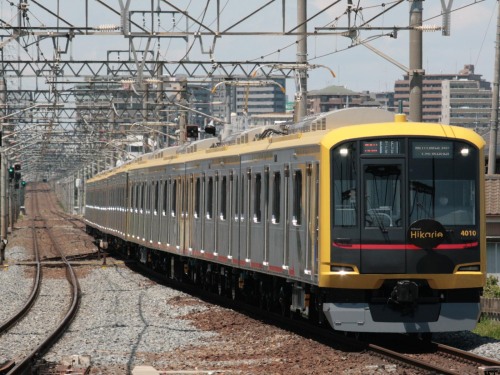
「Fライナー」東上線での運行概要が明らかに
2月9日、東武鉄道が、すでに発表済みの、東上線内を急行列車として運行する東京メトロ副都心線・東急東横線・横浜高速鉄道みなとみらい線直通列車「Fライナー」のより詳細な運行形態を含む、3月26日に実施する予定の東上線のダイヤ改正の詳細を発表した。「Fライナー」の運行区間は元町・中華街駅~森林公園駅間とし、平日・土休日共に日中時間帯を中心に運行される。東上線内各駅に停まる現行列車と比較して、Fライナーは元町・中華街駅~川越駅間を元町・中華街駅方面行きで11分、森林公園駅方面行きで10分で短縮され、同駅間を元町・中華街行きで84分、森林公園行きで82分で結ばれる。和光市駅では、「Fライナー」と東上線池袋駅発の準急列車と接続するダイヤが組まれる。この列車は、毎時25分・55分東上線池袋駅発で、現行ダイヤで森林公園行きの急行列車となっているのを、川越市行きの準急列車に変更するものである。同列車は和光市駅で東京メトロ副都心線からの川越市行き列車に接続するダイヤが組まれていることから、両列車の和光市駅以西のダイヤを交換する形になる。また土休日の朝・夕方には、元町・中華街駅~森林公園駅の快速急行列車も森林公園行き3本、元町・中華街行き2本が新設される。この快速急行列車は夕方の元町・中華街行き2本は完全な新設だが、朝の森林公園行き3本は、和光市駅の発時刻が現行の東上線池袋駅発の快速急行列車のものとほぼ同一であることから、和光市駅~森林公園駅のダイヤは同列車とほぼ同じと見られる。「Fライナー」とは違い、これらの列車に新しい愛称は付けられない。僕の主張が届いたというような大袈裟なことは言わないが、「Fライナー」の東上線内のダイヤについて、以前の僕の予想が大方的中した。今回のプレスリリースでは元町・中華街駅~川越駅間の時間で掲載しているが、横浜駅~川越駅間の所要時間も、現行の副都心線からの川越市行き各停列車が和光市駅で接続する東上線池袋駅発の森林公園行き急行列車のダイヤとを交換することで急行運転を実現させることも、そしてこれによって実態に合っていなかった東京メトロの路線図に載せられた副都心線の「森林公園駅まで直通運転」という文言がようやく実態に合ったものに変わるということもである。また、Fライナーよりも早い、東上線を快速急行列車として運行する列車の登場は予想していなかったが、東上線坂戸駅~寄居駅間および越生線全線が乗り降り自由となる「東急東武東上線ハイキングきっぷ」の需要を高めることにつながると言える。いずれにしても、今回のダイヤ改正で利便性がさらに向上する東横線・副都心線・東上線の直通列車に注目したい。On February 9th, Tobu Railway announced that the timetable on Tojo Line is being revised on March 26th including the detail of the F-Liner service going through Tokyo Metro Fukutoshin Line, Tokyu Toyoko Line, and Yokohama Minatomirai Railway Line.F-Liner going toward Tojo Line operates between Motomachi-chukagai Station on Yokohama Minatomirai Railway Line and Shinrin-koen on Tojo Line on daytime and it takes 84 minutes (toward Yokohama Minatomirai Railway Line) and 82 minutes (toward Tojo Line) between Motomachi-chukagai and Kawagoe, which is up to 11 minutes faster than the present ones which stops all stations between Wakoshi and Kawagoe.At Wakoshi Station, F-Liner connects the semi express train from Ikebukuro Station on Tojo Line, which departs at every 25 past the hour and 5 to the hour and changes from the present express train for Shinrin-koen connecting to the one from Fukutoshin Line at Wakoshi. It is like a exchange of the timetable of the two farther from Wakoshi.In addition, on the weekend and holiday morning and evening, rapid express trains from Fukutoshin Line newly starts to run. Among those, the timetable of the 3 on the morning resembles the ones from Tojo Line Ikebukuro in the present. Different from F-Liner, those trains doesn't have names.Not makeing a grandiose claim that my opinion reaches the railway operator, my expectation about the timetable of F-Liner is almost right; the travel time between Yokohama and Kawagoe, extension to Shinrin-koen using the way to exchange the timetable, and becoming reality of "going through Shinrin-koen Station" on Tokyo Metro's railroad map. I can't expect the appearance of the faster train than F-Liner and it may make more demand for "Tokyu Tobu Tojo Line Hiking ticket" which allows passengers an unlimited travel on Tojo Line between Sakado and Yorii and Ogose Line between Sakado and Ogose.At all events, I keep paying attention to the trains on those lines. 東武鉄道プレスリリース 2016年2月9日 「3月26日(土)東武東上線でダイヤ改正を実施!」
Feb 14, 2016
コメント(0)
-
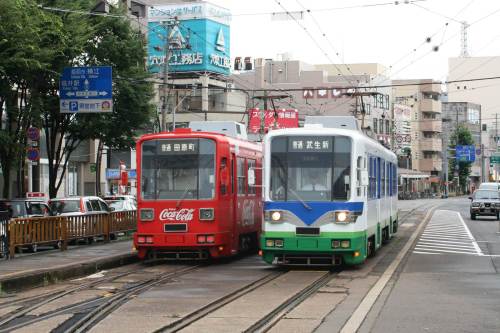
福武線・三国芦原線は日本の新しいトラムトレインの先駆けとなれるか
1月21日、福井鉄道福武線とえちぜん鉄道三国芦原線との直通運転が2016(平成28)年3月27日の開始を目指して、両社および関係機関で最終調整が進められていることが、福井新聞の取材で解った。このプロジェクトは、2016(平成28)年1月現在、田原町駅で終わっている福武線の線路を三国芦原線と繋ぎ、福武線越前武生駅~三国芦原線鷲塚針原駅まで直通運転する列車を走らせるというものである。2013(平成25)年から工事が進められ、田原町駅の改良・両線の線路の接続と福大前西福井駅~鷲塚針原駅の中角駅を除く各駅には路面電車の規格に合わせた、既存のものよりも床が低い乗り場(電停)が新設される。福井県の西川一誠知事もこのプロジェクトの実現を公約とし、2003(平成15)年の選挙以降当選を繰り返してきた。初当選から13年で実現にこぎ着けようとしている。福武線と三国芦原線が直通運転を始めると、越前武生駅~鷲塚針原駅間が、現状は田原町駅での乗り換え時間も含めて80分であるところ、60分にまで短縮されるという。今回の直通運転に合わせて、えちぜん鉄道でも福井鉄道F1000形と同形の低床路面電車車両を導入し、F1000形車両と共に直通運転に使用される。この福武線・三国芦原線直通列車のような、郊外部から都心部を走り抜けて、再び郊外部へ至る運行経路の路面電車は、欧米諸国では決して珍しいものではない。路面電車の線路を既存の郊外へと伸びる鉄道のものと繋ぎ、郊外から都心部までを乗り換えなしで行けるようにすることは、欧米諸国で発達した路面電車の活性化手法の1つで、「トラムトレイン」と呼ばれる。トラムトレインは1960年にドイツのカールスルーエで登場し、軽便鉄道を改築したり、使われなくなった非電化の貨物線を電化したりして、ネットワークを広げていった。1992年には、架線の電気が路面電車とは異なるドイツ鉄道(DB)の路線とも直通運転を、両線の電気に対応した車両を導入して、開始した(路面電車:直流750V、DB:交流15000V)。幸い福武線と三国芦原線は共にレールの幅(1067mm)、架線の電気(直流600V)が同じ規格であるため、三国芦原線に床の低い乗り場を新設する程度で済み、直通運転への障害は大きくなかった。日本の路面電車は、路面を走らない、普通鉄道のような「専用軌道」と呼ばれる区間も含めて、軌道法によって監督されている場合が多いが、福武線のようにこのような路面ではない区間を軌道法の「専用軌道」ではなく、鉄道事業法によって監督されている普通鉄道として扱うものもある。軌道法区間と鉄道事業法区間を直通する日本の路面電車は福武線の他、富山県の万葉線と富山ライトレール富山港線、広島県の広島電鉄2号線(宮島線)、愛媛県の伊予鉄道松山市内線の一部(城北線)が現存し、かつては2005(平成17)年に廃線になった岐阜県の名鉄田神線、同揖斐線もあった。その中でトラムトレインに近いものは広島電鉄2号線と名鉄岐阜市内線・揖斐線であろう。しかしこれらはあくまでも同一路線、もしくは同一会社の運行する路線である。今回の福武線と三国芦原線の直通運転の特筆すべき点は、2社にまたがっての路面電車と普通鉄道との直通運転であるということである。ここで両線がどのような路線かをおさらいしよう。越前武生駅~田原町駅を結ぶ福井鉄道福武線は、越前武生駅~赤十字前駅間は鉄道事業法によって監督されている普通鉄道、赤十字前駅~田原町駅間と市役所前電停~福井駅(福井駅前電停)間は軌道法によって監督されている路面電車という2つの性格を併せ持つ路線である。1924(大正13)年に福武電気鉄道として開業。当初は福井市市街地へ、普通鉄道として足羽山にトンネルを掘り、米島口(現在の三国芦原線福大前西福井駅)まで延伸する構想もあったが、現在の路面電車の形で1933(昭和8)年に開業した。かつては普通鉄道規格の車両が路面電車区間にも乗り入れ、床が低い電停ではドア下の折り畳み式ステップを出している光景が日常的に見られたが、2006(平成18)年以降は、その前年に廃線となった岐阜県の名鉄岐阜市内線・揖斐線・美濃町線・田神線で活躍した路面電車車両、モ770形、モ880形、モ800形が大量に移籍し、一部旧来の車両が残るものの、一気に路面電車らしい姿に変貌を遂げた。2013(平成25)年にはカナダ・ボンバルディア社の「インチェントロ」をベースとする新型車両F1000形が登場した。同車は福井鉄道の車両で初めてローレル賞を獲得した。2008(平成20)年には、それまで筆頭株主だった名鉄が経営から撤退し、地元の商工会等が株を所有している、純然たる地元資本企業に生まれ変わった。また翌2009(平成21)年には沿線市町村である福井市・鯖江市・越前市も、福武線の鉄道用地を買い取り、保線・施設整備費用を負担する支援を、地域公共交通の活性化及び再生に関する法律(活性化・再生法)の適用を受けて、実施している。一方の福井駅~三国港駅を結ぶえちぜん鉄道三国芦原線は、1928(昭和3)年に三国芦原電鉄として開通。1942(昭和17)年、当時の親会社であった京都電灯(関西電力の前身)の鉄道事業を分社化した京福電気鉄道(京都府の嵐電の運行会社と同じ)と合併した。2001(平成13)年までは、越前本線(現在の勝山永平寺線)・永平寺線(2001(平成13)年休止、2002(平成14)年廃線)とともに京福電気鉄道福井鉄道部によって運行されてきたが、2000(平成12)年に越前本線・永平寺線東古市駅(現在の永平寺口駅)で、2001(平成13)年に越前本線保田駅~発坂駅間で立て続けに発生した列車正面衝突事故を受けて、両線とも国土交通省の行政処分の下、運行停止に陥った。福井県と沿線市町村の支援の下、2003(平成15)年にえちぜん鉄道の路線として復活し、沿線住民がサポーターズクラブを設立し、鉄道会社と沿線住民とが連携して利便性の向上に努めている。この復活劇は、地方鉄道の必要性を日本中に訴えかけるきっかけとなり、鉄道会社の経営状態だけで簡単に廃線にしてはいけないという姿勢に転換させ、全国の地方自治体が地元の鉄道路線に対する支援を強化させた。近年では2014(平成26)年に、坂井市を舞台とするアニメ「グラスリップ」に登場した電車として知名度を上げたことでも記憶に新しい。最後に僕の個人的な見解として、2016(平成28)年3月の段階では三国芦原線への乗り入れ区間がまだ鷲塚針原駅までと中途半端な感があるため、暫定的に鷲塚針原駅まで運行し、様子を見るのであろう。利用状況が好調ならば、僕としてはぜひとも三国港駅までの直通運転を実現させてほしいところである。三国港駅への直通運転の実現に向けては、えちぜん鉄道と、支援者である坂井市とあわら市が路面電車車両用の電停を建設費用を捻出する姿勢を見せるかどうかに注目したい。沿線市町村と利用者が積極的にサポートしていることで注目されている福井県の2つの鉄道が、路面電車と郊外鉄道の枠を越えた新たな鉄道網を形成し、カールスルーエのトラムトレインに見劣りしない、日本の新しい路面電車の形を作り上げ、路面電車をこれから導入しようとしている街に広がっていくことを期待したい。On January 21st, Fukui Newspaper reported that the local railway and tramway in Fukui Prefecture, Fukui Railway Fukubu Line and Echizen Railway Mikuni-awara Line, connected with each other at Tawaramachi Station and a tram-train going through the two can start to run on March 27th, 2016.This project have been planned by the Prefectural governor of Fukui, Issei Nishikawa, who has been elected with his manifesto that he make it come true, and under construction since 2013. The new lower platforms for the tram-train and connecting line at Tawaramachi Station were constructed and Echizen Railway introduce a new tram carriage looking like F1000 Series on Fukubu Line.The tram-train runs between Echizen-takefu, Echizen city, and Washizuka-harihara, Fukui City, and it takes about 1 hour, 20 minutes shorter than before the connection including the transferring time.Tram-train is one of the method that the tram to offer an attractive transport system in Europe; trams run through from an urban tramway network to conventional railway lines to carry passengers between countryside and city centre directly. The first tram-train started to run in 1960, in Karlsruhe, Germany, and spread the network by reconstruction of light railways or electrification of closed freight lines. In 1992, a tram-train service going into Deutsche Bahn (DB) lines, which is electrified at different kind, tramway lines at 750V DC and DB at 15,000V AC, started.Fortunately, in case of Fukubu and Mikuni-awara Lines, the two has the same gauge (1,067 mm/42.0078 in) railway or tramway and electrified the same voltage (600V) DC. There were little resolve to overcome.The tramway lines in Japan are usually supervised by the Tramway Act including the segregated way from the roadway, but some of the segregated way, for example, Manyosen and Toyama Light Rail Toyamako Line in Toyama Prefecture, Hiroshima Electric Railway Miyajima Line in Hiroshima Prefecture, Iyo Railway Matsuyama Inner City Line in Ehime Prefecture, and Meitetsu Tagami and Ibi Lines closed in 2005, were regarded as conventional railway supervised by Railway Business Act. Among them, Hiroshima Electric Railway line and late Meitetsu Tagami and Ibi Lines resemble the Europian Tram-train. However, it will be first time in Japan to run over two operators.Fukubu Line, consisting of railway section between Echizen-takefu Station and Red Cross Hospital Station and tramway section between Red Cross Hospital Station and Tawaramachi Station and between Fukui City Hall Station and JR Fukui Station, constructed by Fukubu Electric Railway and opened in 1924. The tramway section, to which the extention plan changed from as a conventional railway to Yonejimaguchi (present University of Fukui Station) via a tunnel under Mt. Asuwa to go into city centre of Fukui, opened in 1933. Since that time, railway design carriage directly goes into tramway section and the carriage installs foldable steps under its doors for the tramway stops. However, since 2006, some carriages keeping existing, many tram design carriages moved from Meitetsu Gifu Inner City Tramway, Ibi, Minomachi, and Tagami Lines in Gifu Prefecture closed in 2005, which makes Fukubu Line change its atmosphere to a tram-train. In 2008, Fukui Railway stood the new management setup and support by the local people and cities; the largest shareholder of the operator, Meitetsu, sold all of its stocks to commerce and industry association in the cities along the tramway and railway, and in 2009 the three cities along the tramway and railway, Fukui, Sabae, and Echizen, purchased the property for the railway infrastructure and give subsidies for infrastructure and carriage maintenance cost and fixed asset tax. In 2013, the new low-floor tram, F1000 Series, which is based on Bombardier's Incentro, debuted and got Laurel Prize in 2014. It was first time that Fukui Raiway's carriage got the prize.Mikuni-awara Line, spreading from Fukui Station to Mikuni-minato Station, constructed by Mikuni Awara Electric Railway and opened in 1928. In 1942, the former operator was merged into Keifuku Electric Railroad, which is known as the operator of Randen tramway line in Kyoto and spinning off the railway and tramway business from Kyoto Dento electric company, the parent company of the former operator, and had been operated by Keifuku until 2001, together with Echizen Main Line (present Katsuyama-eiheiji) Line and Eiheiji Line (closed in that year) . However, the two railway crashes happened continuously in 2000 and 2001 on Echizen Main Line Line made temporary close of whole section of Keifuku Lines in Fukui Prefecture. While stopping the service, Fukui Prefecture and the cities and towns along the lines started to support the two of the lines, Katsuyama-eiheiji Line and Mikuni-awara Line, to restart them as Echizen Railway in 2003. The people in established the supporters' club to go hand-in-hand with the new operator to make the train more convenient.This revival of the railway told the importance of the railway line in rural areas, which make the attitude of the cities having issue of unprofittable railway lines change to strengthening the subsidies for them.In recent years, Mikuni-awara Line is also known as the train appeared on "Glass Lip" anime set in Sakai City.I see it looks halfway that the terminal of the operation will be Washizuka-harihara Station and the operators observe the number or passengers for a year or more. I also look forward to extending the operation to Mikuni-minato Station.I have to pay attention to how the operators go and the cities support them to realize the extension.I wish the tram-train will under the support of the freaquently-using passengers and the cities and the method will spread to the other cities planning to construct the tramway.参考文献 Reference (All Japanese)『 えちぜん鉄道と福井鉄道乗り入れ 全国初試み、3月27日運行開始』 福井新聞 2016年1月21日『鉄道ピクトリアル』 2001年5月臨時増刊号「北陸地方のローカル私鉄」 電気車研究会『路面電車ルネッサンス』 宇都宮浄人『軽量鉄道(LRT)の研究動向』 松原光也『福井における鉄軌道再生とLRT推進の状況』 清水省吾『福井版LRTプロジェクト』 越智健吾『福井鉄道福武線地域公共交通総合連携計画』 福井市・鯖江市・越前市『地域公共交通の活性化及び再生に関する法律に基づく鉄道事業再構築実施計画の認定について(第1号認定)』 国土交通省『えちぜん鉄道公共交通活性化総合連携計画』 福井市・勝山市・あわら市・坂井市・永平寺町『えちぜん鉄道公共交通活性化総合連携計画(概要版)』 福井市・勝山市・あわら市・坂井市・永平寺町『えちぜん鉄道 2015年安全報告書』 えちぜん鉄道『えちぜん鉄道LRT整備計画 【平成25年度~平成26年度】』 福井市『えちぜん鉄道LRT整備計画 【平成24年度~平成28年度】』 福井市『えちぜん鉄道公共交通活性化総合連携計画の変更について』 福井市『社会資本総合整備計画 人にやさしく快適な都市環境づくり(鉄道関連)』 福井市『福井鉄道福武線とえちぜん鉄道三国芦原線の相互乗り入れについて 事業検討会議 第4回配布資料』 福井市『福井鉄道福武線とえちぜん鉄道三国芦原線の相互乗り入れについて 事業検討会議 第5回配布資料』 福井市『福井鉄道福武線とえちぜん鉄道三国芦原線の相互乗り入れについて 事業検討会議 第6回配布資料』 福井市
Feb 7, 2016
コメント(0)
-

東急電鉄と電力供給事業
2016(平成28)年4月1日に、家庭向け電力小売り自由化(いわゆる“新電力”制度)がスタートする。これまで東京電力や関西電力などの地域ごとの大手電力会社からしか買うことができなかった一般家庭向けの電気を、これらの会社以外からも買えるようになる。この“新電力”事業に、それまで電気とは無縁だった異業種からの新規参入も多数発表されている。鉄道界からは、東急電鉄が子会社、東急パワーサプライを設立して“新電力”事業に参入する。この度東急パワーサプライの詳細な電気料金・サービス内容が発表され、東急カードでのクレジット支払いの利用、イッツ・コミュニケーションズのケーブルテレビ・インターネットサービスの利用、そして東急線を含む区間の定期券の利用している人がいる世帯には、値引きや東急ポイントを付与する。利用しているサービスが多いほど、値下げ幅が広がる仕組みになっている。東急パワーサプライは、関東地方各県と山梨県、静岡県の一部を供給エリアとすることが発表されているが、前述の特典の内容から、主に東急電鉄沿線在住者向けのサービスとして提供されることが見てとれる。実は東急電鉄はかつて自前の発電所を持ち、沿線の街に送電していたのである。これはもともと東急電鉄の母体となった田園都市株式会社が開発した住宅地である洗足および田園調布に限定して電力を供給していたもので、洗足は富士瓦斯紡績、田園調布は群馬電力(共に後に東京電力と合併)から購入していた。また世田谷線の前身である玉川電気鉄道が、当時の同社の親会社であった東京信託の手により桜新町に開発された住宅に、電車を走らせるために造った発電所を利用して電気を供給するために兼業として始めたものであった。当時、電化路線を持つ鉄道事業者が自前の発電所を利用して、沿線の街への電力供給を兼業することが珍しくなかった。玉川電気鉄道の電力供給事業は沿線から離れた地域にも行われ、東横線の前身・東京横浜電鉄が開発した住宅地の多くへも送電していた。このことに黙っていなかった人物が、当時田園都市株式会社の子会社の1つで、現在の東横線の前身である東京横浜電鉄の専務取締役であり、のちに東京急行電鉄の社長となる五島慶太さんであった。五島さんは鉄道単体だけではなく沿線の街の開発と一体で鉄道会社を経営することの必要性を認識していたことから、自社で開発した住宅への電力供給事業を自分のものにしたかったために、半ば強引に玉川電気鉄道を買収したと言われている。かつてのように、再び沿線エリアを中心に電力供給事業に参入する東急電鉄が、これまで以上に、鉄道の枠を超えた「総合サービス企業」として、沿線の街に密着しながら成長していくことに期待したい。In Japan, on April 1st, 2016, the electric power supply for homes liberalized; you can select your provider not only from the area-by-area suppliers such as Tokyo Power Electric Company in Tokyo or Kansai Electric Power Company in Osaka.Tokyu Power Supply, a branch company of Tokyu Corporation, enters the business on that day and the rate was announced in January, 2016. Though the company is going to start its business in Kanto area and Yamanashi, Shizuoka Prefectures, the privileges for the users paying the electric bill by Tokyu's credit card, using ITSCOM cable television or Internet access service, or having a commutation ticket on Tokyu Lines were also announced. The more service uses, the more bill reduce or the more credit card points you can get.In the old time, about 90 years ago, the late parent company of Tokyu, Den-en-toshi Corporation, supplied the power, generated by Fuji Gas Spinning and Gunma Electric Power Company, both of which are the of Tokyo Electric Power Company, for the residential areas developed by the company in Den-en-chofu and Senzoku. In addition, Tamagawa Electric Railway, the former operator of Tokyu Setagaya Line, supplied the power to residential area in Sakura-shinmachi developed by its parent company, Tokyo Trust, as a side business to use its own plant for the power source of the train effectively and the business area gradually spread to mainly in present Setagaya-ku and Meguro-ku, Tokyo, including homes along Toyoko Line. The substantive manager of Tokyo Yokohama Electric Railway, a branch company of Den-en-toshi and former operator of Toyoko Line ,Keita Goto, didn't silently overlook that fact and acquired Tamagawa Electric Railway to get the power supply business because he realized that railway business needed the development with a broad view, comprehensive and unified development both the towns and the railway.I am looking forward to growing Tokyu as a company supporting passengers' life over the railways.参考文献 Reference (All Japanese)「土地の神話」 猪瀬直樹「郷土誌 田園調布」 田園調布会「世田谷たまでん時代」 宮脇俊三・宮田道一
Jan 24, 2016
コメント(0)
-
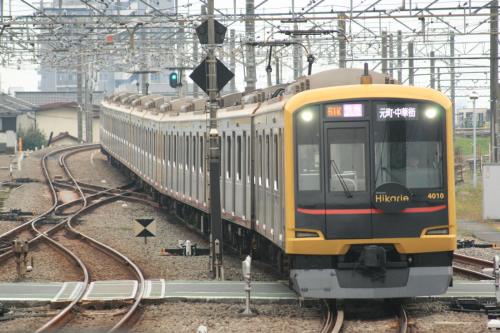
「東横特急」から「Fライナー」へ
18日、2016(平成28)年3月26日より、横浜高速鉄道みなとみらい線・東急東横線・東京メトロ副都心線・西武池袋線・東武東上線直通の最速達列車に「Fライナー」の愛称を付けて運行することが各社から発表された。今回登場する「Fライナー」の運行間隔は、現行の「東横特急」と同じ15分間隔で、西武池袋線方面への列車と東武東上線方面への列車がそれぞれ30分間隔で運行される。「Fライナー」の愛称は、速さを意味する「Fast」、相互直通運転の5社を示す「Five」、副都心線のローマ字表記「Fukutoshin」の頭文字「F」から名づけられた。現在東横線・みなとみらい線を特急(「東横特急」)、副都心線を急行、池袋線を快速急行、東上線を急行の種別で走る列車が「Fライナー」の統一された愛称で呼ばれることとなる。東上線を急行運転する東京メトロ直通列車は今回が初登場となる。以前にもこのブログで書き表した通り(2013(平成25)年6月9日「もしも東急東横線の「特急」を正式に「東横特急」に改称したら」)、僕も直通運転先で別々の種別を名乗る列車に対して、少々ややこしい感を抱き、例えば西武池袋線や東武東上線から副都心線・東横線直通列車に乗車する際に「この電車は東横線では『東横特急』に変わるのだろうか」と不安になる乗客も少なからずいるのではないかと疑問に思う乗客が少なくないと見ていたことから、阪神と山陽電鉄の「直通特急」のような統一された種別への改称を提案した。さらに言えば、2015(平成27)年時点のダイヤでは、東京メトロ副都心線・有楽町線から来た列車は東武東上線ではすべて「各停」に格下げされてしまい、さらにはふじみ野駅で後続の快速列車に抜かれるため、持ち前の速達性を損ねていたことも問題視していた。東横線・副都心線では、直通運転開始当初より、JR東日本湘南新宿ラインと横浜駅~渋谷駅・池袋駅間で競合しており、運賃では東横線・副都心線が優位に立っていたが、所要時間ではわずかに湘南新宿ラインが勝り、東横線・副都心線は横浜駅、渋谷駅、池袋駅のホームがいずれも地下深くにあるため、地上出口までの移動距離でも不利だった。しかしさらに視野を広げて、横浜駅~川越駅間で見てみると、JR東日本では湘南新宿ラインまたは東海道線・上野東京ラインと埼京線を乗り継ぐ必要があるが、「Fライナー」では乗り換えなしであることに加えて、所要時間でも東横線・副都心線・東上線経由が「Fライナー」で74分(推定 現行の東横特急・副都心線急行列車の横浜駅~和光市駅の所要時間と和光市駅での停車時間、東上線急行列車の和光市駅~川越駅の所要時間とを合算 和光市駅の停車時間は1分で計算)であるのに対して、JR東日本では湘南新宿ライン・埼京線経由が90分(横浜駅~大崎駅は湘南新宿ライン特別快速列車利用、大崎駅~川越駅は埼京線快速列車利用 大崎駅での乗り換え時間は5分で計算)、東海道線・上野東京ライン経由が87分(横浜駅~赤羽駅は東海道線・上野東京ライン各停列車利用、赤羽駅~川越駅は埼京線快速列車利用 赤羽駅での乗り換え時間は4分で計算)、運賃でも東横線・副都心線・東上線経由が860円(IC乗車券利用の場合は853円)、JR東日本湘南新宿ライン・埼京線経由および東海道線・上野東京ライン・埼京線経由が1,320円(IC乗車券利用の場合は1,317円 最短経路で運賃計算するためいずれの経路でも運賃は同額)となる。さらには川越駅の東上線ホームは、埼京線と同じ地上にあるため、横浜駅・渋谷駅・池袋駅とは違い、列車を降りてから出口までの移動距離も短い。横浜駅~川越駅間では「Fライナー」が、乗り換え回数、所要時間、運賃、川越駅での出口までの移動距離、いずれでも優勢となる。現行でも東横線・副都心線・東上線直通列車の横浜駅~川越駅の所要時間は83分だが、前述のとおり「Fライナー」では停車駅が少ないことと、ふじみ野駅での待避がなくなることから74分に短縮されることが見込まれるため、さらに優勢となる。僕として気になる点は、東上線でも急行列車となる「Fライナー」が、現行ダイヤで東横線・副都心線からの列車が和光市駅で接続する東上線池袋駅発の急行列車と和光市駅以西のダイヤを交換する形で、森林公園駅まで運行するようになるのかどうかということである。路線図の上では、「森林公園駅まで直通運転」となっているが、森林公園駅まで直通する列車は朝と夜にしか運行されず、しかも東武車による入出庫列車に限られ、東京メトロ車、東急車、横高車による運用がないため、これも実態に合っていないと考えていた。2013(平成25)年3月のダイヤ改正まで、同じ東京メトロの日比谷線では、東武伊勢崎線(東武スカイツリーライン)への直通区間は北千住駅~東武動物公園駅間であったが一部に南栗橋駅発着の列車が運行されていた。しかし南栗橋駅まで運行される列車は、こちらも東武車による入出庫列車のみであり、運行本数も少なかったため、東京メトロの路線図では、日比谷線は「東武動物公園駅まで直通運転」とし、南栗橋駅までは日常的に運行されていないこと、東京メトロ車が南栗橋駅まで乗り入れないことが判りやすかった。「Fライナー」が日常的に森林公園駅まで運行され、名実共に「森林公園駅まで直通運転」となることも、合わせて願いたい。On 18th, Tokyu Corporation, Tokyo Metro, Tobu Railway, Seibu Railway, and Yokohama Minatomirai Railway announced that they would renamed the fastest trains between Motomachi-chukagai Station on Yokohama Minatomirai Railway Line and Kotesashi Station or Hanno Station on Seibu Ikebukuro Line or Kawagoeshi Station or Shinrin-koen Station on Tobu Tojo Line via Tokyu Toyoko Line and Tokyo Metro Fukutoshin Line, which operates as limited express on Yokohama Minatomirai Railway and Toyoko Line, express as Fukutoshin Line and Tojo Line, and as rapid express on Ikebukuro Line, "F Liner", after the initial of "Fast", "Five", and "Fukutoshin Line" on March 26th, 2016. It is also first time that the express train train going through Fukutoshin, Toyoko, and Yokohama Minatomirai Railway Line appears on Tojo Line. "F Liner" runs every 15 minutes, the same as limited express trains on Toyoko Line in the present, and the trains going toward Ikebukuro Line and the other toward Tojo Line does on an every-30-minute basis. As I wrote on June 9th, 2013, I have felt that the trains running over two or more lines and changing its kind at the border of the lines sometimes gives us a sense of incongruity and that makes some passengers confused about whether it changes limited express on Toyoko Line like that of express train on Tobu Isesaki and Nikko Line train changing to local on Tokyu Den-en-toshi Line. To resolve this problem, I suggest that the new unified name of the fastest train on those Lines like "going-through limited express" on Hanshin Electric Railway and Sanyo Electric Railway. In addition, I see that all of the trains going through Tojo Line changes to local and are passed following rapid train at Fujimino Station makes those trains slow down as a problem.Toyoko Line and Fukutoshin Line competes JR Shonan-shinjuku Line between Yokohama Station and Ikebukuro Station since the going-through service started. Though the fare of Toyoko Line and Fukutoshin Line is inexpensive, Shonan-shinjuku Line train is little faster than those and the platform for Toyoko Line and Fukutoshin Line at Yokohama, Shibuya, and Ikebukuro are located at deep under the ground, which makes passengers walk little long distance from the entrance of the station. However, seeing a larger area, "F Liner" can serve the travel between Yokohama Station and Kawagoe Station with no transfer, more inexpensive fare, and faster. It takes 74 minutes (estimated from the present timetable of limited express on Toyoko Line, express on Fukutoshin Line, and express on Tojo Line and one-minute stopping time) and 860 yen (IC card fare 853 yen). On the other hand, the travel by JR Lines needs a transfer at Osaki, in case of via Shonan-shinjuku Line, or AKabane, in case of via Tokaido and Ueno-tokyo Line, to Saikyo Line, it takes about 1 hour and an half and costs 1,320 yen (IC card fare 1,317 yen) in both routes. Furthermore, different from Yokohama, Shibuya, and Ikebukuro, Tojo Line platform at Kawagoe Station is located on the ground, the same level as JR East's, which makes people's walking from the train to the station exit shorter."F Liner" can shorten its travel time than the present to decrease the stopping stations and stop waiting for the following train passing.One more what I wonder is "F Liner" operation is being extended to Shinrin-koen Station using the way to exchange the timetable of the train from Toyoko and Fukutoshin Line and the express train from Ikebukuro on Tojo Line connecting to the former at Wakoshi. Though the railroad map says Fukutoshin Line trains go through Tojo Line to Shinrin-koen Station, the train for Shinrin-koen from Fukutoshin Line operates in the morning and evening only and all of them does by Tobu carriages, which doesn't match the reality.In case of Hibiya Line before March 16th, 2013, some Hibiya Line trains went through Tobu SKYTREE Line to Tobu-dobutsu-koen(Tobu Zoo and Amusement Park) Station, but some trains by Tobu carriage operated from Minami-kurihashi. The map of Tokyo Metro said Hibiya Line train did to Tobu-dobutsu-koen, which made passengers easy to understand the trains by Tokyo Metro carriage didn't go through and the daytime operations didn't to Minami-kurihashi.I also wish "F Liner" regularly operates from/to Shinrin-koen Station to solve the problem on map. 東急電鉄 プレスリリース 2015年12月18日「東武東上線・西武池袋線 ~ 横浜高速みなとみらい線間を運転する速達性の高い直通列車の愛称名を『Fライナー』といたします。」
Dec 27, 2015
コメント(0)
-

東急田園都市線 6ドア車置き換えは2016年1月から
東急電鉄では、田園都市線ホームドア設置・6ドア車置き換え計画の次なる段階として、去る12月8日より、5000系6ドア車組み込み編成で運行されてきた朝ラッシュ時の列車を、順次全車4ドア車編成への変更して運行し、さらに5000系の一部編成に連結されている6ドア車を置き換える4ドア車の新造を始めた。東急電鉄では、2020(平成32)年までに田園都市線・東横線・大井町線のすべての駅へのホームドアの設置を進めているが、田園都市線では4ドア車と6ドア車とが混在していることから、4ドア車で揃えられた東横線・大井町線と比べてホームドアの設置が遅れている。2015(平成27)年10月に宮前平駅に田園都市線の駅として初めてホームドアが設置された。ただし6ドア車が現役のままの状態で4ドア車の基準でホームドアが設置されたことから、6ドア車の側扉とホームドアとのずれを解消するため、列車とホームドアの間に移動空間を確保し、6ドア車でも乗降可能にした。今回新たに投入される4ドア車両は、6ドア車と同様の、モーターのない付随車(サハ)となり、これまでの5000系4ドア車を基本としつつも、より快適な車内空間を目指し、4000系4110F「Shibuya Hikarie号」で採用されたハイバック仕様の座席、5000系では初採用となる17インチの液晶画面(「TOQビジョン」)、2段手すり付きのフリースペースなどの改良点が見られる。これらの4ドアサハ車の内装のイメージイラストを見てみると、座席袖仕切りから出ている手すりが通路上部まで回り込み、ドア部枕木方向のものと一体化していないことから、「sustina」ではないとも見える。12月22日から23日にかけて、実車が神奈川県・横浜にある金沢文庫の総合車両製作所横浜事業所から長津田へと回送された。回送されたのは5117F用と5120F用の合計6両。同車を組み込んで生まれ変わる5117Fと5120Fは2016(平成28)年1月22日より営業運転を開始する予定となっている。2017(平成29)年度中までに置き換えを完了させる予定でいる。2015(平成27)年5月発表の事業計画でも、6ドア車置き換えについて触れられていたが、この度実車がお目見えし、いよいよ東急田園都市線から、5000系から6ドア車が姿を消そうとし、同時にこの先、東急電鉄各駅へのホームドアの設置がより本格的に進められようとしている。From December 8th, Tokyu Corporation started to change the carriages for Den-en-toshi Line trains on the weekday morning from the sets including 6-doored ones to all 4-doored. The 4-doored carriages to replace the 6-doored ones started to be built.Tokyu Corporation plans to install the automatic platform gates in all stations on Toyoko, Oimachi, and Den-en-toshi Lines by 2020. However, especially on Den-en-toshi Line, both 4-doored and 6-doored carriages are in service, it had been said it was hard to install because of the gap of the interval of the gates and 6-doored carriage. On October, 2015, the gates are installed in Miyamaedaira Station, which was first time to be installed them in Den-en-toshi Line station, but the gates and the carriage are separated to make the room for persons' moving from the 6-doored carriages.The newly-built 4-doored carriages are the trailers and their interior has some improvements, such as seatings with high backrest, 17-inch LCDs(TOQ Vision), space for luggage or baby buggy/pushchair with two different height grab handles. As seeing the image of the interior, the grab handle from the end plate of the seatings don't unify the transverse one laid out over the aisle, so they aren't built by "sustina" method.From December 22nd to 23rd, the first 6 carriages for 5117F set and 5120F set are shipped from J-TREC factory in Yokohama, Kanagawa Prefecture, to Nagatsuta train shed. The two sets coupled with the newly-built ones are starting from January 22nd, 2016. The more 39 carriages continues to manufacture by 2017.According to a press release on May, 2015, the plan for replacement of 6-doored carriages was treated. The appearance of the carriages leads the retirement of the 6-doored ones and the installment of the gates in more stations.東急電鉄 プレスリリース 2015年12月7日「田園都市線6ドア車を、順次4ドア車に置き換えて運転します」交友社「鉄道ファン」鉄道ニュース 2015年12月24日 「東急5000系6扉車置換え用の4扉車が甲種輸送される」
Dec 26, 2015
コメント(0)
-
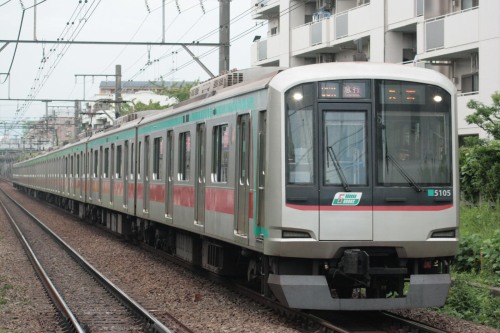
東急が出した答え 「列車とホームドアをずらす」
9月25日、東急電鉄が田園都市線宮前平駅にホームドアを設置することを発表した。田園都市線の駅にホームドアが設置されるのは今回が初めてである。これまで田園都市線では、20m4扉車と同6扉車が混在するため、多数派の4扉車の規格で駅にホームドアを設置してしまうと5000系6扉車がホームドアと乗降口が揃わない問題が発生するため、設置が実現していなかった。この問題をどう解決するかが多くの鉄道ファンから注目された。東急電鉄が打ち出した解決策は「列車とホームドアの間に人が通れるスペースを作る」というものだった。これまでのホームドアは、ホームの端ギリギリに設置されていたため、ホームドアと車両扉の位置がずれている車両は停車できなかった。これをホームの端ギリギリではなく、端よりも内側にホームドアを設置することで、列車とホームドアとの間にスペースを作り、ホームドアからずれた車両扉へ乗降客が移動できるようにするというもの。今回宮前平駅に設置されるホームドアは、20m4扉車の規格で設置され、ホームドアの1番扉で6扉車の1番扉、2番扉で2番扉と3番扉、3番扉で4番扉と5番扉、4番扉で6番扉の乗降客を捌くというものである。本来の目的とは違うが、結果としてホームドア(安全柵)を列車から離して複数の扉位置の規格に適合させる例としては、通過線(通過列車専用のホームから離れた線路)がない新幹線の駅(熱海駅、新神戸駅、安中榛名駅など)や、名鉄空港線中部国際空港駅のホームドアがある。新幹線の駅に設けられた安全柵は、高速で通過する新幹線列車の「列車風」と呼ばれる強風によるホーム上での事故を防ぐために、列車(ホーム端)とホームドアが離れて設置されている。中部国際空港駅に設置しているスクリーン式(全高式)ホームドアは、主な目的は風避けで、列車の扉位置とも関係なく設置され、当然列車の扉の開閉とも連動しない。人を感知すると自動でホームドアが開く仕組みになっている。車両のドアとホームドアの位置が揃わないことから、ホームの端ギリギリではなく、列車との距離を置いている。これらは結果として、ホームドアと列車の間のスペースを利用客の移動空間として機能させ、扉位置が異なる車両に対応するものとなったと言える。6扉車置き換え期間中の山手線恵比寿駅・目黒駅と同様の6扉車が停まる位置にホームドアを設置しない案や、かつてつきみ野駅で実証実験されたロープ式ホーム柵を設置する案など、様々な噂が出回ったが、東急電鉄は既製品のホームドアを使用して難題を乗り越えた。宮前平駅のホームドアは9月26日終電後に設置され、10月中旬に稼働開始する予定となっている。今後、通勤型車両と特急型車両が混在する路線など、複数の異なる扉間隔の車両が走る路線の駅にも広まることを願う。On September 25th, Tokyu Corporation announced that automatic platform gates are being laid out at Miyamaedaira Station on Den-en-toshi Line.It is said that installment of the gate at the stations on Den-en-toshi Line is hard because of the 6-doored carriages. If the gate would be put matching position of the doors of the 4-doored carriage, the ones of 6-doored carriage couldn't meet the gate. Many railfans has paid attention how to solve this problem.The solution Tokyu developed was the gates are being installed little further away from the train; making the room between the train and the gate to allow people to move between them even if the train doors don't meet the gate.The gates at Miyamaedaira Station is laid out the position of the doors of the 4-doored carriages. When the 6-doored carriage comes, the middle two of the the four gates facing a 6-doored carriage handles the passengers for the middle four carriage doors.The cases similar to it to adapt the plural interval of the train doors are seen at some stations on Shinkansen not having the track for the passing train, such as Atami, Shin-kobe, and Annaka-haruna Stations, and Central Japan International Airport Station on Meitetsu Airport Line, Aichi Prefecture.Though the main purpose of the gates at Shinkansen stations is to protect people from the strong wind when the train passes at high speed, and Central Japan International Airport Staiton's platform screen doors are laid out to protect people from the sea breeze, whose interval is completely different from the one of the train doors and which works when people stands in front of it, the blank consequently functions the room for people walking and the way of the installment of the gate and the platform screen doors enables the two or more different standards of the train carriages.Before the news announced, some rumours, such as partial installation avoiding 6-doored carriages like Ebisu and Meguro Stations on Yamanote Line during both carriages used to exist or introduction of guard ropes used to be experimented at Tsukimino Station in 2013, must be floated among the railfans. The gates at Miyamaedaira Station were installed on the midnight of September 26th after the last train and started to work in the middle of October.I wish the way of the gate installment spreads to the another railway lines existing both commuter type and limited express type.東急電鉄ニュースリリース 2015年9月25日 「田園都市線初!宮前平駅にホームドアを設置します!」 (Japanese)交友社 「鉄道ファン」鉄道ニュース 2015年9月28日 「田園都市線宮前平駅にホームドア設置」 (Japanese)
Sep 30, 2015
コメント(0)
-
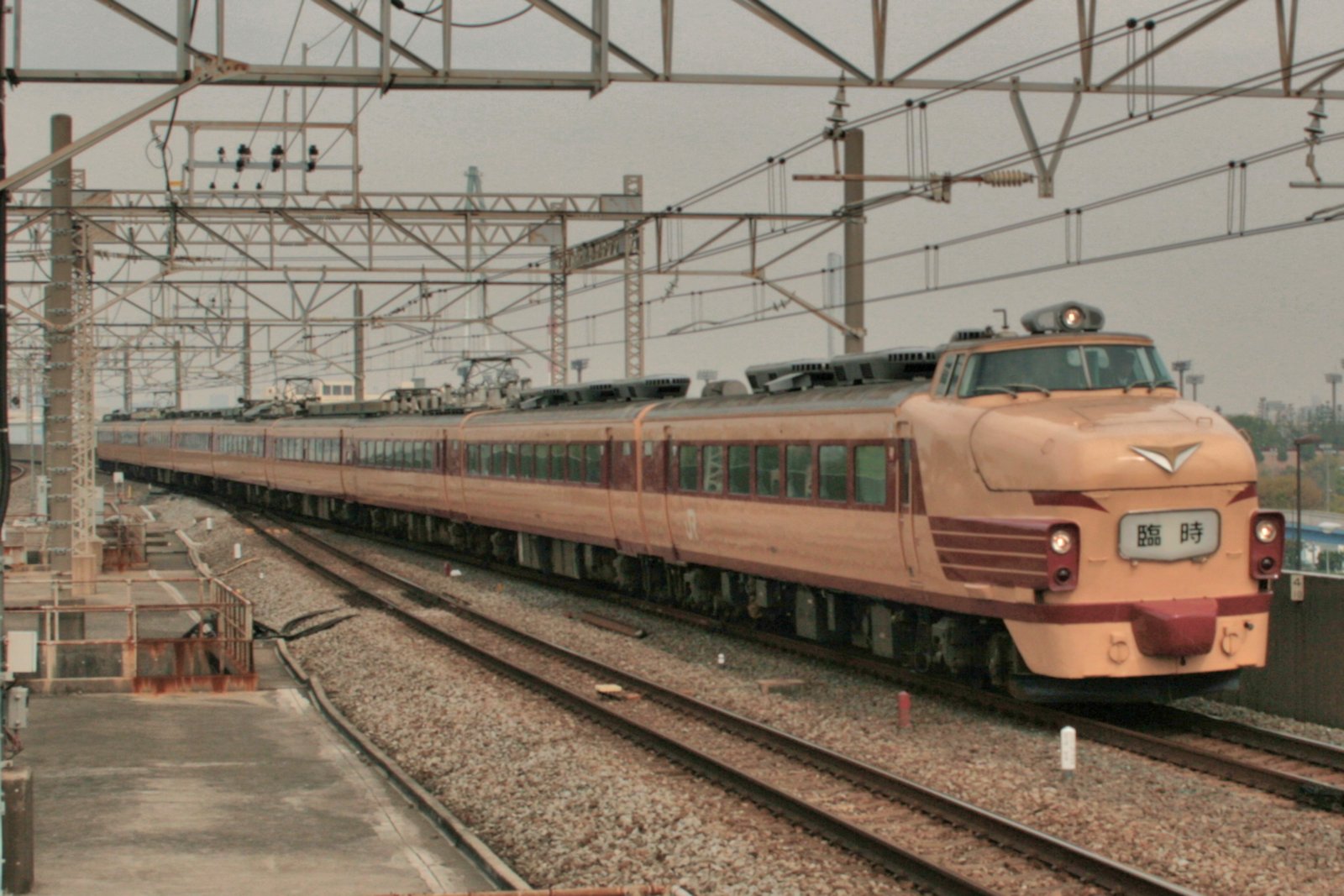
五島慶太社長が唱えた国鉄民営化
日本での「国鉄民営化」といえば、1987(昭和62)年4月1日に、日本国有鉄道(国鉄)が、北海道・東日本・東海・西日本・四国・九州のJR旅客6社と日本貨物鉄道(JR貨物)、鉄道総合技術研究所などに解体され、民営化したことを指す。1987(昭和62)年3月、国鉄は1964(昭和39)年度に初めての単年度赤字を経常して以来、累積債務を積み重ね37兆1000億円という巨額の借金を抱えて経営破綻した。しかしこれより遥か昔の1958(昭和33)年、東京急行電鉄の創業者である五島慶太さんは、国鉄の民営化論を唱えていた。猪瀬直樹さんの著書「土地の神話」は、五島社長の国鉄民営化論をこう書き表している。『国鉄は民間会社のように株主総会で経営を批判される機会がない。大きすぎるから幹部の意志が末端まで行き届かない。株式会社として十社ほどに分割したら各地区ごとに競争も生まれ、地域に応じた創意工夫も出る。沿線に全国で何百というバス会社の経営を許可しているが、それが乗客を奪っている。民間にすればすすんでバス会社を買収するだろうから、赤字も減る。中央政治を反映して僻地に路線が伸びてはいるが、採算を無視している。民間なら不採算線はバスに変える。それぞれの地域格差から、ストライキに対する考え方も変わってくるし、組合員も企業内容を理解しやすくなるので、無茶なストをしなくなる。企業が小さければ労使間の相互理解も出てくる……』公共企業体(国営企業)としての日本国有鉄道が1949(昭和24)年6月1日であるため、五島社長はそこからわずか9年後に、永田町の政治家達や霞ヶ関の官僚達よりも先に、早くも民営化の必要性を説いたのである。のちに国鉄の経営破綻へと導く要因の一つである政治の影響力の完全な排除、および職員のストライキ・順法闘争に端を発する列車の運休・ダイヤの大幅な乱れによる利用客の不満の爆発の軽減の必要性に気づいていたのであると言える。また「土地の神話」によると、五島社長は独占禁止法の施行を前に「大東急」を現在の東京急行電鉄・小田急電鉄・京浜急行電鉄・京王電鉄に分離することに反対の姿勢をとっていたが、分離推進派の小田急・京急・京王系の労働組合と、五島社長の邸宅に陳情しに押しかけられるほど激しく対立したため、五島社長も次第に分離やむなしに姿勢を変えていったという。五島社長の国鉄民営化論の背景には、自らが買収・合併を繰り返して造り上げた「大東急」の解体をめぐる買収・合併した各社の労働組合との対立が背景にあったと言える。「大東急」と同様に、肥大化した国鉄も事業規模を独占禁止法に触れない程度に、そして労使対立が激しくならない程度に適正化し、地域の実情にあった鉄道経営を成り立たせることができるという思いがあったのだろう。そもそも国鉄の公共企業体化は、GHQが当時の運輸通信省の海運総局と鉄道総局(旧鉄道省)との業務の違いを指摘したことが発端である。海運総局は監督業務のみであったが、鉄道総局は監督業務に加えて現業(直営の鉄道事業)があることが不公平であるとして、直営から分離することが望ましいとした。この時点でも民営化されることも検討されたが、全国津々浦々まで行き届く鉄道ネットワークの維持は利潤を追求しようとすることが難しいという考え方から、国営の道を選んだ。しかし蓋を開けてみると、各年度の予算は国会の承認を必要としたり、国鉄を運輸大臣の監督下に置き、トップである総裁を内閣が任命するなど、過度に政治や法律による制限を受け、さらには「公共性」の名のもとに採算性を無視した地方への新路線建設を次々と推し進めたことから、独立採算による経営の政府からの独立とはかけ離れたものとなった。これらに加えて公共企業体等労働関係法(現在の行政執行法人の労働関係に関する法律)で、国鉄職員によるストライキが禁止されていたことや生産性向上運動、いわゆるマル生運動による労使関係の悪化が、列車のノロノロ運転に代表される順法闘争へとつながり、上尾事件や首都圏国電暴動などの利用客による列車襲撃事件を引き起こした。運輸通信省からの経営分離を実現させたのは見かけだけであり、結果として37兆1000億円という巨額の借金を抱えて経営破綻した。背景には自主的な経営の未確立、労使対立の悪化、採算を無視した地方路線の過大な建設があったことは二度言うまでもない(鉄道ファンの常識である)。もしも国鉄が、元鉄道省官僚であった五島社長の独り言を助言を聞き入れ、民営化が実現していたら、JRは一体どうなっていたことだろうと、僕は物思いにふける。Privatization of Japan National Railway (JNR) happened on April 1st, 1987; being broken up into 6 JR passenger railway companies, Hokkaido, East Japan, Central Japan, West Japan, Shikoku, and Kyushu, Japan Freight Railway, and Railway Technical Research Institute, etc.. JNR went bankrupt under the burden of 37-trillion-100-billion-yen debts.However, in 1958, Keita Goto, founder of Tokyu Corporation and a former Railway Ministry bureaucrat, advocate the privatization of JNR."Tochi no Shinwa (the Myth of the Residential Area in the Soil)", authored by Naoki Inose, partly features his own opinion. He criticized its unprofitable management, the large size of its business, which made a lack of communication between the bosses and the employees and shift of passengers to buses. To remove the political intervention completely, to review the size of the business, to compete between bus companies, and to keep good relation between capital and labour not to go on crazy strike, which made the delay of trains and made some passengers angry, he presented that JNR needs the privatization and separation into about 10 companies.This book also said that his opinion was inspired by his experience; Goto has required the separation of his company into Tokyu, Odakyu, Keikyu, and Keio, the last three of which were merged into, by some his employees from these acquired companies, but he first objected to it. As the men came to his house to make the petition, he gradually changed his attitude. To adopt the same method, Goto dreamed of a new railway business which was reflected by each region's character.JNR state enterprise was established to independent from Transportation Ministry under GHQ's advice about the difference of the work of the Marine Transportation Department and Railway Department of the Ministry. The former one was the only supervising ship, but the latter one was both supervising and direct operation of the railway. At that time the privatization was also considered, but it was very difficult for the private company to maintain the railway network all over Japan. However, some acts of the enterprise were limited by the governmental system and the law. the budget had to pass the Diet's agreement, kept being supervised by Transportation Ministry and the president was appointed by the Cabinet. Also, unprofitable lines were continuously constructed under Government's "public benefit".The strike by JNR staffs was prohibited by Public Corporations and Government Enterprises Labor Relations Act and training of staffs to comply with the management made the relation between them bad, which leads the train attack by passengers or persons at stations caused by the train's delay by driver's purpose to require the right of the strike.If JNR should have adopted his opinion on that time, those privatized companies would move through a different history from the present JR?
Jul 14, 2015
コメント(0)
-
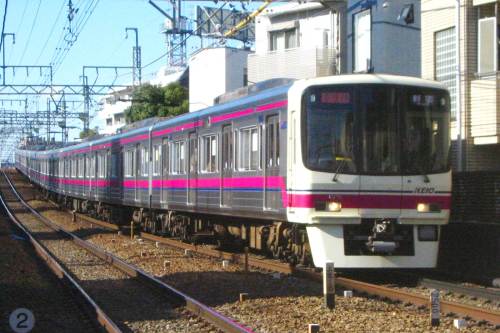
京王線に有料特急登場か!?
5月8日、京王電鉄が2010(平成22)年以来5年ぶりとなる中期経営計画を発表し、その中の一つに、京王線への有料特急の導入を検討すると書かれていた。京王電鉄は関東の大手民鉄では、東急電鉄、相模鉄道と共に、有料特急(整理券制の通勤ライナー列車を含む)がない鉄道事業者である。各社とも東京または横浜の都心部と郊外の住宅地とを結ぶ通勤路線色が濃い。京王線で有料特急列車の導入が検討されている背景には、平日は通勤利用客向けに着席を約束する通勤ライナー列車、また土休日には高尾山への観光客向けの行楽列車の需要が高まっているためであると言われている。この有料特急計画は、先日グリーン車を増結して2015(平成27)年現在の10両編成から12両編成になることが発表された、京王線の「永遠のライバル」とも言うべきJR中央線、そして新宿駅~多摩ニュータウン間の輸送で競合する小田急電鉄の特急「ホームウェイ」に対抗する手段とも見てとれる。京王線は新宿駅~八王子・多摩ニュータウン間の通勤電車という性格が強いが、土休日には高尾山への観光路線にもなる。小田急電鉄にとっての箱根、東武鉄道にとっての日光・鬼怒川、西武鉄道にとっての秩父と同様に、京王電鉄にとって高尾山は、沿線の、ことに路線の終着駅が玄関口となる魅力的な観光地である。実際、高尾山は新宿駅から京王線一本で行けるアクセスの良さから、「最も登山客が多い山」であり、近年は外国人観光客も多く訪れている。今年2015(平成27)年4月に高尾山口駅のリニューアルが完成したが、これは観光地としての高尾山の魅力向上の一環とも言える。高尾山という有名観光地を終点に抱えていながらも、観光輸送向けの特急列車がなかった京王電鉄であるだけに、高尾山口駅への有料特急の運行は、この次なる一手と言えよう。もう一つ、僕個人としては、この有料特急車両が、20m4扉車基準で設けられたホームドアに対応する特急型車両としての標準車両と位置付けられ、「通勤・近郊電車の標準仕様ガイドライン」と共に、特急電車の標準化ガイドラインの策定に繋がる車両となることに期待している。京王線では、京王線新宿駅、国領駅、布田駅、調布駅にホームドアが2015(平成27)年現在設置され、京王電鉄管轄の新線新宿駅を含む都営新宿線の各駅にも設置が予定されているため、これらの駅に停車させるにはホームドアに適合した位置にドアを配さなければならない。全国の鉄道駅へのホームドア設置を要望する声が聞かれるが、小田急電鉄や東武鉄道、西武鉄道などの有料特急が走る路線では、通勤型車両と特急型車両でドアの位置が異なることが足枷となり、設置が進んでいないのが現状である。京王線特急型車両がホームドアに適合した寸法で登場することで、20m4扉の通勤型車両の基準でホームドアを設置した、もしくはこれから設置しようとしている多くの路線で、この車両と同じ寸法を採り入れた特急型車両が登場し、ホームドアの設置も加速するものと予想する。Keio Corporation announced the business plan in three years incorporating introduction of the limited express train service on which passengers needing additional fee to ride. Keio Corporation is known as one of the major railway companies without the train additional fee being required in Kanto Area together with Tokyu Corporation and Sagami Railway, all of which have an image of commuter train linking the metropolitan area in Tokyo or Yokohama and their suburb residential area.It is said that some passengers need the trains to guarantee their seatings and faster travelling time for the commuters on the weekday morning and evening and for the Mt. Takao climbers on holidays.This project must be seen the way to compete with JR Chuo Line, which runs almost in parallel between Shinjuku and Takao and adding two Green Cars was announced, and Odakyu Line, competing between Shinjuku and Tama New Town.Though Keio Line has a strong image of a commuter train between Shinjuku and Hachioji or Tama New Town, it functions as a tourist train to the foot of Mt. Takao. For Keio Corporation the mountain is the most attractive spot closing to the terminal station, as well as Hakone for Odakyu Electric Railway, Nikko and Kinugawa for Tobu Railway, and Chichibu for Seibu Railway. Actually, Mt. Takao is the mountain drawing the most number of climbers, as well as those from foreign countries. Following the refurbishment of Takaosanguchi Station, the entrance of Mt. Takao, in this April, the project seems to be the second step to attract more tourists.In my opinion, the new carriage for the new service can become the one to match the platform screen doors laid out based on the interval of 4-doored 20-metre(65.617-foot)-long carriage, which also make a new standard of those for the limited express service as well as the guideline for the unification of the specification of commuter train carriages. To run on Keio Line, the new carriage has to match the layout of the automatic platform gates or platform screen doors on Shinjuku (Keio Line Shinjuku), Kokuryo, Fuda, and Chofu Stations, and planning to install on New Line Shinjuku Station as well as the stations on Toei Shinjuku Line. The difference of the number and interval of the carriage doors make it difficult to install the platform gates such as the stations on Odakyu, Tobu, and Seibu, where both commuter and limited express trains are in service. To introduce the same size, same layout carriage as the Keio's one seems to solve the problem on the other lines to install the gates.京王電鉄 「京王グループ中期3カ年経営計画(2015年度~2017年度)~向上と拡大に向けて~の策定について」 2015年5月8日
Jun 6, 2015
コメント(0)
-
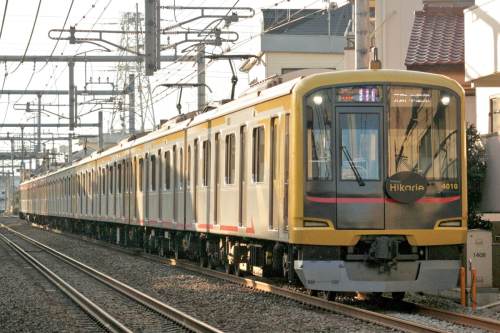
東急電鉄 2015年度はホームドア設置などに注力 2年連続で新造車ゼロ?
5月13日、東急電鉄が2015(平成27)年度の事業計画を発表し、ホームドアの設置や、踏切に設置された障害物センサーの更新、東横線祐天寺駅の通過線新設を含む改良工事の継続、池上線五反田駅付近の橋梁の改良工事などを盛り込んだ。車両の新造については触れられず、2014(平成26)年度に続いて2年連続で新造車ゼロとなりそうだ。今年度中(2016(平成28)年3月)までに、東横線都立大学・新丸子・元住吉・菊名、大井町線溝の口、田園都市線宮前平の各駅などにホームドアが新設される予定である。注目すべきは、田園都市線の駅として初めて宮前平駅にホームドアが設置されることだ。現状の田園都市線は4ドア車と6ドア車とが混在しているため、新造車ゼロでホームドアを設置しようとなると、JR山手線に4ドア車と6ドア車とが混在していた期間の恵比寿駅・目黒駅のように6ドア車の停止位置にはホームドアを設置しないか、2013(平成25)年につきみ野駅で実験された昇降ロープ式安全柵を設置するかのどちらかの手が打たれるものと見られる。車両に関しては、新造車はゼロと見られるものの、2015(平成27)年1月9日発表のホームドア設置のプレスリリースにて田園都市線5000系の6ドア車全廃が発表されているため、これら6ドア車(サハ5400形、サハ5500形、サハ5800形)の一部が4ドア化改造の扱いで、また2014(平成26)年の追突事故で使用不能の状態が続いている東横線5050系5155Fのデハ5755号車とクハ5855号車を修理扱いで、車体を新製すると予想する。また池上線・多摩川線への1000系リニューアル車(1500番台車)の追加投入も進むと見られ、これらに置き換えられる形で7700系の一部が廃車になるとも予想する。前年度2014(平成26)年度の予想で外れた、2代目となる東横線4000系デハ4600形4601~4604号車、同5050系サハ5450形5470号車・5471号車、サハ5550形5570号車・5571号車をそれぞれ新製し、2015(平成27)年3月現在東横線に在籍している5000系5118F、5119F、5121F、5122Fを、元来田園都市線用として新造された初代デハ4601~4604、サハ5470・5471、サハ5570・5571を組み込んで10両編成化し、田園都市線5000系のオール4ドア化工事期間中の予備車として転属させる準備が整われるとも予想する。On May 13th, Tokyu Corporation announced the business plan by March, 2016, incorporating installation of automatic platform gates, renovation of obstacle detection sensors at crossings, refurbishment of Yutenji Station on Toyoko Line including new track for passing trains, and restoration of the bridge around Gotanda Station on Ikegami Line. Following the last year, the plan doesn't say how many carriages are newly built.Where the gates are planning to be installed are Toritsu-daigaku, Shin-maruko, Motosumiyoshi, Kikuna, Mizonokuchi, and Miyamae-daira. The notable point is Miyamae-daira on Den-en-toshi Line, where both 4-doored and 6-doored carriages are in service. If there should be no newly-built carriages, the other measure, such as partial installation avoiding 6-doored carriages like Ebisu and Meguro Stations on Yamanote Line during both carriages used to exist or installation of guard ropes used to be experimented at Tsukimino Station in 2013, must be taken to because of the difference of the layout of carriage doors.Though the announcement doesn't include the new construction of the carriages, some of 6-doored carriages may change its body to 4-doored ones because of the disappearance of these 6-doored carriages as the press release on January 9th, 2015, about the automatic platform gates says and the body of Deha 5755 and Kuha 5855 of 5050 Series 5155F set may be built as a restoration from an crash accident in 2014. In addition, refurbished 1000 Series (1500 Series) replace 7700 Series on Ikegami Line and Tamagawa Line as last year.Though my expectation last year became wrong, I expect the same one; four second Deha 4600 (4601 - 4604) and four Saha 4700 (4701 - 4704) of 5050-4000 Series and two Saha 5450 (5470, 5471) and two Saha 5550 (5570, 5571) should be constructed to replace the present ones moved from Den-en-toshi Line together with four 8-carriage 5000 Series on Toyoko Line, 5118F, 5119F, 5121F, and 5122F, which should come back to prepare for extra carriage while some carriages of 5000 Series on Den-en-toshi Line under conversion, in the near future. 東京急行電鉄プレスリリース 2015年5月13日 「2015年度の鉄軌道事業設備投資計画ホームドア設置や駅機能の向上などに総額482億円」
Jun 1, 2015
コメント(0)
-
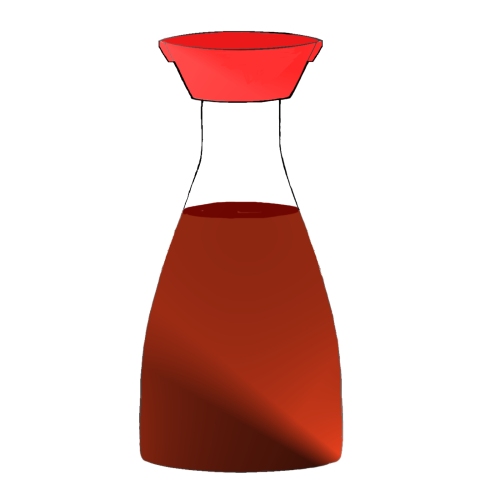
榮久庵憲司さんが遺したもの
2015(平成27)年2月8日、工業デザイナーで、JR東日本などの鉄道車両のデザインにも多く携わった榮久庵憲司さんが死去した。死因は洞不全症候群。85歳だった。榮久庵さんは1929(昭和4)年、東京都生まれ、広島県育ち。1955(昭和30)年に東京芸術大学を卒業した後、1957(昭和32)年にGKインダストリアルデザインを設立。自ら代表となる。1960(昭和35)年、キッコーマンの醤油卓上びんのデザインを担当した。その後、日本万国博覧会(大阪万博)の「ストリート・ファニチャ」統括責任者や国際科学技術博覧会(つくば科学博) 会場施設デザイン専門委員に就任し、国民的イベントのデザインにも携わった。GKインダストリアルデザイン代表を務める傍ら、社団法人日本インダストリアルデザイナー協会理事長、第8回世界インダストリアルデザイン会議実行委員長、国際インダストリアルデザイン団体協議会会長、第2回国際デザインフェスティバル総合プロデューサー、世界デザイン博覧会総合プロデューサー、Design for the World(世界デザイン機構)会長、国際インダストリアルデザイン団体協議会(International Council of Societies of Industrial Design)名誉顧問、日本デザイン機構会長、道具学会名誉会長を歴任し、日本国内における「インダストリアルデザインの第一人者」と言うべき人物として活躍した。榮久庵さんの代表作と言える存在が、キッコーマンの醤油びん。イメージイラスト illustration of the soy sauce bottleこのびんに入れられた醤油は1961(昭和36)年の発売以来、「こぼれにくい醤油びん」として50年以上もデザインを変えずに愛されている日本を代表する醤油と言える。しかし、僕、花見友紀にとって榮久庵さんといえば、鉄道車両のデザインを多く手がけた人物というイメージが強い。特に1990年代以降のJR東日本の車両を数多く手がけ、東京近郊の通勤型電車・特急型電車のイメージを変えた。榮久庵さんがデザインした鉄道車両 The carriages designed by EkuanJR東日本253系電車(1991(平成3)年) JR East 253 Series "Narita Express" in 1991JR東日本209系電車(1992(平成4)年) JR East 209 Series in 1992JR東日本255系電車(1993(平成5)年) JR East 255 Series "Sazanami", "Wakashio" and "Shiosai" in 1993JR東日本E217系電車(1994(平成6)年) JR East E217 Series in 1994広島高速交通6000系電車(1994(平成6)年) Hiroshima Rapid Transit 6000 Series in 1994JR東日本E3系新幹線電車(1997(平成9)年) E3 Series Shinkansen "Komachi" in 1997広島電鉄5000形電車(1999(平成11)年) Hiroshima Electric Railway 5000 Series "Green Mover" in 1999JR東日本E231系電車(2000(平成12)年) E231 Series in 2000富山ライトレールTLR0600形電車(2006(平成18)年) Toyama Light Rail TLR0600 Series in 2006JR東日本E233系電車(2006(平成18)年) E233 Series in 2006そのほか、千葉都市モノレール0形電車(2012(平成24)年)、札幌市電A1200形電車(2013(平成25)年)、ゆりかもめ7300系電車(2013(平成25)年)などのデザインに携わった。On February 8th, Kenji Ekuan, an industrial designer who had created many of railway carriages, mainly those of JR East's after the 1990s, died at the age of 85 due to sinus syndrome.Ekuan was born in Tokyo, 1929, and grew up in Hiroshima. After he graduated from Tokyo National University of Fine Arts and Music, he established GK Industrial Design in 1957 and took office as its president.In 1960 he created a bottle of soy sauce, which became the most famous his work, from Kikkoman.After that, he used to concerned with the design of street furniture of EXPO '70 and the chairperson of the event place design committee of Tsukuba EXPO '85.Besides his president status, he also had been the chairman or a member of many industrial design committees. He had taken the Elected President of JIDA (Japan Industrial Designer’s Association), Executive Chairman of the Organizing Committee for ICSID ’73 Congress, Kyoto, Elected President of ICSID (International Council of Societies of Industrial Design), Member of the Steering Committee for The National Museum of Modern Art, Tokyo, Executive Producer of the Osaka Design Festival ’85, Co-General Producer of the World Design Exposition ’89, Nagoya, Chairman of the “Design - Up” committee for Tokyo Metropolis, member of the Traditional Craft Industries Council. Soon before his death, Chairman of Design for the World, Senator of ICISID, Chairman of the Japan Institute of Design, Honorary chairman of the Forum Douguology. He was a so-called pioneer of industrial design in Japan.The most famous his work can be the bottle of Kikkoman's soy sauce, which had been beloved since 1961, as the design for preventing the spilling-over and its design hasn't changed.From my point of view, Ekuan is a designer of many railway carriages, such as 253 Series "Narita Express" (in 1991), 209 Series (in 1992), 255 Series "Sazanami", "Wakashio" and "Shiosai" (in 1993), E217 Series (in 1994), Hiroshima Rapid Transit 6000 Series (in 1994), E3 Series Shinkansen "Komachi" (in 1997), Hiroshima Electric Railway 5000 Series "Green Mover" (in 1999), E231 Series (in 2000), Toyama Light Rail TLR0600 Series (in 2006), and E233 Series (in 2006). The carriages, especially those of JR East after the 1990s, change the image of the commuter and express trains in Tokyo.He also designed Chiba Urban Monorail 0 Series "Urban Flyer" (in 2012), Sapporo Municipal Tramway A1200 Series (in 2013), and Yurikamome 7300 Series (in 2014).GKインダストリアルデザイン 2015年2月10日 「GKデザイングループ代表 榮久庵憲司は、病気療養中のところ、平成27年2月8日 午前3時57分、洞不全症候群のため永眠いたしました。」(Japanese)GK Industrial Design Announcement on February 10th, 2015 "At 3:57 a.m. on February 8, 2015, our chairperson Kenji Ekuanpassed away of sick sinus syndrome, while being hospitalized, at theage of 85. "
Feb 9, 2015
コメント(0)
-

田園都市線も6ドア車全廃へ 東急電鉄のホームドア設置計画見直し
先日、東急電鉄が東横線・田園都市線・大井町線のすべての駅にホームドアを設置する計画の完了予定を10年以上前倒しして、2020(平成32)年までに整備すると発表した。中でも注目すべき点は田園都市線で、5000系に連結されている6ドア車45両をすべて4ドア車に置き換えることが同時に発表された。田園都市線は東急で最も朝ラッシュ時の混雑率が高く、かねてから混雑緩和への対策が実施されてきた。その一環として乗降時間の短縮を狙って2005(平成17)年より6ドア車(サハ5400形・サハ5500形・サハ5800形)を5000系に順次組み込み、朝ラッシュ時の準急列車に集中的に投入した。最も混雑が激しい渋谷駅では、平均で3秒停車時間が短縮されるなどの効果をあげ、乗客からも「乗り降りしやすい」「ほかの車両よりも空いている気がする」「もっと導入してほしい」などの声が聞かれたという。その結果、田園都市線に4ドアの車両と6ドアの車両とが混在することとなり、これが東急全駅にホームドアを設置する目標への最大の課題となってしまった。そこで2013(平成25)年から約1年間、日本信号が製造した、車両のドア数が違っていても対応できる昇降ロープ式ホーム柵の実験を田園都市線つきみ野駅で実施した。田園都市線ではこの高い混雑率と、今でも乗客が増加し続けていることから6ドア車が必須であり、ロープ式ホーム柵がつきみ野以外の駅にも設置される見通しかと見られた。しかしロープ式ホーム柵は実験段階であることに変わりがなく、早期導入には目黒線各駅や東横線渋谷駅などで実績のある腰高のホームドアが選ばれた。この10年間は、5000系を巡って東急電鉄の方針が二転三転した。前述の通り2005(平成17)年に6ドア車を2両連結した編成が運転開始、2009(平成21)年にはそれまでの2両から3両に増やした編成も登場した。当初、2010(平成23)年3月までに田園都市線に5000系を25本にまで増備する計画でいた。しかし2009(平成21)年以降、東京メトロ副都心線への直通運転を控えた東横線に、5050系および4000系を集中的に製造する方向に転換。本来田園都市線用として製造された5000系の4編成(5118F・5119F・5121F・5122F)もオール4ドアの8両編成に組み換えられて東横線に転属した。田園都市線に5000系の増備は18本で停滞し、それ以来1本も増備されていない。そして今回の6ドア車廃止が発表され、再び5000系はオール4ドア編成に統一される。田園都市線の朝ラッシュ対策の切り札として登場した6ドア車であったが、ホームドア設置に対応できずに廃車という、JR東日本山手線のE231系の6ドア車(サハE230)とまったく同じ運命をたどることになってしまった。時代はラッシュ時の輸送力増強から安全対策と規格統一の方向へと変わりつつあり、ホームドアを設置して転落・接触事故を減らすことができれば遅延を減らせるという姿勢に転換したのであろうか。せっかくの好成績をあげた車両をあっという間にお役御免にしてしまう決断は、一部の鉄道ファンからは批判の声が飛び交いそうだが、山手線の6ドア車と同様にホームドアの規格に合わないとなってしまえば仕方がないことと見るしかないだろう。Several days ago, Tokyu Corporation announced that half-height platform screen doors are being finished to be put on all station on Toyoko, Den-en-toshi, and Oimachi Lines by 2020, more 10 years earlier than the first plan.The most notable point is Den-en-toshi Line, to which forty-five 6-doored carriages belongs. All of those 6-doored carriages is being replaced 4-doored ones as the platform screens are laid out.Due to the heaviest congestion rate in the morning among Tokyu Lines, Den-en-toshi Line trains, stations, and timetable have introduced some solutions, one of which is those 6-doored carriages (Saha 5400, Saha 5500, and Saha 5800) of 5000 Series since 2005. In the morning, 5000 Series coupling those have run intensively. These trains results the shortening the time stopping at Shibuya Station, the most crowded. Some passengers appreciated it and said "easier to get on and off", "see less crowded than the other carriages", and "need more 6-doored carriages".However, those carriages also made a big problem to achieve the goal to be put platform screen doors. The intervals of the doors of those carriages doesn't conform to the ones of the most standard platform screen doors. Then, a new type guard consisting of ropes moving up and down had been tested for a year at Tsukimino Station to solve the problem and gather data with cooperation of Nippon Signal, which made the rope guard.Because of getting more and more passengers having been increasing, the 6-doored carriages must be needed and the other stations must be seen to introduce the rope guard. However, the rope guard still be in the experimental stage. Tokyu choose the normal half-height platform screen doors this time.These ten years, the circumstances surrounding 5000 Series have changed again and again. The first sets including two 6-doored carriages appears in 2005 and the some sets are rearranged including three 6-doored carriages in 2009. According to the plan in 2007, 5000 Series on Den-en-toshi Line manufactured twenty-five sets in total by 2010, but four sets originally made for Den-en-toshi Line moved to Toyoko Line with rearrangement to 8-carriage without 6-doored to prepare for the start of going-through service between Toyoko Line and Tokyo Metro Fukutoshin Line in 2013. Since 2010, only 5050 and 5050-4000 Series had been made for Toyoko Line and no 5000 Series sets are newly manufactured for Den-en-toshi Line. Then, this time 5000 Series are rearranged to all 4-door carriages again.The 6-doored carriages on Den-en-toshi Line also reduce the crowdedness as the one on JR East Yamanote Line, Saha E230 of E231 Series, but they also disappear gradually due to the platform screen doors like the latter. The railway companies may change their policy to strengthen the security at the platform persons not to touch the trains or fall onto the tracks from to do the capacity of the carriages and operations during rush hours. To uniform interval of carriage doors makes easy to put platform screen doors.Some railway supporters may critisize about the press release, but there is nothing for the fact that 6-doored carriages don't match the platform screen doors can be seen but to be put the platform screen doors.参考資料 Referenceホームドア関連 relating platform screen door and ropes東京急行電鉄プレスリリース 2015年1月9日「2020年を目標に東横線・田園都市線・大井町線の全64駅にホームドアを設置します」東京急行電鉄プレスリリース 2013年3月5日「田園都市線で新しいタイプのホームドアの試験運用を実施します」田園都市線混雑対策関連 relating crowd on Den-en-toshi Line東京急行電鉄プレスリリース 2005年1月31日「2月14日(月)から田園都市線に6ドア・座席格納車両を試験導入」東京急行電鉄プレスリリース 2006年4月19日「2006年5月、田園都市線に6ドア・座席格納車両を追加導入します」東京急行電鉄プレスリリース 2009年3月10日「2009年4月、田園都市線に6ドア・座席格納車両を追加導入します」
Jan 18, 2015
コメント(0)
-
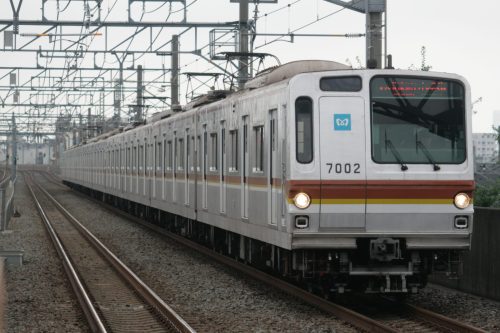
東京メトロ7000系の魅力
今年2014(平成26)年、東京メトロ7000系がデビュー40周年を迎えた。新造から40年を経た今なお、有楽町線・副都心線で現役を続けている。特に10両編成の7001・7002・7004・7005・7010・7018の各編成は40年前の有楽町線池袋~銀座一丁目間開業時から走り続けており、まさに有楽町線の「生き字引」とも言える存在である。そんな東京メトロ7000系の魅力について語りたい。In 2014, Tokyo Metro 7000 Series marked its 40th anniversary since its debut, which still have been running on Yurakucho and Fukutoshin Lines. Especially 10-carriage sets, 7001F, 7002F, 7004F, 7005F, 7010F, and 7018F sets, includes carriages since its debuted, they can be called "the walking dictionary on Yurakucho Line". This time I would like to write the attraction of 7000 Series. 東京メトロ7000系は1974(昭和49)年に有楽町線用の車両として登場した。1968(昭和43)年に登場した千代田線用の6000系を基本にした設計で、車体は前面非常貫通扉上部の種別表示準備窓と車両番号の位置の違いを除いてほぼ同一。制御方式も6000系同様の自動可変界磁(AVF)サイリスタチョッパ制御を採用した。当初は5両編成で、ラインは黄色一色(2枚目の写真を参照)、側窓は上段下降下段上昇式のいわゆる「田」の字型のものでデビューした。以降、路線の延伸や増発に合わせて増備され、1989(平成元)年までに10両編成34本が製造された。1993(平成5)年より、新造から20年が経過した7001F~7020Fを対象に、側窓の1段下降化・車椅子スペースの設置などの内装のリニューアルと一部編成のVVVF制御化改造、また全編成に行き先表示のLED化改造が実施された。そんな7000系に大きな転機が訪れたのが、2008(平成20)年6月14日の副都心線開業である。これに伴い7000系は2度目のリニューアルが実施された。副都心線対応となる全編成に、外観では帯色のこげ茶色・白・ゴールドの3色への変更、行き先表示LEDの更新、内装ではドア上LED案内表示機の2段表示式への新設・交換、ドアチャイムの変更などが実施された。また副都心線でのワンマン運転に対応したATOとドア開閉スイッチ、ホーム監視モニター画面も設置され、併せて東急東横線・横浜高速鉄道みなとみらい線に乗り入れるため、運転台がT字型ワンハンドルマスコンに改造された。この時一部編成が副都心線各停列車用の8両編成に短縮され、これまで1両の廃車も出さなかった7000系に初めて廃車が発生した。10両編成の一部は副都心線開業後しばらくは黄色帯のままで残り、有楽町線専用編成となっていたが、2010(平成22)年までにリニューアルの施行、または廃車となり、姿を消した。2014(平成26)年現在は、10両編成6本と8両編成15本が在籍している。7000 Series debuted in 1974, at the same time as Yurakucho Line's open (between Ikebukuro and Ginza-itchome), and based on antecedent 6000 Series for Chiyoda Line manufactured since 1968. It had almost the same body except the small window above the emergency exit and the place of the carriage number on the front and the same automatic valuable field (AVF) chopper control system. At first the sets were consisted of five carriages and yellow line (see also second photograph). It also used to have side windows whose upper half went down and lower half went up looking like a kanji "田". As the line extended and the timetable rearranged, 340 carriages,thirtyfour 10-carriage sets, had been manufactured until 1989.First refurbishment of the early twenty sets had started in 1993. Their windows, seating colour, and control equipments were changed and the LED displays above the doors and the space for wheelchair were newly put. Moreover, the destination indicators of all sets had changed to the LED ones.The open of Fukutoshin Line in 2008 had given 7000 Series a major turning point, which had given 7000 Series the second refurbishment; the line colour (brown, white, and gold one), outside LED, inside LED above the doors which indicating two rows, and the tone informing doors opening and closing had been newly installed or replaced from the old ones. In addition, automatic train operation (ATO) device, and door controller and platform monitor had newly put for the conductorless operation and, for the service on Tokyu Toyoko Line and Yokohama Minatomirai Railway Line, the driver's cab changed to T-shaped one which accelerating and braking are integrated. Some sets had been shortened to 8-carriage and some carriages had scrapped first time. Though some 10-carriage sets had remained the unrefurbished ones only for Yurakucho Line, they had also been scrapped or refurbished by 2010. In 2014 six 10-carriage sets and fifteen 8-carriage sets are existing.東京メトロ7000系の魅力の1つは、6000系の思想を引き継いだ40年以上の使用を想定した設計であろう。普通鋼製車体の車両では20~30年程度だった寿命が、アルミ合金製車体としたことで40年以上の使用にも耐えうるものとした結果、昭和40年代生まれでありながらも、2度のリニューアルを受けながら今日まで現役であり続け、かつ古臭さを感じさせないのであろう。そしてその結果、2008(平成20)年の副都心線延伸開業に合わせて一部編成の組み替えが実施されるまでの34年間、1両の廃車も発生しなかったのであろう。この廃車は副都心線開業に伴う車両整理・短編成化が理由であり、7000系そのものの老朽化を理由とするものではない。そして8両編成はデビュー当時から連結されていた7600形と7700形が編成から外されて廃車となってしまったものの、10両編成6本はデビュー当時からの車両が5両とも現役であるという点が特筆される。40年が経ってもなお、老朽化を理由とする本格的な廃車が始まっていないという点も魅力の一つとして挙げられるだろう。長寿命の設計を大いに活用して、時代の変化に合わせて進化を遂げてきたところが7000系の大いなる魅力と言えるのではないだろうか。当初の計画どおり、新造から40年が経ってもなお活躍を続ける東京メトロ7000系を、今後も見守っていきたい。From my point of view, one of the attractive point of 7000 Series is the long-life design, which is looked ahead to the use for over 40 years later. The body made from aluminum alloy makes it available to keep running over 40 years, which is about 10 - 20 years longer than carbon steel ones, and the refurbishments creates the nonstale interiror though it debuted 40 years ago. As a result, the scrap of 7000 Series hadn't happened for 34 years and the replacement due to the deterioration doesn't come. Why some carriages were scrapped before Fukutoshin Line's open was the arrangement carriages on Yurakucho and Fukutoshin Lines, not getting old. In addition, 10-carriage ones still couples the five since their debut. It is also an attraction and notable point.In conclusion, 7000 Series has been running for 40 years through changing its interior and equipments as time goes, which is the most attractive point. I still would like to see 7000 Series, which keeps good condition and running according to the first plan.
Dec 14, 2014
コメント(0)
-
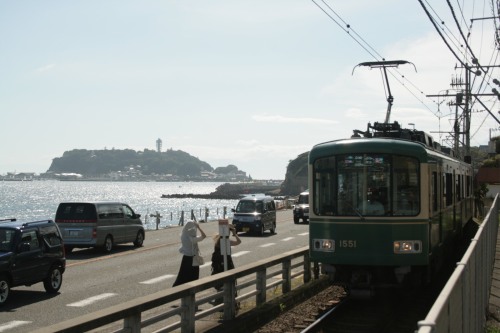
江ノ電は「ロケーションツーリズム」に救われた鉄道の元祖!?
近年、特に2007(平成19)年以降、アニメや映画作品に登場した景色を観光の目玉にする「ロケーションツーリズム」という動きが各地で見られる。特にアニメ作品においては、近年風景の描写が実在の街をモデルに、かなり精密に描かれた作品が多く見られる。そのリアルに描かれた風景を見たファンが実際の街を訪れて、作品の世界観に浸り、記念撮影をし、その写真をブログやmixi、FacebookといったSNSに公開して、それを見た別のファンがそこを訪れるという現象が起きている。埼玉県久喜市の鷲宮地区や同秩父市、広島県竹原市、石川県金沢市の湯涌温泉の取り組みなどが、アニメ作品を通じたロケーションツーリズムの好例としてよく紹介される。リアルに描かれる対象物は鉄道車両や駅舎も該当し、アニメ作品の中で車両や駅が描かれたのと鉄道、長良川鉄道、千葉都市モノレールなどの鉄道事業者もこの流れに乗り、登場する作品とタイアップした記念きっぷの販売やラッピング車両の運行などを実施している。実際、のと鉄道では、NT200形車両や西岸駅が登場するアニメ「花咲くいろは」のグッズ販売を開始したところ、2012(平成24)年3月期の売上が前年比12.9%増の1億9300万円を記録した。このように、アニメの作中に描かれたことを売りに、作品とのタイアップ効果による新たな旅客獲得によるファン作りに熱心な鉄道に関心が高まる一方で、ロケーションツーリズムが持て囃されるずっと昔に、今日のロケーションツーリズムに通ずるものに救われた鉄道があるということをご存じだろうか。実はそれが、江ノ島電鉄(江ノ電)である。江ノ電は、今でこそ湘南の海の目の前を走る路線として人気の高い観光路線の一つであり、かつ湘南・鎌倉の象徴と言える存在と捉えられ、「SLAM DUNK」「TARI TARI」「ハナヤマタ」など数多くの作品に登場しているが、40~50年前は状況が違っていた。1960年代、モータリゼーションの進展が日本各地に及び、中小私鉄の廃線・解散が相次いだ。江ノ電も例外ではなく、廃線が検討されたほどだった。ところが、1976(昭和51)年から翌77(昭和52)年に放送された、鎌倉を舞台とするテレビドラマ「俺たちの朝」に江ノ電が登場し、鎌倉の魅力が当時の若者を中心に知れ渡り、この時廃線寸前に追い込まれていた江ノ電の乗客数が回復したことで、廃線を免れた。また、作品にちなんだ記念きっぷも発売されたという。その後の湘南・鎌倉ブームにも支えられて観光客が増え、人気の観光鉄道に成長した。1990(平成2)年には、1975(昭和50)年以来抱えていた累積赤字を完済した。旅客数の減少により苦しい経営を迫られているところが多い中小私鉄において、江ノ電は黒字路線の一つである。江ノ電が今日も走り続けているのには、1本のテレビドラマのおかげなのである。このテレビドラマをきっかけとして鉄道の旅客数が増え、鉄道会社が作品にちなんだ記念きっぷを販売するという動きは、今日のアニメ作品に描かれた鉄道の取り組みに、とてもよく似ている。今から38年前の1976(昭和51)年の時点で、今日のロケーションツーリズムを活用した鉄道の旅客数増加に繋がる行動が発生していたというのだから、やはり江ノ電には学ぶべき点の1つと言えるかもしれない。In these days, especially since 2007, several cities in Japan try to attract more tourists by scenery pictured in film or anime works, so-called "film tourism".Especially, the anime works portraying real, existing scenes with detail, painstaking touch would be seen. As the anime fans watch it, they really visit there to watch the real ones and to feel the world of the work, shoot photographs, and upload the pictures to their blog or social network sites, such as mixi or Facebook. Then the other fans attracted by them visit, too. The efforts of Washinomiya area in Kuki City, Saitama, Chichibu City, Saitama, Takehara City, Hiroshima, and Yuwaku Hot Spring area in Kanazawa City, Ishikawa, are often introduced as the good example of film tourism through the anime works.The delineation of the railway rolling stocks and station buildings are also, which leads to form the business tie-up with the publisher of works like the sale of special tickets and operation of decorative train of the some railway companies whose carriages and stations are pictured, such as Noto Railway, Nagaragawa Railway, and Chiba Urban Monorail. Actually, the total sales for the year of Noto Railway in the full-year fiscal period ended March 31, 2012, was up 12.9 percent over the previous year, to 139 million yen, through the sales of goods using the illustration of "Hanasaku Iroha" on which NT200 Series and Nishigishi Station were appeared.Paying attention to the such challenges to draw new passengers, on the other hand, there was a railway helped by film tourism about 40 years ago. It was Enoshima Electric Railway (Enoden) .In these days, regarded as the symbol of Kamakura and Shonan Bayside Area in Kanagawa Prefecture, Enoden sometimes appears on anime works set in that place, such as "SLAM DUNK", "TARI TARI" and "Hanayamata". However, in 1960s and 1970s were under the different situation.On that time the mortorization lead to many railways in rural area close. Enoden was no exception, the abolition of the railway discussed.However, in 1976, the broadcast of a TV drama set in Kamakura "Oretachi no Asa ~Our Morning~" turned the bad situation of Enoden into the good one; through the drama the attraction of Kamakura Area became known among youngsters and they travelled there by Enoden, which recovered the number of Enoden passengers and succeeded to avoid the worst situation. In addition, the special ticket associated with the drama was sold.The passengers of Enoden gradually increased pushed by the boom popularity of the bayside area. In 1990 the deficits of Enoden was completely paid off. Among the rural area railways most of which face unfavorable business conditions, Enoden is the one of profit-making companies including depreciation.In conclusion, this passengers' action and Enoden's effort can extremely resemble the location tourism these days, which happened from years ago. It can be one of what the other railway companies in rural area should study.
Aug 24, 2014
コメント(0)
-
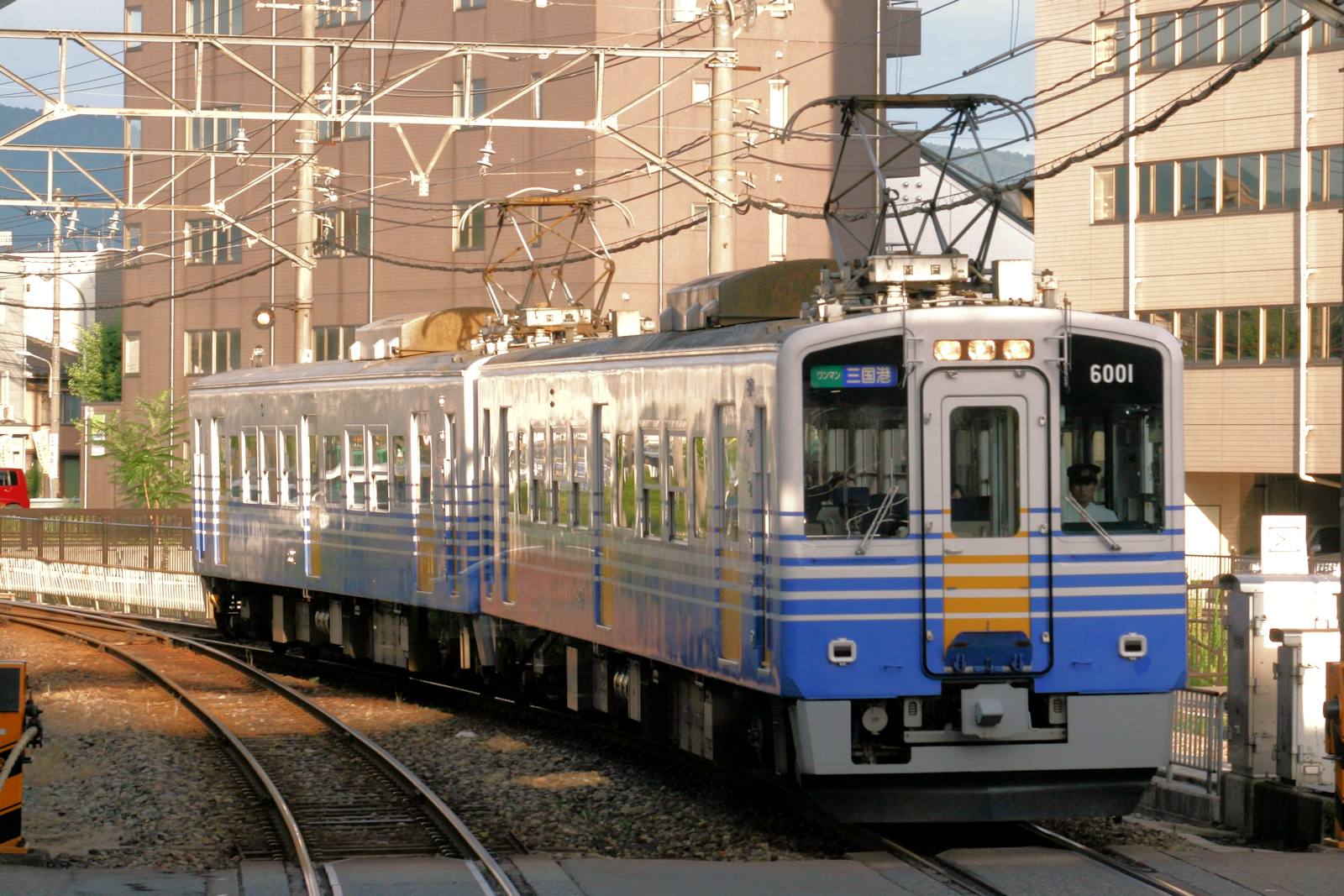
えちぜん鉄道に込められた福井県民の「鉄道愛」
えちぜん鉄道は、福井~勝山間の勝山永平寺線と、福井~三国港間の三国芦原線の2路線からなる。特筆すべき点は、えちぜん鉄道が、現在も多くの地域で問題になっている地方鉄道の存廃に関して、鉄道再生の道を選んだ先駆けであるということだ。えちぜん鉄道はもともと、京都の嵐電で知られる京福電気鉄道の「福井鉄道部」が経営する路線だった。存廃問題が浮き彫りになったのは、1992(平成4)年のこと。利用客の減少と採算悪化を理由に勝山永平寺線勝山~永平寺口間と永平寺線永平寺~永平寺口間の廃線を申し入れたことから始まった。沿線自治体による赤字補填や乗客への回数券購入補助金などで路線を存続させることができたが、抜本的な解決策とはなり得なかった。しかしその矢先の2000(平成12)年に勝山永平寺線永平寺口駅構内で、翌2001(平成13)年には同じく勝山永平寺線の保田~発坂間で列車の正面衝突事故が発生した。事態を重く見た国土交通省は京福電気鉄道に、福井鉄道部が受け持つ全線での列車の無期限全面運休を命じ、ATSの設置などの業務改善命令を出した。この「廃線」とも言える運休となった期間、代行バスが運行されたものの、バスが渋滞に阻まれて時刻通りに運行できない事態に陥ることが常態化した。福井県は一人あたりの自動車所有率が日本一高い県であり、かねてから鉄道からマイカーへの客の流動や激しい渋滞が社会問題となっていたという背景を考慮したとしても、深刻な事態となった。京福電気鉄道単体では事業が困難だったため福井鉄道部全線の廃線を届け出た。一方で、運休直後から鉄道の必要性を訴える地元住民の声に応えて、福井県と沿線市町村は、京福電気鉄道福井鉄道部の路線のうち、勝山永平寺線と三国芦原線を「えちぜん鉄道」として復活させることを、2002(平成14)年に決定した。運行再開に向けて、福井県が、京福電気鉄道が所有していた土地・線路・駅・変電所・車両などの買取・整備費用を負担し、開業後10年間の安全設備投資も担うこととなった。地元行政(福井市・坂井市・あわら市・永平寺町・勝山市)はえちぜん鉄道への出資と開業後10年間の赤字補填を行い、また沿線住民で組織されたNPO法人(サポート団体)もえちぜん鉄道への出資や運賃が割引になるサポーターズクラブ会員の募集などを担っている。2003(平成15)年に7月に一部区間での運転を再開し、同年10月までに全線での運転再開が実現した。結果的に、鉄道を廃線にしてバスに置き換えるという方法が失敗に終わるということを、全国に教え伝えることとなり、地元行政や沿線住民の協力を得られたことで、えちぜん鉄道は再生を果たしたのである。2003(平成15)年の復活以来、えちぜん鉄道は乗客数を順調に増やし、サポーターズクラブ会員数も4000人に迫ろうとしている。2012(平成24)年4月、赤字補填の期限を迎え、沿線各自治体は新たなサポート体制として、線路および架線などの電気系統の維持管理費用の公費負担とこれらにかかる固定資産税額の支援へと移行した。いわゆる一種の「みなし上下分離」である。福井県は引き続き緊急性の高い安全設備への投資に対する支援を行う。えちぜん鉄道の2012(平成24)年策定の10年計画における「今後の課題」として、観光利用など「非日常利用」の乗客を増やすことが挙げられた。その一環として、三国港駅を観光の拠点施設と位置づけ、坂井市の支援の下、駅舎を大正ロマン風に改修し、駅舎の隣に観光情報発信施設を開設した。そんな中、2014(平成26)年7月、坂井市を舞台とするアニメ「グラスリップ」に三国港駅とMC6000形車両が登場した。「グラスリップ」需要がえちぜん鉄道にどれほどの利用客増加をもたらすのか、今後を見守っていきたい。それと共に、「グラスリップ」をきっかけとしてえちぜん鉄道を知り、えちぜん鉄道の存在意義や多くの支援が必要なことをぜひとも学習してくれる人が増えてほしいものである。Echizen Railway operates Katsuyama-eiheiji Line between Fukui and Katsuyama and Mikuni-awara Line between Fukui and Mikuni-minato in Fukui Prefecture.The notable point of the railway is the pioneer to solve the problem of how to maintain the railways in the middle-sized cities and the rural areas in Japan.Those two lines used to be operated by Fukui Railway department of Keifuku Electric Railway, which is famous for Randen in Kyoto.In 1992 Keifuku offered the discontinue of some parts of its lines, between Katsuyama and Eiheiji-guchi on Katsuyama-eiheiji Line and Eiheiji and Eiheiji-guchi on Eiheiji Line, because of a decrease of passengers and a decline in profit. Providing financial aid for the company and the passengers when those buy commutation tickets, the cities along the lines tried to keep the railway, which couldn't solve the problem radically.However, in 2000 and 2001 the two train crash happened, the former one near Eiheiji-guchi Station and the latter between Hota and Hossaka on Katsuyama-eiheiji Line. The Transportation Ministry order Keifuku to suspend the operation of whole lines Keifuku's Fukui railway department owned and install safeguard facilities such as ATS. While the train suspended its service, the bus along the railway operated. However, the bus almost always delayed due to the traffic jam. Taking account of the highest automobile ownership in Japan, which made traffic jam become the major matter, it was a serious situation.Keifuku decided the abolition of Fukui Railway department because it was difficult to keep doing its business. Then in 2002, Fukui Prefectural Office and the cities agreed to the revival of Katsuyama-eiheiji Line and Mikuni-awara Line as the newly-established "Echizen Railway".For the restart of the railway the Prefectural Office paid the cost for the infrastructures, such as land, railway, stations, electric lines, substations, and rolling stocks, etc, and safety equipment investments for 10 years. In addition, the cities (Fukui, Sakai, Awara, Katsuyama, and Eiheiji Town) took a stake in the new company and provides subsidies to cover the deficit for the decades. The NPOs organized by the persons living along the railway invested in the company and support to gather the members with membership discount of the train fare.The train operation partly restarted in July 2003 and completely by October of that year.As a result, this experience told replacing the railway by bus could be a bad way all over Japan, and Echizen Railway succeeded by the strong support by prefectural and cities' government and local persons. Since the restart in 2003, the number of passengers has gradually increased and the membership of supporters becomes almost 4000.In 2012, the limit of subsidies to cover the deficit came and the cities started to pay the costs for maintaining the infrastructures and fixed property tax as the new support system. In addition, Fukui Prefecture continues to financial support for the safety equipment. The railway company has the assignment to increase non-regular users such as tourists in the new aim in 2012. As one of the project Mikuni-minato Station was refurbished and the newly-built tourist information centre opened. As the project goes well, MC6000 Series and Mikuni-minato Station appeared in "Glass Lip" anime.I carefully would like to observe how many tourists the new demand growth arising from the anime makes and wish many tourists who first know the railway through the anime to study the railway's needs and support.参考文献 Reference (All Japanese)「鉄道の運行休止・再開による沿線住民の交通行動および意識の変化に関する研究 -福井地域における地方鉄道を対象として-」 堀井茂毅 川口充康 川本義海 川上洋司「地方鉄道の維持と再生に向けた取り組み」 岸谷克己「えちぜん鉄道に対する沿線自治体の支援」 小谷田文彦 恩田睦 ビクター・カーペンター「えちぜん鉄道にみる地方鉄道再生の条件」 北崎浩嗣「沿線住民の認識を通した地方鉄道の価値に関する研究 - えちぜん鉄道を事例として -」 大山英朗 三寺潤 川上洋司「地方公共交通の再生 : 地域鉄道再生の潮流」 清水省吾「えちぜん鉄道に対する沿線自治体、住民の支援について」 小谷田文彦 恩田睦 ビクター・カーペンター「えちぜん鉄道の経営と地域社会」 恩田睦「地方鉄道運行再開による沿線住民の交通行動及び意識に関する調査・分析 -福井地域における地方鉄道を対象として-」 堀井茂毅 川口充康 川本義海 川上洋司「不採算公共交通政策の経緯と課題」 斎藤峻彦「「地域公共交通の活性化及び再生に関する法律」の評価と課題 ―この法律をステップにして交通基本法制定へ大きく踏み出そう―」 土居靖範えちぜん鉄道「平成23年度 安全報告書」「えちぜん鉄道公共交通活性化総合連携計画」 福井市・勝山市・あわら市・坂井市・永平寺町「えちぜん鉄道公共交通活性化総合連携計画」(概要版) 福井市・勝山市・あわら市・坂井市・永平寺町
Jul 6, 2014
コメント(0)
-
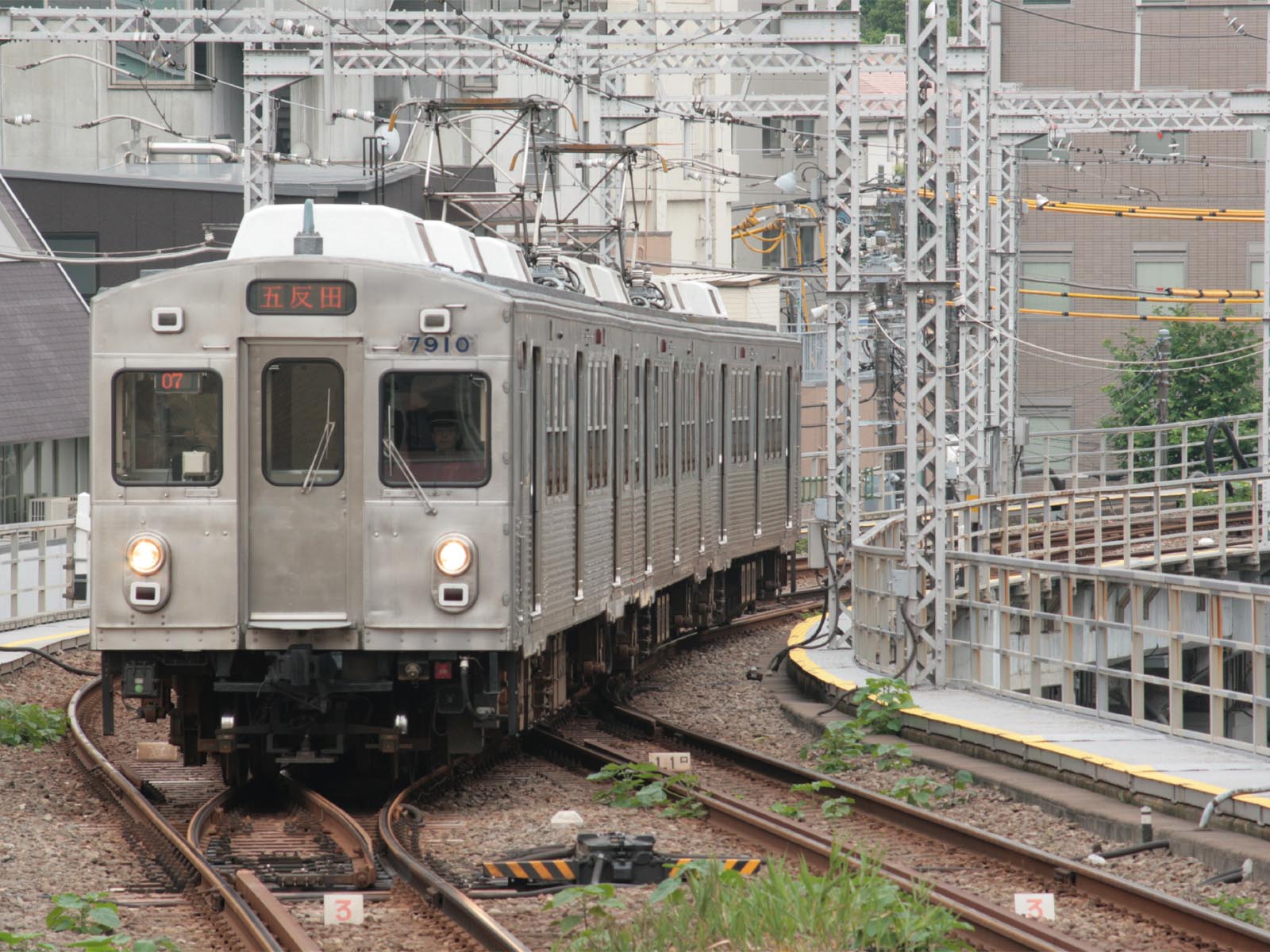
本当に!? 東急7910Fが引退か!?
前回、東急7700系7910Fを動態保存できないかどうかという記事を執筆したが、まさかその直後に悲報が届いた。「7710Fが長津田工場へ回送」(「鉄道ファン」鉄道ニュース 2014年5月13日)僕がブログを執筆した5月11日からわずか2日後の引退報道だった。東急池上線・多摩川線には、10日、かねてから鉄道ファンの間で大きな話題になっていた、元東横線~東京メトロ日比谷線直通用だった1000系電車リニューアル車の1503Fがデビューし、華々しい空気に包まれていた。しかしそれから一転、「東急の誇り」とも言うべきだった「日本初のオールステンレス電車」7700系7710Fが長津田工場へ回送され、それと入れ替わりの引退というニュースが入った。営業運転最終日の12日は朝まで営業運転に就き、雪が谷検車区に入庫。そこで、2012(平成24)年10月6日の池上線開業90周年記念イベントの時と同様の、「回送」表示の幕が取り付けられ、幕式の運行番号表示器も再現されたとのこと。2代目7000系電車や1000系リニューアル車が登場すればいずれ引退すると思っていたが、まさかこんなに早く7710Fとの別れの時が来てしまうとは思ってもいなかった。僕ももう一度7910Fに乗りたいと思っていただけに、再び乗ることが叶わぬ夢となってしまい、残念でならない。ここで天寿を全うせずに、先日僕がブログで書き著した通りに、動態保存されることを願う。Last time I featured the preservation in good condition of Tokyu 7700 Series set 7910F set, which is the first carriage made from stainless steel from the skin to the framework in Japan. However, a sad was suddenly came on 13th."7710F went to Nagatsuta Factory maybe because of its retirement" on the website of Japan Railfan Magazine.It has passed only two days since the latest update of my blog.On 10th, refurbished Tokyu 1000 Series 1503F set coming from Toyoko Line, which moved from the going-through service to Tokyo Metro Hibiya Line in 2013, brilliantly debuted. However, 7910F set would retire as if it would be replaced by 1503F.The news said that it had been in service only on the morning of 12th, the last day. At the Yukigaya railyard, an old-looking "not in service" indication and an operation number indicator showed like the special train for 90th anniversary of Ikegami Line in 2012.As the more 7000 Series manufactured or 1000 Series refurbished, the less 7700 Series exists. I am disappointed with its retirement because I really would love to ride on it again. I wish it will move to another railway and keep good condition as I wrote last time.
May 13, 2014
コメント(0)
-
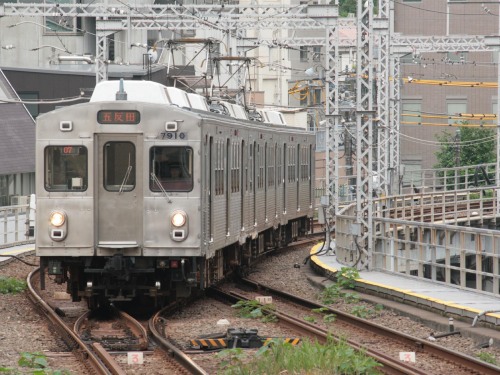
東急7001・7002号車復元・動態保存は実現するか?
2014(平成26)年より、東横線~東京メトロ日比谷線直通用だった1000系電車の池上線・多摩川線への転用が始まり、同線の7700系・7600系の引退が再び現実味を帯びてきた。そこで気になることが、「日本初のオールステンレス電車」として50年以上現役を貫いてきた元初代7000系電車7001Fの7700系電車7910Fの動向だ。7910Fは1961(昭和36)年に、東急車輛製造(現在の総合車両製作所)がアメリカの鉄道車両メーカー・バッド(現在はボンバルディアに買収されている)の技術を採り入れて製造した「日本初のオールステンレス電車」、初代7000系の第1編成、7001Fとして誕生した。翌1962(昭和37)年、東横線にデビューし、東横線と営団地下鉄(現在の東京メトロ)日比谷線の直通運用に就いた。1988(昭和63)年、VVVF制御の7700系に改造され、その7710Fとなった。2012(平成24)年に池上線開業90周年を記念して、前面の赤帯を剥がして初代7000系時代の姿に近づけ、同年10月6日の記念特別運転では、7910号車に「7001」、7710号車に「7002」の番号が復活した。そんな歴史的価値の高い7910Fを、どうにかして動態保存できないか。僕に限らず、多くの鉄道ファンが望んでいることだろう。動態保存される際には、初代7000系デビュー当初の、車輪手前のブレーキディスクが特徴のパイオニアPIII台車に履き替え、限りなく外観を初代7000系時代の姿に近づけた上で保存することを理想とする。内装・運転台・制御機器は7700系に改造後のままとする。保存譲渡先は、同じ東急グループの上田電鉄を想定している。初代7000系が履いていたPIII台車だが、7700系への改造時に別の台車に履き替えてしまったため、東急電鉄には残っていない。そのため地方鉄道へ譲渡された7000系より調達する方法しかない。譲渡された7000系の中で現存するものは、54両(弘南鉄道20両、福島交通14両、北陸鉄道10両、水間鉄道10両)だが、このうち北陸鉄道のものは台車が違うものに交換されてしまったため対象から外す。北陸鉄道以外の44両のうち、水間鉄道では2両が休車となっている。この水間鉄道で休車となっている7000系2両よりPIII台車を捻出し、行き先表示をLED式から幕式に交換するなど、2012(平成24)年の特別運転時を参考に7001F時代の姿に復元する。上田電鉄別所線のホームの長さの関係から、7710号車と7910号車の2両編成に短縮したうえで、イベント列車用の動態保存車として譲渡する。上田電鉄も2008(平成20)年に東急池上線で走っていた1000系が譲渡され、今年2014年(平成26)にも4両の新型車両の導入が予定されており、すべての車両がVVVF化されるものと見られる。このため、古い抵抗制御の車両を復元してまで受け入れることに抵抗感があることを想定し、VVVF制御に改造後の姿を一部残しながら、復元できる箇所は復元し、制御機器・冷房などの近代化された箇所は残しておくという方法を採りながら、長期に渡って保存されることを願う。The refurbishment and diversion of Tokyu 1000 Series started, which realises the retirement of Tokyu 7700 Series and 7600 Series.Then, I am worried about 7700 Series 7910F set, known as the first carriages with full stainless steel body in Japan which was first numbered as 7001F set.7001F set has been in service on Toyoko Line, also sometimes went through to Tokyo Metro Hibiya Line, since 1962. In 1988, the set was renumbered to 7910F and the bogies, machinery, and interior of the carriages were modernised. In 2012, its exterior was restored to the original design for the 90th anniversary of Ikegami Line. The original number on its front also showed again in the special service.Many railfans may wish 7910F preserved in good condition.In my opinion, it would be better to be restored to the original design for preservation. However, the interior and electric equipment kept after the refurbishment.There is the only way to reequip the old bogies from the other lines on which 7000 Series is or used to be in service because Tokyu doesn't stock the bogies.Among the fifty-four carriages on the other lines, the two suspended ones on Mizuma Railway Mizuma Line in Osaka keeps the bogies. Together with the destination indicator and the number plate used on the event in 2012, the set would be nearly restored to the original design.Also, I wish the set moved to Ueda Electric Railway Bessho Line for the event train. Because of the length of the platforms on Bessho Line, the set shortened to 2-carriage set.However, Ueda Electric Railway plans to introduce four more variable frequency drive carriages from Tokyu for the modernization. Because of this, the company may have feelings of resistance toward the preservation of the old-fashion carriages. I wish the first stainless steel carriage keep running.
May 11, 2014
コメント(0)
-
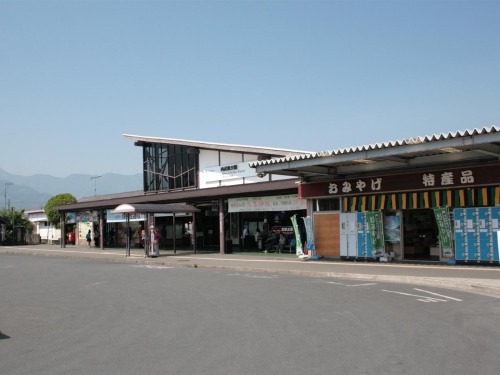
西武秩父駅のアナウンスをぜひとも”塔子さん”に!!
鉄道ファンの間で、「私鉄アナウンスの女王」と呼ばれる声優といえば、大原さやかさんである。2002(平成14)年頃より京王電鉄、京浜急行電鉄などの路線の駅で大原さんの声のアナウンスが導入されてきている。西武鉄道でも、山口線遊園地西駅で大原さんの接近アナウンスを使用したり、接近放送は旧アナウンスのまま残る池袋線・西武秩父線吾野駅では、列車到着後に大原さんの「電車から離れてお歩きください」というアナウンスが聞けたりする。そこで1つ提案したいことがある。西武秩父線の終点、西武秩父駅のアナウンスも大原さんの声に変えてみてはいかがだろうか?秩父市を舞台とするアニメ「あの花」の登場人物、宿海塔子さん(主人公・宿海仁太君の母親)の声を大原さんが担当しており、「あの花」ファンの秩父での楽しみを増やす目的でもある。ご存知の方も多いと思われるが、西武鉄道は4000系4005Fをを「あの花」のラッピング車両として走らせるなど、タイアップに積極的である。それを見た僕は、ラッピング車両以外にも新しい楽しみを増やすことができないかと考え、西武鉄道が大原さんのアナウンスを、京王や京浜急行よりは少ないながらも導入していることに目を向けた。大原さんが声を担当したアニメのゆかりの地にある駅で大原さんのアナウンスが聴ける駅がある例がいくつかあり、京浜急行の汐入駅、京王動物園線の多摩動物公園駅、都電荒川線の都電雑司ヶ谷電停が該当する。Sayaka Ohara is called "Queen of the station announcement on the private railways" among the railfans because her voice is used on many stations on the private railway lines such as Keio Corporation and Keikyu since 2002.On Seibu Railway the announcement is introduced at Yuenchi-nishi Station on Yamaguchi Line, and Agano Station on Ikebukuro Line and Seibu-chichibu Line.Then I have an opinion about the announcement on Seibu Railway, the old one at the terminal of Seibu-chichibu Line Seibu-chichibu Station changes to it.Ohara also voiced a character appearing on "Anohana ~the flower we saw that day~", which is set in Chichibu City, Toko Yadomi, mother of its hero Jinta Yadomi's, which aims to make a new attraction in Chichibu for the anime fans. As many railfans probably know, Seibu Railway positively ties up with the work to draw the tourists for Chichibu, which makes 4005F set of 4000 Series become a decorative train.There several examples that a railway station introducing her announcement stands where an anime work she is cast is set, Shioiri on Keikyu Line, Tama-dobutsu-koen on Keio Tama Zoo Line, and Toden-zoshigaya stop on Toden Arakawa Line.
May 10, 2014
コメント(0)
-
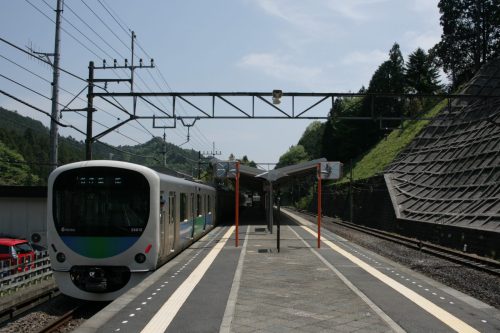
元町・中華街~西武秩父の臨時列車は実現するか?
この大型連休中は4000系だけでは池袋線・西武秩父線の飯能~西武秩父間各停列車をまかなうことができず、30000系が同列車の一部に投入されるなど、賑わいを見せた。2007(平成19)年より、西武秩父線の変電所の改良により、30000系などの回生ブレーキ搭載車両が回生失効することがなくなったため、多客期に運用されるようになった。そのため東急5050系も物理的に飯能~西武秩父間への乗り入れが不可能ではなくなった。実際に、昨年2013(平成25)年、東急電鉄の車両として初めて4000系が西武秩父駅まで試運転を実施している。しかしながら、飯能~西武秩父の各駅10両編成に対応しているのは東飯能駅と西武秩父駅のみであり、それ以外は8両編成分の長さしかホームがないため、東急4000系は同区間ではこれら2駅にしか停車することができない。東急5050系ならば8両編成のため同区間もすべての駅に停車させることができる。このことから、東急5050系による元町・中華街~西武秩父の臨時列車を走らせることも、実現可能であると言える。せっかく東急東横線と直通するようになり、「東急西武線まるごときっぷ」が西武鉄道全線で乗降可能であることを有効活用するためにも、この臨時列車は有意義なのではないだろうか。横浜高速鉄道みなとみらい線・東急東横線内は東横特急、東京メトロ副都心線内は土休急行、西武池袋線・西武秩父線内は快速急行(小竹向原~飯能間は直通快急、飯能~西武秩父間は各停)で運転。今回の西武4000系の西武新宿行き列車と同様に、定期運行の飯能行き東横特急の延長運転扱いとする。考えうるものとしては、7:49元町・中華街駅発の052072列車、特急飯能行き。9:26に飯能駅に到着し、通常は9:28飯能駅発の各停西武秩父行きに接続しているが、同列車の後を追う形で西武秩父駅まで直通運転を実施する。多客期にはこの時間に臨時の特急レッドアローが運行される場合があるが、この列車を運行する日には、臨時特急は運休とする措置を採ると、不可能ではない。In these holidays in May, 2014, some sets of Seibu 30000 Series had operated as local trains between Hanno and Seibu-chichibu to fill the lack of regular operation by Seibu 4000 Series due to more passengers.Since the improvement of electrical substations along Seibu Seibu-chichibu Line in 2007, the carriages installing generating brake can operate in this section in the high season because these rolling stocks don't happen the loss of the braking function, which lets Tokyu 5050 Series go through Seibu-chichibu. Actually, a set of Tokyu 5050-4000 Series did a trial run to Seibu-chichibu Station in 2013.However, all of 5050-4000 Series sets are 10-carriage and can stop at Higashi-hanno and Seibu-chichibu only because of the length of the platform. On the other hand, 5050 Series can do due to 8-carriage.I would like to say it means the special train from Motomachi-chukagai to Seibu-chichibu by 5050 Series can be realized and may be fruitful to make an effective use of the connection between Seibu Ikebukuro Line and Tokyu Toyoko Line via Tokyo Metro Fukutoshin Line and the ticket allowing the one-day unlimited travel all over Seibu Railway.The special train will operate as a limited express on Yokohama Minatomirai Railway Line and Tokyu Toyoko Line, a holiday express on Fukutoshin Line, and a rapid express on Seibu Ikebukuro Line and Seibu-Chichibu Line as the extension of a regular operation to Hanno.As one of my opinion, 052072 operation departing from Motomachi-chukagai at 7:49 and approaching Hanno terminal at 9:26, where it makes a connection to a local train for Seibu-chichibu at 9:28, will be extended, following the local train. Though a limited express "Red Arrow" occasionally operates on that time, the limited express operation suspends when the special train from Motomachi-chukagai runs.
May 5, 2014
コメント(0)
-

練馬区新区長は大江戸線延伸推進派!!
2月の志村豊志郎前区長の死去に伴う東京・練馬区の区長選挙が4月20日行われ、都営地下鉄大江戸線延伸推進派の前川燿男(まえかわ・あきお)さんが当選した。前川さんは、志村区政を引き継ぎ、都営地下鉄大江戸線の光が丘~大泉学園町間の延伸や西武池袋線石神井公園~大泉学園間、及び西武新宿線上井草~武蔵関間の高架化の推進、および練馬区に集中的に立地するアニメ製作産業を活用した街づくりを訴えた。大泉学園町駅までの延伸が計画されている都営地下鉄大江戸線 Toei Oedo Line planning to extend to Oizumi-gakuenchoつい最近まで、地方政治において、交通は疎かになりがちと見られてきた。しかし2007(平成19)年に地域公共交通活性化・再生法が施行されてより手厚い支援を自治体ができるようになったり、2011(平成23)年に橋下徹大阪市長が就任後の演説で、まずは大阪市地下鉄の運賃値下げを実現させると公言したりするなど、公共交通と地方政治の関係に変化が見られるようになった。前川区長も都営大江戸線延伸と西武新宿線高架化を選挙公約として選挙に挑んだため、交通政策を公約に盛り込んだ政治家として評価したい。高架化が予定されている上井草~上石神井間を走る西武新宿線 Seibu Shinjuku Line train running between Kami-igusa and Kami-shakujii planning elevation前川区長は2018(平成30)年4月までの任期となる。僕としても、一練馬区民としても、鉄道ファンとしても、大江戸線延伸および西武新宿線高架化推進派の新区長の誕生を喜んでいるとともに、これらの早期実現に期待したい。On 20th a election for new mayor of Nerima-ku, Tokyo because of the death of the previous Toshiro Shimura was held and Akio Maekara, who goes ahead with the extension of Toei Oedo Line to Oizumi-gakuencho, was elected.Mr. Maekawa appealed for the need to follow the late previous mayor's policy, such as not only the subway line's extension, but also the elevation of Seibu Ikebukuro Line between Shakujii-koen and Oizumi-gakuen and Seibu Shinjuku Line between Kami-igusa and Musashi-seki, and the promotion of the city using animation production. Recently, especially since the promotion and reconstruction of regional public transportation law was enforced, the relation between railway and regional politics changes, such as generous support to railways or buses in the city, and the mayor of Osaka City Toru Hahsimoto's manifesto for the reduction in Osaka Municipal Subway's fare. I would like to appreciate him as a politician who has the policy about the transportation.His mayoralty lasts four years.I rejoice at the accession of him and the early realization of the railway projects.前川燿男練馬区長オフィシャルサイト(Japanese)
Apr 23, 2014
コメント(0)
-
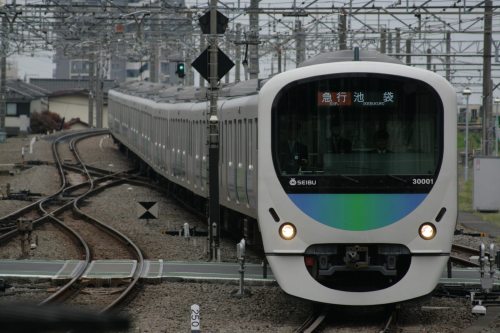
証券虚偽事件から10年 西武鉄道念願の再上場
4月23日、西武鉄道の持ち株会社、西武ホールディングスが東証1部に上場した。2004(平成16)年に堤義明元会長ら旧経営陣による証券虚偽記載事件を受けて上場廃止となってから、約10年ぶりに、東京メトロを除く大手私鉄全社(阪急電鉄・阪神電気鉄道・相模鉄道はそれぞれの持ち株会社)が東証1部に上場したことになる。虚偽記載事件後、西武鉄道はみずほ銀行の管理下に置かれて(西武鉄道の若林久社長はみずほ銀行出身)経営再建に着手し、新たな持ち株会社となる西武ホールディングスを設立し、支援者として西武ホールディングスへの出資に応じたのが、アメリカの投資ファンド、サーベラス・キャピタル・マネジメントだった。サーベラス社は西武ホールディングスの筆頭株主となったものの、あくまでも経営再建の支援を目的とするものであり、当初は経営への影響力が及ばない範囲で出資した。しかし2012(平成24)年より、上場時の株の売り出し価格を巡ってサーベラス社と西武ホールディングスが対立。サーベラスは企業価値を高めるためという口実で、拒否権を発動できるまでの更なる株の買い増しと取締役の送り込み、西武秩父線、山口線などの路線を廃止させ、埼玉西武ライオンズを売却させようと提案しているのではないかと一部メディアに報道され、両経営陣だけでなく、沿線住民や地元自治体、鉄道ファン、プロ野球ファンをも巻き込み、混乱を極めた。結果として、廃線や球団売却の含みを持たせた株の買い増しは失敗に終わり、取締役会でもサーベラス社からの取締役送り込みは否決された。その後も上場に向けての積極的な話し合いが進められた後、サーベラス側が譲歩し、西武ホールディングスの上場後に日本企業の出資からの全面撤退を2014(平成26)年3月に表明した。この対立は、投資ファンドとして10%近い、高いリターン(配当)を求めていたサーベラス社と、株価は市場が決めるものという考えを持っていた西武ホールディングス、言い換えればアメリカと日本の投資に対する考え方の違いが、混乱を極めた原因だったようだ。当日は1,600円の始値を付け、安値1,565円、高値・終値は1,770円となった。何はともあれ、粉飾決算やサーベラス社との対立を乗り越えての再上場である。鉄道ファンとして、西武鉄道の利用者として、非常に喜ばしいことである。On April 23rd, Seibu Holdings, the holding company of Seibu Railway, relisted on Tokyo Market. 10 years has passed since the delisting of Seibu Railway due to the portfolio misstatement by a former chairman Yoshiaki Tsutsumi and management team on that time. As the result of the relisting, all of the biggest private railway companies except Tokyo Metro (including the holding company of Hankyu Corporation, Hanshin Electric Railway, and Sagami Railway) lists on the market.After the forgery Seibu Railway was brought under Mizuho Bank's control (the present president of Seibu, Hisashi Wakabayashi, came from the bank) to reconstruct the management. When the holding company established the bank offered Cerberus Capital Management to invest to support the reconstruction not having its influence on the management.However, since 2012, Seibu Holdings and Cerberus had had different opinion about the price of Seibu's stock when relisting. As some TV news reported that Cerberus tried to get more stocks to be able to use veto power and planned to some board members, to close unprofitable railway lines, such as Seibu-chichibu Line and Yamaguchi Line, etc., and to sell Saitama Seibu Lions baseball team on a plea of raising company value, which involved residents and city offices along the railway, railway supporters, and baseball fans. This anarchy made all of Cerberus' plans failure; it couldn't get more stocks as planning and send the members.After that, the discussion continued positively and Cerberus appeased Seibu. Cerberus also announced the withdrawal from the investment to Japanese companies after the gradual sell of Seibu's stock.It is said that the different thought of investment, Cerberus needing return over 10%, Seibu leaving the final decision on its stock price to the market, may trigger the anarchy.On the first day, the stock was sold between 1,565 and 1,770 yen.For me it is a gratifying incident, overcoming the forgery and the opposition with Cerberus.THE PAGE 「西武HDが上場、経緯まとめ」 2014年4月21日(Japanese)
Apr 23, 2014
コメント(0)
-
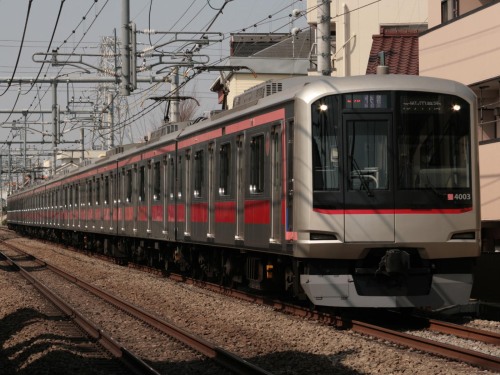
東急4103Fが8両編成に短縮された本当の理由!?
先日、東急4000系の4103Fが8両編成に短縮されたことをお伝えしたが、その理由が5155Fの代用ではない線が出てきた。それは、「5000系の田園都市線への復帰」である。4000系の4600形のうち4601号車から4604号車までの4両は、田園都市線用の5000系の独立M車5900形として新造された車両であり、内装も田園都市線仕様の青色を主体としたものとなっている。そうなると、抜き取られた4603号車は、東横線に在籍する5000系、5118F、5119F、5121F、5122Fのいずれかを田園都市線に復帰させるために抜き取られた可能性もあるということだ。2014(平成26)年度の増備車両についてはまだ公式発表はないものの、東横線の5000系4本は本来田園都市線用に製造された編成であるため、東横線の5050系の投入が今年も続けられれば、5000系の置き換えを目的とするものと見られ、5000系4本の田園都市線へ返却を見込んでいる。昨年2013(平成23)年3月の東横線と東京メトロ副都心線との相互直通運転に向けて、東横線に5050系を増備することが急務となったため、2010(平成22)年以降の新造車両は5050系と4000系が中心となり、5000系の増備は停滞していた。僕は以前の予想で、5050系8両編成3本と5000系独立M車と6ドアT車を新造と書いたが、これを5050系8両編成3本と4000系独立M車4両(2代目4601~4604)、5050系T車4両(2代目5470・5570・5471・5571)を新造、5118F・5119F・5121F・5122Fを暫定的にオール4ドア編成で田園都市線に復帰に予想を変更したい。Several days ago, I wrote about the carriage shortening of 4103F set fo Tokyu 5050-4000 Series. I wrote why 4103F had been shortened was to make up for 8-carriage set damaged in the accident on February. But I found another reason, picking a motored carriage to return a 5000 Series set to Den-en-toshi Line.Four middle motored carriages of 5050-4000 Series, 4601, 4602, 4603, and 4604, were originally manufactured as the one of 5000 Series on Den-en-toshi Line and their interior colour are different from the other 5050 Series, blue longitudinal seats and purple-blue-coloured protection on the seat end.Though there is no official plan for introducing newly-made carriages in 2014, if 5050 Series keep being manufactured this year, these sets will seem to replace 5000 Series on Toyoko Line, 5118F, 5119F, 5121F, and 5122F. When 5000 Series rearranging to 10-carriage train to come back, the middle carriages of 5050-4000 Series are needed.For 5050 Series and 5050-4000 Series have mainly been manufactured since 2010 to prepare for the start of going-through service between Toyoko Line and Tokyo Metro Fukutoshin Line in 2013, 5000 Series had stopped manufacturing and the number of the carriages couldn't reach the aim in 2007.I would like to correct my forecast to that 3 sets of 8-carriage 5050 Series and 4 non-motored middle carriages of 5050 Series (5470, 5570, 5471, and 5571) and 4 motored middle carriages of 5050-4000 Series (4601, 4602, 4603, and 4604) will be manufactured from the one before.
Apr 15, 2014
コメント(0)
-
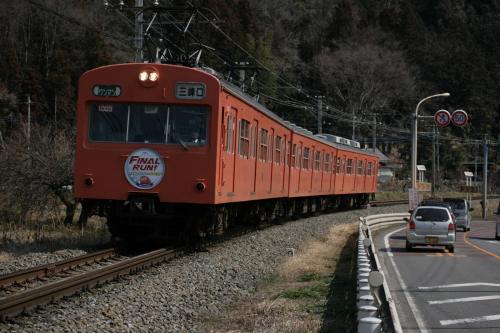
国鉄101系電車の系譜を見る
2014(平成26)年3月に引退する秩父鉄道1000系電車は、元国鉄101系電車である。今回は戦後昭和の日本の通勤電車の新時代を切り開いた101系電車の歴史を紐解いていく。101系電車は1957(昭和32)年に登場した、国鉄初の「新性能電車」。戦後の復興とその後の高度経済成長により、東京や大阪といった大都市圏で年々急増する国鉄電車の通勤輸送、特に中央線快速などの都心から郊外方面へとつながる路線において、需要に追い付くことができず、大きな改良を迫られていた。そこで「スピードが速く、乗り心地がよく、しかも性能のより高い電車」として1956(昭和31)年に計画された車両が101系である。カルダン駆動方式の採用など、旧来の車両とは抜本的に構造や性能が異なることから、「新性能電車」と呼ばれるようになった。塗装は「朱色1号」と呼ばれるオレンジバーミリオンとなり、「ぶどう色2号」の省線電車とは一線を画した。中央線快速=オレンジ色というイメージを作り出した車両こそ、この101系だったのだ。101系は当初、6両編成の基本編成と4両編成の付属編成の組み合わせで登場。10両全てがモーター付きの車両で加減速性能を向上させ、運行時分の短縮による輸送力増強を狙っていた。しかし101系に思わぬ不運がやってくる。10両全てをモーター付きとしたために、使用電力が変電所の限界を超えてしまうことが解り、性能を落としての運行を余儀なくされた。試験走行の結果、10両編成組成時で、10両全てモーター付きから、モーター付き6両、モーターなし4両(6M4T)に編成を組み替えることになった。その後は中央線快速をはじめ、大阪環状線、山手線(当時の車体色は黄緑色ではなくカナリヤ色)、中央・総武緩行線、京浜東北線、南武線、関西本線、片町線、桜島線、鶴見線、仙石線で活躍した。1980年代に入ると、201系や205系などの新型車両に置き換えられ、国電においては、中央線快速からは1985(昭和60)年、中央・総武緩行線からはJR化後の1988(昭和63)年に姿を消した。国電以外でも、南武線川崎~立川間で1991(平成3)年に、桜島線と鶴見線で1992(平成4)年に姿を消した。最後まで101系が残っていた南武線尻手~浜川崎間(浜川崎線)からも2003(平成15)年に姿を消し、国鉄・JRから101系が全て消えた。2007(平成19)年よりクモハ101-902が埼玉県・大宮の鉄道博物館にて展示されている。鉄道博物館に展示されているクモハ101-902 Kumoha 101-902 displayed in the Japan Railway Museum1985(昭和60)年からJR化後の1989(平成元)年にかけて、習志野電車区に所属していた車両を中心に、3両編成12本の36両が秩父鉄道へ譲渡され、同社では1000系を名乗っている。結果として、秩父鉄道1000系が最後まで残った101系となった。秩父鉄道1000系が注目されるきっかけとなったできごとが、前述のクモハ101-902の鉄道博物館での展示である。この直前より、「動く」101系が、博物館と同じ埼玉県内で見られる・乗れることを売りに、1000系の一部に国鉄時代に見られたオレンジバーミリオン、スカイブルー、カナリヤ色、黄緑色+前面黄色帯の各塗装が復活した。しかしこの時すでに新造から40年以上を経て老朽化が進んでおり、2009(平成21)年より東急電鉄から移籍してきた8500系(秩父鉄道7000系)と8090系(同7500系)に置き換えられることとなり、1000系の廃車が始まった。2014(平成26)年3月、国鉄101系の伝統色であるオレンジバーミリオン塗装を復活させた1003Fが、最後の最後まで現役で残った国鉄101系となった。1003Fの引退により、国鉄101系電車57年の歴史に幕が下りた。参考文献:鉄道ピクトリアル 2013年4月号 特集「101系電車」Chichibu Railway 1000 Series, retiring on this March, is old Japan National Railway 101 Series. This blog covers the historical commuter train, 101 Series.101 Series debuted in 1957 to solve the crowd, becoming more terrible as time went by, on the railway connecting metropolitan area and its suburb, such as Chuo Line. Its concept was "faster, more comfortable, and higher specification". Because of its innovation adoption such as cardan drive device, 101 Series was called "New Specification Units". The body was wholly painted orange, which was different from the older units and became the symbol colour of Chuo Line rapid service.The first set of 101 Series was made with 10 carriages (6+4, including 4 cab carriages), all of which were motored to improve the running performance to shorten the travellng time. However, an unluckiness struck; electric power substations couldn't supply enough electricity for 101 Series to show its ability to the fullest because of 10 motored carriages, so it had to slow down the performance. In consequence of result of the test run, 101 was rearranged the set to the one with 6 motered carriages when it consisted of a 10-carriage set.Then 101 Series spread to many lines in Tokyo and Osaka metropolitan area, such as Osaka Loop, Yamanote (yellow coloured on that time), Chuo Sobu local service, Keihin-tohoku, Nanbu, Kansai, Katamachi, Sakurajima, Tsurumi, and Senseki Lines.In 1980s, 101 Series started to be replaced by 201 Series and 205 Series. On railways in metropolitan area it retied from Chuo Line rapid service in 1985 and from Chuo Sobu Line local service in 1988 after National Railway's privatization. On other lines it did from Nanbu Line (Kawasaki - Tachikawa) in 1991 and from Sakurajima and Tsurumi Lines in 1992. The last remaining ones on Nanbu Line (Shitte - Hama-kawasaki) retired in 2003.From 2007 a cab carriage, Kumoha 101-902 in the first-made set displayed at the Japan Railway Museum in Omiya, Saitama Prefecture.12 sets of 101 Series, rearranged to 3-carriage, had moved to Chichibu Railway between 1985 and 1989, where it was renamed 1000 Series. As a result of the retirement from JR, they became the last remaining 101 Series. What cast a spotlight on 1000 Series was the regular exhibition on Kumoha 101-902 at the Japan Railway Museum. Since just before the museum's open 4 sets were repainted to the one in the JNR period, orange on Chuo Line rapid service, yellow on Chuo Sobu Line local service, light blue on Keihin-tohoku Line, and light green with yellow line on the front on Kansai Line and Chichibu Railway had sold itself as where JNR 101 Series regularly run.However, on that time, most of 1000 Series had passed over 40 years since their manufacture, so they started to be replaced by 8500 Series and 8090 Series from Tokyu Corporation (renamed 7000 and 7500). 1003F set, which was repainted to orange, the traditional colour of 101 Series since its debut, became the last remaining JNR 101 Series in a real sense.Reference: Railway Pictorial April 2013 issue "101 Series"
Mar 16, 2014
コメント(0)
-
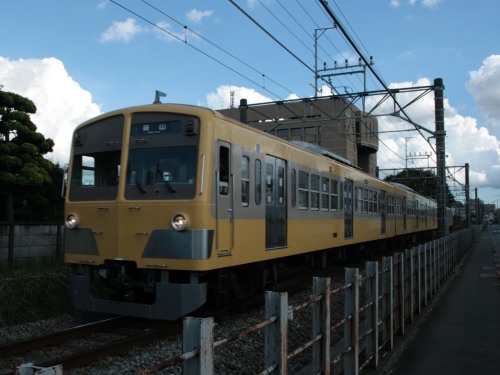
西武鉄道 2014年3月までに再上場か!?
15日朝、西武鉄道の親会社、西武ホールディングスと、同社の筆頭株主のアメリカの投資ファンド、サーベラス・キャピタル・マネジメントは、西武ホールディングスを2014年中に東証1部に上場させることで大筋合意したことが解ったとNHKのニュースで報道された。西武ホールディングスの上場を巡っては、昨年2013(平成25)年、サーベラスが西武秩父線などの鉄道路線の廃止、埼玉西武ライオンズの売却を含む経営再建案を出し、世間を騒がせるなど、両社の対立が色濃かった。結果として同案は否決され、路線が廃止されることと球団が他社の手に渡ることは免れた。その後も両社の議論は進み、今月ようやくその結果が出ることとなった。西武鉄道は2004(平成16)年に、当時の堤義明会長による有価証券虚偽記載が発覚して東証1部上場を廃止された。2006(平成18)年より、サーベラスの出資による支援のもと西武ホールディングスの設立に始まる経営再建を進め、再上場という当初の目標を8年越しに達成する。朝日新聞によると、上場達成後、西武ホールディングスはサーベラスに対して、保有株比率を段階的に引き下げていくよう交渉する方向でいるという。一方サーベラス側も、今年4月に控えた消費税増税の影響で景気が落ち込むことを懸念し、西武ホールディングスの要求を受け入れる方向でいるという。かのように見えたが、西武ホールディングスは15日付けのニュースリリースにおいて、これらの内容は「当社が発表したものではない」と否定、上場時期に関しても未定であるという発表をした。上場すれば、東京メトロを除く大手私鉄全社(阪急電鉄と阪神電気鉄道は阪急阪神ホールディングスとして、相模鉄道は相鉄ホールディングスとして上場)が東証1部に上場することになる。長かった西武鉄道の経営再建と再上場。路線廃止の危機を経て、まだ公式な発表はないものの、着実に再上場というゴールに近づいていることは間違いないと見てよいだろう。On 15th morning, an NHK news show covered an agreement between Seibu Holdings, the parent company of Seibu Railway, and Cerberus Capital Management, the biggest shareholder of Seibu Holdings, on Seibu Holding's public relisting of the shares on Tokyo Stock Exchange in 2014.Speaking of the discussion of the relisting, the two cut each other's throats in 2013 starting from Cerberus's sudden suggestion of the restructuring plan including the partial closing of some railway lines such as Seibu-chichibu Line between Agano and Seibu-chichibu and disposal of Saitama Seibu Lions baseball team, which created a sensational headline. As a result, the suggestion was rejected. After that, they kept discussion and achieved their goal. Seibu Railway was once delisted from the Tokyo Market because of doctoring portfolio by the former president, Yoshiyuki Tsutsumi, in 2004. Since 2006 Seibu has reconstructed its business including the establishment of the holding company in association with Cerberus. Then it is about to achieve its initial goal. According to an article on Asahi Shimbun, after the relisting Seibu Holdings is going to negotiate the gradual selling the share Cerberus owns. Cerberus is planning to give Seibu's demand to avoid the decline in the value of the stock because of the raise of the consumption tax on this coming April.However, Seibu Holdings deny the report was not from an official on their news release on 15th.If Seibu Holdings will come back to the Market, all of the major private railway companies in Japan except Tokyo Metro will be listed (in case of Hankyu Corporation and Hanshin Electric Railway, and Sagami Railway, their holding company is listed).Anyway, I see Seibu's goal must soon come true.朝日新聞デジタル 「西武HDの株、再上場へ合意 筆頭株主サーベラスと」 2014年1月12日NHKオンライン 「西武ホールディングス株式再上場申請へ」 2014年1月15日 (Japanese)西武ホールディングスニュースリリース 「昨日から本日の一部報道について」 2014年1月15日 (Japanese)
Jan 15, 2014
コメント(0)
-
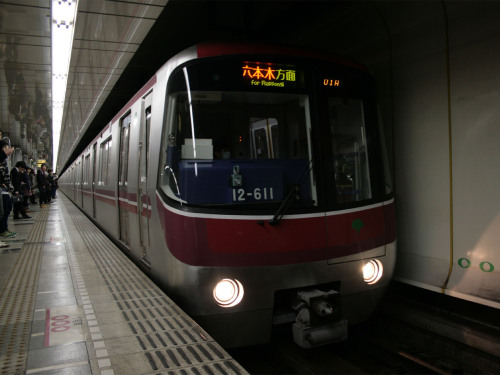
大江戸線大泉学園町駅延伸実現に向けて 経緯と現状
11月17日に大江戸線延伸促進大会へ参加したことをお伝えしたが、今回は大江戸線大泉学園町延伸の経緯と現状と、を書き表したい。On November 17th, I wrote that I heard a lecture meeting for extension of Toei Oedo Line to Oizumi-gakuencho, then this time I would like to write about the past background and the present. これまでの経緯 past background都営地下鉄大江戸線光が丘~大泉学園町間は、1985(昭和60)年に、環状部(都庁前~上野御徒町~清澄白河~六本木~新宿)と共に地下鉄12号(大江戸)線計画に組み込まれた。その後練馬区は2000(平成12)年の環状部開業に合わせて光が丘~大泉学園町間も同日開業させることを要望したが、東京都は地上部分となる道路の整備に時間を要するとして、道路整備に合わせて開業を検討するとした。2000(平成12)年、国の運輸政策審議会は、光が丘~大泉学園町間を2015(平成27)年までに整備すべき区間の1つと位置づけた。When the construction plan between Hikarigaoka and Oizumi-gakuencho first appeared was 1985, which was combined in the strategy of Toei Oedo Line together with the loop section from Tochomae [Tokyo Metropolitan Government].A few years later, Nerima-ku petitioned the extension to Tokyo Governmental Office at the same time as the loop section open in 2000. However, Tokyo Metropolitan answered that the plan started while seeing the construction of roadway above the planning tunnel because the Government had to invent much time to construct the roadway.In 2000, Council for Transport Policy announced that this section was set to one of the important railway plans to be achieved by 2015.現状 in the present大江戸線大泉学園町延伸は、練馬区の重要課題の1つと位置づけられており、実現に向けて練馬区は、延伸区間のトンネル建設予定地の地上部分にあたる道路(都市計画道路補助230号線)を整備する東京都、ならびに住民・東京都交通局などの関係者との協議が進められてきた。しかし鉄道事業認可について具体的な予定がまとまっておらず、東京都の姿勢としては、前述のとおり地上部分にあたる道路の整備に時間を要するため、この道路の整備状況等を踏まえ、関係者等と連携しながら、路線の整備について、課題や今後の方向性等を検討する、としている。資金面でも課題がある。東京都交通局の都営地下鉄部門の財政状況は、2006(平成18)年度以降6年連続で経常黒字を達成しているものの、未だに4000億円もの累積欠損を抱え、大江戸線についても減価償却費や支払利息で収支均衡が実現できていないのが現状である。一方230号線道路は光が丘~大泉学園町のすべての区間が2010(平成22)年までに事業認可が下り、このうち光が丘~土支田間は2013(平成25)年11月15日に開業した。残る区間も2016(平成28)年度までに開通する予定である。The extension has been one of the highest priority issue of Nerima-ku and the ward has discussed the extension with Tokyo Metropolitan Government, which constructs the roadway above the tunnel of the planning section, Bureau of Tokyo Metropolitan Transportation and residents along the section.However, because the concrete plan of getting railway business license isn't decided yet, Tokyo Metropolitan keep discussing the agenda and direction of the planning section while seeing how the roadway construction goes and discussing persons and organizations concerned.There is also financial problem; one-year balance of payment of Toei Subways has kept its business in the black, but still has about 400-billion yen debts and the balance on Oedo Line can't balanced out because of depreciation and interest.On the other hand, the construction license of the all of the roadway was approved in 2010. The section between Hikarigaoka and Doshida opened on November 15th, 2013, and the remaining section is opening by 2016.
Dec 27, 2013
コメント(0)
-
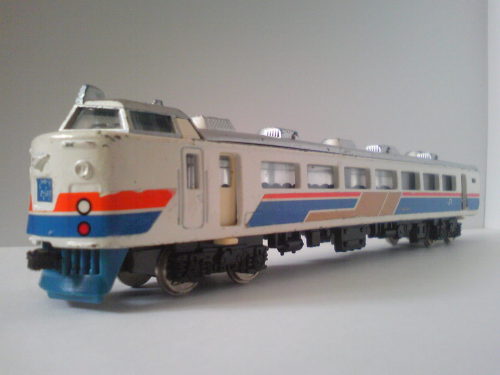
北陸新幹線の列車愛称「かがやき」について
10月10日、2015(平成27)年3月に開業予定の北陸新幹線の列車愛称が発表され、東京~金沢の速達列車を「かがやき」、東京~金沢の多停車列車を「はくたか」、富山~金沢の区間列車を「つるぎ」とそれぞれ命名し、東京~長野の区間列車を「あさま」の愛称で存続することとなった。「かがやき」と「つるぎ」は、いずれもかつて存在した在来線特急の愛称を復活させたもので、今回は東京~金沢の速達列車の愛称「かがやき」に着目する。「かがやき」という列車愛称は、かつて長岡~金沢を走っていた信越本線・北陸本線の特急列車に使用されていた。在来線特急の「かがやき」は1988(昭和63)年3月、JR最初のダイヤ改正で登場。上越新幹線と接続して、同区間を走る「北越」よりも少ない停車駅(途中の停車駅は直江津・富山・高岡のみ)で速達性を高めた列車という位置づけだった。車両は白地にオレンジ・青・ゴールドの塗装となった、金沢総合車両所の485系リニューアル車が充当された。かつて「かがやき」に使用されていた485系をイメージした模型当時の資料(「JR時刻表」1990(平成2)年4月号付録の「JR特急列車ハンドブック」)によると、上野~長岡ノンストップの上越新幹線と「かがやき」を乗り継いだ時の上野~金沢の所要時間は3時間56分だったという(当時は新幹線の東京~上野は未開業)。そのため人気が高く、当初4両編成2往復で運転開始したものの、後に6両編成4往復に増結・増発された。さらに1992(平成4)年には6往復に増発された。しかし1997(平成9)年3月、北越急行ほくほく線の開業に伴い、上越新幹線と接続する金沢行き特急の座を同線経由の「はくたか」に譲る形で運転を終了した。「かがやき」は、具体的な対象物がない「抽象名詞」の列車となる。新幹線の列車愛称として抽象名詞の採用は「のぞみ」以来2例目となる。またJR化後に登場した在来線特急の列車愛称が新幹線の列車愛称として復活することは、今回が初めてだ。「かがやき」という列車名は、E7系のゴールドの帯を象徴し、金沢の特産品の金箔の「かがやき」、金沢が歩んできた北陸の古都としての栄華、「かがやき」を表すものだと言える。新幹線「かがやき」は東京~金沢を約2時間30分で結ぶ。かつての在来線列車の愛称を復活させるのであれば、ルートが似ているため「のと」や「はくさん」も有力視されていたが、かつて金沢への最速達ルートを形成していた「かがやき」の愛称の採用は妥当だと言える。On October 10th, JR West and JR East announced that the trains on Hokuriku Shinkansen opening on March, 2015, named "Kagayaki"(for fastest ones between Tokyo and Kanazawa), "Hakutaka"(for ones stopping at more stations than "Kagayaki"), and "Tsurugi"(ones between Toyama and Kanazawa), and the ones between Tokyo and Nagano keep running after the extension and its name "Asama". "Kagayaki" and "Tsurugi" used to be the ones of limited express on conventional lines and this time focuses on the name "Kagayaki"."Kagayaki" limited express on conventional railway debuted in 1988 between Nagaoka, Niigata Prefecture, and Kanazawa, Ishikawa Prefecture, via Shinetsu and Hokuriku Lines, connecting Joetsu Shinkansen and faster than "Hokuetsu" limited express on the same section (it stopped at Naoetsu, Toyama, and Takaoka Stations only). The rolling stock for "Kagayaki" was refurbished 485 Series on Kanazawa shed, repainted in white, orange, blue, and gold.According to the "JR limited express handbook" published in 1990, it took 3 hours and 56 minutes between Ueno and Kanazawa by Joetsu Shinkansen travelling non-stop toNagaoka and "Kagayaki"(Shinkansen between Tokyo and Ueno didn't open that time). Due to that reason, it got popular and grew from 4-carriage to 6-carriage and from 2 round trips a day to 4. In 1992 its operation increased to 6 round trips.However, in 1997, due to the open of Hokuetsu Express Hokuhoku Line, all of "Kagayaki" were replaced by "Hakutaka" via Hokuhoku Line."Kagayaki", meaning "shining" in Japanese, is the name after abstract noun, and it is second time to introduce an abstract noun for Shinkansen train following "Nozomi" on Tokaido and Sanyo Shinkansen. In addition, the revival of the train name after the privatization in 1987 as the one for Shinkansen is first time.The name "Kagayaki" inspires the gold line on E7 Series' body, gilt, a famous product in Kanazawa, and the glory of Kanazawa as the ancient capital in Hokuriku region.It takes about 2 and half hours between Tokyo and Kanazawa by "Kagayaki" on Hokuriku Shinkansen. It was said that, if a name of a express or limited express on conventional railway revives, "Noto" or "Hakusan" was dominant because of the similar route. However, it is appropriate to be named "Kagayaki" due to the fastest route to Kanazawa.TOMIX 98924 【予約】限定 485系 かがやき・きらめきセット Nゲージ 動力車入り価格:19,320円(税込、送料別)
Oct 12, 2013
コメント(2)
-
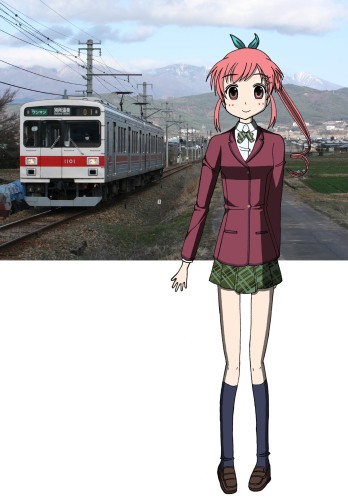
上田市アイプロジェクト 活動休止宣言から路線バス支援進出へ
上田電鉄別所線存続支援サイト「別所線に乗ろう!」を運営している長野県上田市の市役所職員有志による別所線応援チーム「上田市アイプロジェクト」が別所線の支援活動を休止し、市内の路線バスの支援にも進出すると発表した。ことの発端は去る9月24日、突然とも言える発表だった。上田市アイプロジェクトによる別所線存続支援活動と、存続支援サイトとして2003(平成15)年から運営してきた「別所線に乗ろう!」の更新が、9月30日をもって休止するというものだった。アイプロジェクトはこれまでに様々な企画きっぷを販売し、「別所線に乗ろう!」のWebサイトも、別所線の窮状を伝えることにより、地元客・観光客を増やすために機能していたと言え、アイプロジェクトはサイト更新休止の理由を「サイト開設10周年を迎え、乗客が増えるなど一定の効果を得ることができた」としているが、2009(平成21)年以降、一度増えた利用客数が再び減少に転じ、2012(平成24)年は微増となったものの、窮地を脱したとは言いがたかった。「別所線に乗ろう!」公式Twitterには多くの活動休止を惜しむ声が寄せられ、それに応えるかのように、「別所線に乗ろう!」Webサイトの運営継続と、10年間の別所線支援活動で培ったノウハウを活用して、別所線と共に上田市の重要な公共交通である路線バスの支援活動への進出を、25日に発表した。僕も別所線の窮状をこの「別所線に乗ろう!」のサイトで知り、2009(平成21)年に初めて乗りに行った。見慣れた東急電車が塩田平の中をのんびりと走る光景や、中塩田駅、八木沢駅、別所温泉駅といった昔の姿のまま残っている駅舎が気に入り、個人的に応援することを始めた。東急電車が走るローカル線として、かわいい北条まどかちゃんに会える路線として、上田市の支援がなくても走り続けられるように、応援を続け、2度目の乗車についても考えていきたい。On 24th, I Project, the volunteer group organized by officers of Ueda City, Nagano Prefecture, to support Ueda Electric Railway and manage the website "Bessho-sen ni Norou!", which has been continuing since 2003, announced that their official support to the railway and update of the website stopped on this coming September 30th, and the group newly starts the support to the buses in the city on 25th.By selling the several kinds of discount tickets and telling the viewers the distressed condition, the group and its website has been functioned to keep the support. The group says the reason for the end of its support is the group's act can achieve its effect, such as increasing the number of passengers. However, the number of passengers had been declined between 2009 and 2011, which is difficult to say that the railway emerged from its stuck state, from my point of view. By seeing the announcement on the website, many people sent messages expressing regret over the discontinuing support and website on the group's official Twitter. Responding their messages, the group keep managing the website and expand its new business using the knowhow having acquired through the railway support act for 10 years.I first know the stuck state of Bessho Line on this website and go travelling in 2009. The scene the trains coming from Tokyu Corporation running in the quiet Shioda-daira basin and some station buildings keeping the old atmosphere, such as Naka-shioda, Yagisawa, and Bessho-onsen, attract me. Since then I also started personal support.I wish Bessho Line keep beloved as the railway where we can meet Tokyu unit and its mascot girl, Madoka Hojo, and, running without the group's support in good condition. And I would like to plan my second travel.
Sep 27, 2013
コメント(0)
-

西武秩父線利用促進協議会が観光コースなど新たな模索
先日、NHKのニュースで西武西武秩父線の利用促進協議会が新たな観光コースの設定など新たな活動を始めるというニュースを聞いた。今年の西武鉄道とサーベラス・キャピタル・マネジメントとの間で顕在化した、西武鉄道の経営をめぐる問題で、サーベラスが西武秩父線の廃線を提案したのではと一部で報道されたことから、沿線5自治体(秩父市・横瀬町・皆野町・長瀞町・小鹿野町)が路線存続を求めて利用促進協議会を組織した。6月の取締役会でサーベラスの人事案がすべて否決されたため、西武秩父線の廃線は回避された。しかし廃線が回避されたからといって楽観視はできない。利用客を増やして、路線を末永く維持していくための方法を考えていかなくてはならない。西武秩父駅の2012(平成24)年度の利用客数は6655人と、2003(平成15)年度の8194人と比べて20%減となっているのが現状である。そこで秩父市など西武秩父線利用促進協議会を組織する沿線5自治体が連携して新たな観光コースの設定などを模索し、西武秩父線の利用客を増やす活動を今後展開していく。課題としては、西武秩父駅以外の利用客を増やすことだ。西武秩父線各駅の利用客数が1000人を超えるのは西武秩父駅と横瀬駅のみで、他の4駅が1000人以下と極端に低い傾向にある。中でも正丸駅は西武鉄道全駅中9年連続の最下位(92位)で、2012(平成24)年度は1日平均287人である。この利用促進事業は「埼玉県ふるさと創造資金」の補助を受けられることになり、県と沿線自治体が一体となって鉄道を守っていく姿勢が見て取れる。僕の目から見れば、今が西武秩父線の利用客と秩父地域への観光客を増やす絶好のチャンスと言える。今年3月16日に西武池袋線と東急東横線・横浜高速鉄道みなとみらい線との相互直通運転が開始され、西武鉄道は新たに同線沿線地域からの観光需要を掘り起こそうとしている。さらには秩父市を舞台とし、西武秩父線の車両(4000系)も登場するアニメ「あの日見た花の名前を僕達はまだ知らない。」の劇場版の公開を8月31日に控え、同作のTVシリーズが放送された2011(平成23)年以降増えている作品に描かれた風景を求める観光客がより一層増えることが予想されるためだ。西武鉄道、沿線自治体、利用客それぞれが、それぞれの需要を満たし、西武秩父線と沿線の街の魅力向上と永続的な発展を願いたい。Some days ago I heard a news about the new action of the promotion for riding Seibu Seibu-chichibu Line, organized by 5 regional governments such as Chichibu City, to set new tourist courses.The conflict between Seibu Railway and its largest holding company, Cerberus Capital Management, over Seibu's stock price and management plan lead the coverage that Cerberus proposed the abandonment of Seibu-chichibu Line. To avoid the close of the railway, Chichibu City and Yokoze, Nagatoro, Minano, and Ogano Towns organized the promotion conference.Due to The rejection of all proposal by Cerberus on board meeting on this June, the close avoided. However, the governments had better can't see it optimistically to practice how to maintain the railway and to draw more tourists parmanently to gather more tourists. The number of the people using Seibu-chichibu Station in 2012 was 6655, which was 20% less than that in 2003. The organization tries the promotion for tourists.What the governments have to do is how to increase the number of the users except Seibu-chichibu Station. The number of people using Seibu-chichibu and Yokoze in 2012 was over 1000, but the other 4 under 1000, especially, that of Shomaru Station has ranked very bottom among all stations on Seibu railway for 9 years on the daily average.This promotion get the subsidy from Saitama Prefecture, which seems to show the orientation of the Prefecture and the Cities and Towns.Now must be the best chance to promote the Chichibu area and Seibu-chichibu Line because Seibu expects the new tourists coming from the area along Tokyu Toyoko and Yokohama Minatomirai Railway Lines, which some of Seibu Ikebukuro Line train started to go through from this March 16th, and the release of a movie version of "Anohi Mita Hana no Namae wo Bokutachi wa Mada Shiranai", set in Chichibu City and Seibu-chichibu Line train(4000 Series) appearing on, on this coming August 31st.I wish this action draws more tourist to Chichibu area and leads the long-term development of the railway which 3 of them, Seibu Railway, the organization, and the tourists can be satisfied.埼玉県 彩の国ニュース 「西武秩父線利用促進など21の支援事業を発表 埼玉県ふるさと創造資金第2回分」秩父市 久喜邦康の市長ブログ2013年5月15日 「西武秩父線利用促進協議会設立の記者会見」
Aug 1, 2013
コメント(0)
-
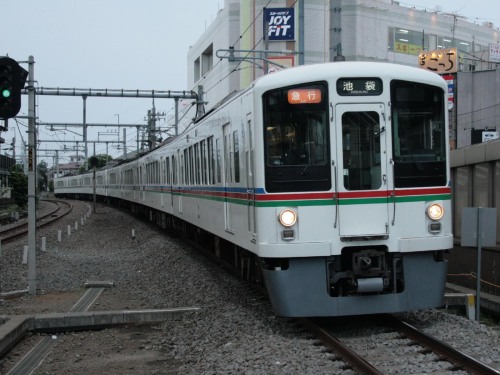
西武vsサーベラス 協議するも進展なし
去る6月25日の取締役会後初めて、西武鉄道の親会社・西武ホールディングスと同社の筆頭株主・サーベラス・キャピタル・マネジメント社の重役が会談を開いた。会談には、西武ホールディングス側の意向によって、同じく西武ホールディングスに出資している日本政策投資銀行と農林中央金庫の役員も出席した。両者は引き続き西武ホールディングスの東証再上場について話し合ったものと思われるが、結果はお互いの主張を発表するに留まり、何の進展もなかったという。西武ホールディングスの再上場をめぐって両社が対立し、サーベラス側は一部西武鉄道路線の廃止や埼玉西武ライオンズ球団の売却を含む大胆な経営再建策の提案も辞さない態度で株の公開買い付け(TOB)に臨み、対立が表面化・深刻化した。結局個人投資家などの賛同を得られず、サーベラスが取得できた株式数は目標に大きく届かず、人事案も否決された。The first executive conference of Seibu Holdings and Cerberus Capital Management, together with that from the two of the biggest shareholder, Development Bank of Japan and Agricultural and Forestry Central Bank, according to the wishes of Seibu, after the regular board meeting on June 25th was held.At the conference, they might discuss the re-listing of Seibu continuously, but they just defend their opinion each other and nothing was resolved.Seibu and Cerberus has conflicted arising from the open price of Seibu's stock to relist it to Tokyo Market. However, the conflict went bad because of Cerberus' takeover bid and argument for the better management including closing some unprofitable railway lines and selling Saitama Seibu Lions baseball team. As a result, Cerberus could get less stock than their aim and the new personnel proposal was rejected.参考文献 Reference(All Japanese)時事通信社 「西武とサーベラスが会談=上場問題、進展なし」 2013年7月5日読売新聞 「西武とサーベラス、幹部協議は「何も変わらず」」 2013年7月5日ロイター 「西武HDとサーベラスが会合開き直接対話、株主総会後初めて」 2013年7月5日
Jul 6, 2013
コメント(0)
-

サーベラスの提案はすべて否決 西武鉄道とサーベラスの一連のTOB問題をまとめてみる
6月25日、サーベラス・キャピタル・マネジメント社の株の公開買い付け(TOB)以降初めての西武ホールディングスの取締役会が開かれ、サーベラス社が提案した人事案を否決した。これにより、サーベラス社が西武ホールディングスの経営再建策として提案したと言われていた西武秩父線などの一部路線の廃線や埼玉西武ライオンズの売却騒動に決着がついた形だ。今年、鉄道界・実業界を騒がせた西武ホールディングスとサーベラス・キャピタル・マネジメントとの間で繰り広げられた株の買い増しと一部路線廃線・埼玉西武ライオンズ売却をめぐる問題をまとめてみた。この問題は、西武鉄道の親会社(持ち株会社)、西武ホールディングスの筆頭株主であるアメリカの投資ファンド、サーベラス・キャピタル・マネジメントが、西武ホールディングスの東京証券取引所再上場後の株価を高めるために、TOBを実行し、経営に対して影響力を強めようとしていることに始まる。買い付けの条件として、株の資産価値を高めるために西武鉄道の、西武秩父線や山口線など、いくつかの鉄道路線を廃線にし、埼玉西武ライオンズも他社に売却する経営改善策を西武ホールディングスに要求していると、一部のニュースなどで報道された。この時廃線を提案されたと報道された路線は、・ 西武秩父線(吾野~西武秩父)・ 山口線(西武球場前~西武遊園地)・ 国分寺線(国分寺~東村山)・ 多摩湖線(国分寺~西武遊園地)・ 多摩川線(武蔵境~是政)の各線である。路線が極端に短い豊島線と西武園線の廃線提案はなかった。この報道に対して西武ホールディングス・西武鉄道両社は廃線と球団売却を否定し、サーベラスもそのような提案はしていないと否定した。株主となっている個人投資家や鉄道ファンからも「サーベラスは鉄道会社を経営することの意味が解っていない」「利益追求だけで鉄道を廃線にしてはいけない」とサーベラスに対して批判が相次ぎ、埼玉県と沿線自治体が西武鉄道に、提案された路線を廃線にしないように嘆願し、上田清司埼玉県知事が自ら秩父の観光PRを行うなど、路線の存続に向けて精力的な活動を実施した。サーベラス社はもともと2004(平成16)年に発覚した堤義明元会長ら創業者一族による株保有率の虚偽記載事件による東証一部上場廃止後、経営権の掌握目的ではなく、西武鉄道ならびに西武ホールディングスの経営再建の支援を目的として、2006(平成18)年に西武ホールディングス株を保有し始めた。しかし2012(平成24)年、西武ホールディングスの上場後の株の公開価格を巡って両社が対立。さらに東証再上場の条件として『特定の株主に「特別な権利」を与えてはいけない』というルールがあったため、西武ホールディングスはサーベラス社をはずして上場準備を進めようとした。これに対してサーベラス社は、西武ホールディングスの一方的な提案拒否や資本提携の解消には応じないと強気の姿勢を見せた。その後サーベラス社が今後起こり得る経営再建策として西武秩父線・山口線などの廃線や埼玉西武ライオンズの売却が挙がっていることが明るみになると、両社の関係悪化がさらに深刻なものとなった。結果としてサーベラス社の買い増した西武ホールディングス株は3.04%に留まり、当初予定していた44%に達することはなかったが、同社の保有比率が35.48%となり、33.3%を超えたため、サーベラス社は西武ホールディングスならびに西武鉄道グループ各社の経営に対して株主総会での重要案件の拒否権を手にすることができた。そのため、6月25日の西武ホールディングスの取締役会も注目の的となった。913人の株主が参加する中、取締役会は約5時間にもおよび、サーベラスが提案した新たな人事案は反対多数で否決された。否決した理由としては、「ライオンズの売却や路線の廃止は中長期的な企業価値を損なうから」と西武ホールディングスは発表した。僕の個人的な見解としては、今年2013(平成25)年3月16日のダイヤ改正で東急東横線・横浜高速鉄道みなとみらい線との直通運転を開始した反面、西武秩父線・池袋線の4000系で運転されていた「快速急行」のうち夕方~夜間の上り列車が「急行」に格下げされてしまったことが、西武秩父線のマイナス評価に繋がってしまったとの見方もできなくない。しかし秩父は決して観光資源が乏しいわけでもなく、東洋経済試算の西武秩父線の1日・1kmあたりの輸送人員は8258人と利用客数が極端に少ないわけでもない。山口線に関しては、残念ながら廃線を提案されてもおかしくない路線と言える。実際、東洋経済調べの各鉄道路線の2010(平成22)年度の営業係数(100円の収入を得るのに必要な投資額を表す数値)が、西武山口線は515.3と関東地方の鉄道路線ではJR鹿島線(552.0)、久留里線(533.9)、烏山線(529.7)に次いで悪く、大手私鉄の路線中でも最悪だった。これはJRの留萌本線(518.8)、水郡線(508.5)、磐越西線(506.0)、他の私鉄で言えば紀州鉄道(515.1)に匹敵する値であり、阿佐海岸鉄道を除く転換三セク各線よりも悪い数字である。そして、我々が理解しなければならないのは、一部路線廃線や埼玉西武ライオンズ売却はあくまでも今後起こり得る経営再建策の一つの方法としてサーベラス社が挙げた一件にすぎず、現時点では正式な提案ではないということであると言える。僕はサーベラス社によるTOBおよび廃線提案が報道されて以降、このことに関してまったくこのブログで扱うことをしなかったが、西武鉄道利用者として、決してただ黙っていたのではなく、しっかりと経過を見届けて、落ち着いてからまとめて書こうとしたのである。At the first regular board meeting after the takeover bid by Cerberus Capital Management, the biggest shareholder, on June 25th, Seibu Holdings denied the proposal by the fund. The problem whether some railway lines, such as Seibu-chichibu Line and Yamaguchi Line, etc. and Saitama Seibu Lions baseball team would be relinquished was closed. This time, I would like to write about Cerberus Capital Management's takeover bid for Seibu Holdings, the parent company of Seibu Railway, and its proposal for the partly railway close and disposal of Saitama Seibu Lions, which made a sensational headline this year.What triggered this problem is some TV news covered the fund's announcement of the takeover to strengthen its control over Seibu Holding's management to try to raise the price of Seibu's stock with the abolishment of some unprofitable railway lines and the baseball team to accept the takeover. The lines Cerberus proposed to close were・ Seibu-chichibu Line(Agano - Seibu-chichibu)・ Yamaguchi Line (Seibu-kyujo-mae - Seibu-yuenchi)・ Kokubunji Line (Kokubunji - Higashi-murayama)・ Tamako Line (Kokubunji - Seibu-yuenchi)・ Tamagawa Line (Musashi-sakai - Koremasa)However, Toshima Line (Nerima - Toshimaen) and Seibuen Line (Higashi-murayama - Seibuen), which are very short and have just 2 stations, weren't proposed.After the news spread, Seibu denied the abandonment, and Cerberus did the proposal.Some Seibu's shareholders and railfans criticized that the fund didn't know the meaning of the railway management and the abolishment of railway only for the profit. Saitama Prefectural governor Kiyoshi Ueda and the mayors of some cities in Saitama along Seibu Railway lines tried to appeal for more visiting their city to avoid the railways' close. Since 2006, for the management reconstruction support after the manipulation of ratio of stock holding by the former president Yoshiaki Tsutsumi and the delisting in 2004, not to take control, Cerberus has held the 32.4% stock of Seibu Holdings. However in 2012, the two had a trouble setting a price of the Seibu's stock after being listed on Tokyo Stock Exchange(TSE). In addition, Seibu prepared for the relisting without Cerberus because TSE ruled the listed companies not to give a special rights to a particular shareholder. Cerberus decided to refuse one-sided denials of the suggestion and terminating the capital affiliation. As the new suggestion of the reconstruction plan with the abolishment of unprofitable railway lines and sale of the baseball team was revealed, the relation of the two went worse.As a result, Cerberus could get more 3.04% point. However, adding the 32.44% still being held, Cerberus succeeded to hold over one third, 35.48%, stock, which can exercise the veto over the important issues at the board meeting. So, how Seibu Holdings board meeting on June 25th went paid attention of the supporters.Attending 913 persons, the meeting took about 5 hours and the most present rejected the new personnel proposal by the fund. Seibu Holdings announced that the reason of the refusal was not to lose long-term value of the company.In my opinion, the rapid express trains from Nagatoro and Mitsumineguchi via Seibu-chichibu on the holiday evening becoming the express on this March might see why Seibu-chichibu Line received negative appraise. However, Chichibu Area has many tourist attractions and Toyo Keizai Magazine estimated Seibu-chichibu Line transports 8258 passengers per kilometre and day.The Operation ratio of Seibu Yamaguchi Line in 2010 was 515.3, which was the fourth worst in the railways in Kanto Area (following JR Kashima Line (552.0), JR Kururi Line (533.9), and JR Karasuyama Line (529.7)), the worst in the one operated by the 15 biggest private railway companies in Japan, and was worse than the rural railways inheriting abandoned national or JR Lines except Asa Kaigan Railway. The number 515.3 was a match for that of JR Rumoi Line (518.8), Kishu Railway Line (515.1), JR Suigun Line (508.5), and JR Banetsu West Line (506.0).In conclusion, what you must understand is the part railway abolishment and baseball team sale would be an unofficial proposal for the restructure which is expected in future.Since the news spread abroad, I haven't tried to write about it, but, as a person living in Seibu Railway area and using the railway, I didn't keep silent with no reason. I observed the purchase to wait for the end to write my opinion.参考文献 Reference東洋経済オンライン 「西武秩父線は本当に収益力がないのか」 2013年4月4日東京新聞 「32万人「路線存続を」 所沢など4市長 西武に署名提出」2013年5月20日ウォールストリートジャーナル 「Cerberus vs. Seibu: Board Games」 2013年5月28日(英語)ウォールストリートジャーナル 「Cerberus Capital Battles With Japan's Seibu」 2013年5月31日(英語)ウォール・ストリート・ジャーナル 日本版 「ロマンス破れ対立深刻化―西武とサーべラス」 2013年5月31日ロイター 「サーベラスの西武TOBに3.04%が応募、保有比率35.48%に」 2013年6月1日ロイター 「UPDATE 1-Cerberus lifts Seibu stake but short of 44.7 pct goal」 2013年6月1日(英語) ロイター 「Cerberus lifts Seibu stake but short of 44.7 percent goal」 2013年6月1日(英語)現代ビジネス 「サーベラスはなぜ四面楚歌となり、西武HDのTOBに失敗したのか」2013年6月5日時事通信社 「サーベラス提案を否決=株主総会5時間弱-西武HD」 2013年6月25日ロイター 「Seibu shareholders reject Cerberus slate of directors」 2013年6月25日(英語)
Jun 25, 2013
コメント(0)
-
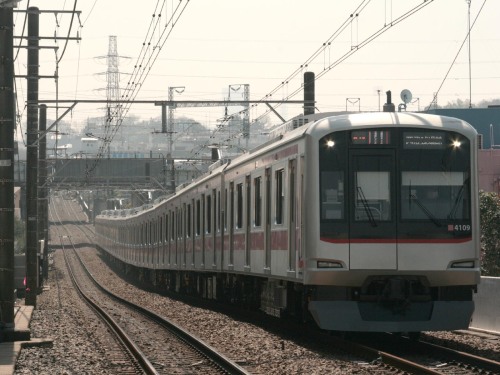
もしも東急東横線の「特急」を正式に「東横特急」に改称したら
2001(平成13)年の運行開始以来、東急東横線の主力列車として活躍している「東横特急」。渋谷駅~横浜駅間で競合するJR湘南新宿ラインとは運賃の安さで勝ち、所要時間でもほぼ互角であり、よい勝負を繰り広げていると言える。今年2013(平成25)年3月16日からは、東京メトロ副都心線への直通運転を開始し、湘南新宿ラインとの競合区間が池袋駅まで延びた。「東横特急」は東急東横線の特急列車の愛称であり、正式な種別名および案内表示は「特急」である。前述のとおり2013(平成25)年3月16日以降、東横線は副都心線との直通運転を開始したが、直通運転先の副都心線では「急行」、西武池袋線では「快速急行」と別々の種別を名乗り、少々ややこしい感がある。またある程度種別の変化パターンは決まっているものの、例えば西武池袋線から乗車する際に「この電車は東横線では『東横特急』に変わるのだろうか」と不安になる乗客も少なからずいるのではないかと思う(これは同じ東急電鉄でいえば、東武伊勢崎線を急行で来たにも関わらず、田園都市線でも急行のままかと思いきや各停に変わってしまう列車と同様の不安であると言える)。さらに言えば、東武東上線では東京メトロ副都心線・有楽町線から来た列車はすべて「各停」に格下げされてしまい、ふじみ野駅で快速列車に抜かれてしまうため、持ち前の速達性を損ねている。そこで僕は、各社の種別を「東横特急」に統一し、阪神と山陽電鉄の「直通特急」のように、東横線直通であることと、直通先各線でも速達性のよさを強く宣伝することを提案する。東京メトロ副都心線では、地下鉄としては珍しい速達列車として「急行」列車の設定があり、東横線の「特急」も副都心線では「急行」に変わる。副都心線でも現在の「急行」とまったく停車駅が同じであるが、東横線に合わせて「東横特急」を新設。副都心線の待避可能駅が渋谷駅と東新宿駅しかないうえ、小竹向原駅~和光市駅間で有楽町線と線路を共用している関係もあるため、速達列車の増発は難しいと思われる。都営浅草線のように直通先に種別を合わせることで、渋谷駅での「特急」の種別変更をなくす。東横線の「特急」は、西武池袋線では現在多くが「快速急行」として運転されている。現在と停車駅の変更はないものの、副都心線・東横線直通の「快速急行」(運行管理上は「直通快急」として区別)は、池袋駅発着の「快速急行」とは練馬駅に停車するか否かの違いがあるため、西武池袋線内でも「東横特急」として独立させて区別。一方現在同線で「特急」の種別を使用している西武10000系で運行されている池袋駅発着の「特急」は、京成の「スカイライナー」や名鉄の「ミュースカイ」と同様に、元来車両愛称である「レッドアロー」に改称する。これと同時に「東横特急」の停車駅に西武球場前駅を追加し、西武ドームでの埼玉西武ライオンズ戦の野球開催日には元町・中華街駅から西武球場前駅へ直通の「東横特急」を運行する。現在も野球開催日に西武球場前行きの「特急」が運行されているが、西武池袋線では西武球場前駅が「快速急行」の停車駅に指定されていないため、「快速」に格下げされている。この列車は通常「特急」小手指行きとして運行されている列車の行き先と西武池袋線内の種別を変更する形で運行されており、種別が「快速」に変更されるひばりヶ丘~西所沢間と運休となる西所沢~小手指間を補う臨時の「快速急行」小手指行きにひばりヶ丘駅で接続している。またこの西武球場前行き「東横特急」に愛称を付けて乗車促進を宣伝することも提案する。僕が考案したものは、「つながるベースボール号」(東横線・副都心線直通運転のキャッチフレーズ「渋谷、つながる」と野球の英語「ベースボール」から命名)である。横浜スタジアムでの横浜DeNAベイスターズと埼玉西武ライオンズの交流戦開催日には、横浜スタジアムが近接する日本大通り駅に臨時停車することも合わせて提案する。東武東上線にも、現在は地下鉄直通列車はすべて「各停」となっているが、初の副都心線直通列車専用種別として「東横特急」を新設して、速達化と差別化を図る。和光市駅以西の停車駅は「快速急行」と同じとし、全列車森林公園駅折り返しとする。その代わりに、池袋発着の快速列車を減便させる。東上線内の停車駅を「快速急行」と同一にする理由は、ふじみ野駅での「快速」待避を解消し、「東横特急」の速達性を向上させて、横浜~川越間の所要時間をより短縮させ、競合するJR湘南新宿ライン・埼京線に対抗する目的である。実現すれば、横浜~川越を日中時で86分から72分に短縮することができ、同区間90分を要し、1回乗り換えが必要な湘南新宿ライン・埼京線との所要時間の差が広がり、乗り換えがないことも合間って、より「東横特急」が選ばれるようになることを狙う。また横浜~森林公園も93分で結ぶことができる。森林公園駅発着とする理由は、坂戸駅以北と越生線がフリーエリアとなる「東急東武東上線ハイキングきっぷ」利用者の利便性向上を狙うためである。路線図では、有楽町線・副都心線は東上線の「森林公園駅まで直通運転」と書いてあるものの、両線からの森林公園駅発着列車は早朝と夜間の東武車による入出庫列車のみであり、日中時間帯、および東京メトロ車と東急車による運用は皆無である。ちょうどこれと逆の事例が、東武伊勢崎線・日光線へ直通している日比谷線である。日比谷線は今年2013(平成25)年3月16日より一部列車の東武伊勢崎線・日光線への直通区間を南栗橋駅まで延伸されたが、3月15日までは東武動物公園駅までであった。路線図でも「東武動物公園駅まで直通運転」と案内されていたものの、実際には早朝と夜間に東武車による入出庫列車に南栗橋駅発着が見られた。しかし日中の直通運転はあくまでも東武動物公園駅までであったため、「東武動物公園駅まで直通運転」という案内表示であった。このため、「森林公園駅まで直通運転」という案内表示は実態にあっておらず、日中でも森林公園行きの直通列車が走っているのでは、「東急東武東上線ハイキングきっぷ」のフリーエリアまで乗り換えなしで行けるのではという誤解を招く可能性がある。加えて、朝夕のラッシュ時間帯には「通勤特急」を新設し、副都心線内は現行の「通勤急行」と同じ停車駅、西武池袋線内は「急行」の停車駅に新桜台駅と練馬駅を加えたもの、東武東上線内は「快速急行」の停車駅に北坂戸と高坂を加えたものとする。相互直通運転が顕著な現代の鉄道に必要なものは「列車種別の解りやすさ」、「直通運転先との列車種別の統一」であると言える。早く、そして速く目的地に着ける列車の存在は非常に便利なものであるが、途中で種別が変わってしまうことは利用客に解りづらさを与えてしまう。東横特急の場合は特に東上線に直通する列車が、和光市駅までは通過駅がある速達列車で来たものの、和光市駅以西で各停に格下げされ、ふじみ野駅で後続の東武池袋駅発着の快速列車に追い抜かれてしまう。そのため、その解りづらさを顕著に感じやすいものの1つと言える。一方西武池袋線直通は、現状でも「東横特急」の速達性を直通先でも存分に活用しているダイヤであると言えるが、やはり種別名がころころ変わるようでは解りづらい。最後に、横浜駅へ、元町・中華街駅へ、乗り換えなしで速く行ける、東横線の最大のウリとも言える「東横特急」だけに、その名とその速達性・利便性を直通先でもアピールすることが必要であると言える。「東横特急」という統一された種別によって5社の結束力を高め、直通列車を充実させ、より力を入れることが必要であると言いたい。Since 2001 the limited express on Tokyu Toyoko Line, commonly called "Toyoko Limited Express", has run and gathered many passengers as fast and convenient train between Shibuya and Yokohama. Comparing with JR Shonan Shinjuku Line, with which competes in the whole section, Toyoko Line is cheaper and almost as fast as JR. From this March 16th, it starts to go through Tokyo Metro Fukutoshin Line and the competing section is extended to Ikebukuro.Since the start of the going-through service to Fukutoshin Line, it operates as the different kind when going into Fukutoshin, Seibu Ikebukuro, and Tobu Tojo Line, such as express on Fukutoshin Line, rapid express on Seibu Ikebukuro Line, and local on Tobu Tojo Line. While the pattern of the kind change is almost steady, it sometimes bothers the passengers with the question that whether it changes limited express on Toyoko Line like that of express train on Tobu Isesaki and Nikko Line train changing to local on Tokyu Den-en-toshi Line. To resolve this problem, I suggest that the name of limited express officially changes to "Toyoko Limited Express" not only on Toyoko Line, but also on Fukutoshin, Seibu Ikebukuro, and Tobu Tojo Lines to emphasize the fast speed and the train which goes through Toyoko Line like "going-through limited express" on Hanshin Electric Railway and Sanyo Electric Railway.Tokyo Metro Fukutoshin Line has the express train service and Toyoko Line limited express, as I wrote before, changes this from Shibuya. Though stopping at the same stations as the express, the new kind "Toyoko Limited Express" would be created. It seems to be difficult to increase the number of the fast train because the stations where the local train can wait for passing express are only Shibuya and Higashi-shinjuku, and Fukutoshin Line shares the track with Yurakucho Line between Kotake-mukaihara and Wakoshi.Mainly in the daytime, Toyoko Line limited express train operates as rapid express on Seibu Ikebukuro Line. Because rapid express coming from/to Toyoko and Fukutoshin Lines stops different stations from that from/to Ikebukuro on Ikebukuro Line, the one from/to Toyoko Line stops at Nerima but the other doesn't, the the former should be given a different kind to distinguish between those two. In addition, because limited express for Seibu-kyujo-mae Station specially operating on the day for a baseball game at Seibu Dome, the home field of Saitama Seibu Lions, in the present changes rapid from Kotake-mukaihara, it would be better that Toyoko Limited Express would specially go to Seibu-kyujo-mae and stops at Nihon-odori Station, one of the accessible station to Yokohama stadium, the home field of Yokohama DeNA Baystars, and this train would be named such as "Tsunagaru Baseball Train", after "Shibuya Tsunagaru (connect at Shibuya)" advertising copy for the going-through service. On the other hand, limited express trains operated from/to Ikebukuro by Seibu 10000 Series changes its service name to "Red Arrow", originally used as the affectionate nickname for the unit which become the train service name like "Skyliner" on Keisei and "Mue Sky" on Meitetsu.On Tobu Tojo Line, all trains coming from Yurakucho or Fukutoshin Lines including limited express stops all stations from/to Wakoshi. In my opinion Toyoko Limited Express would stop at the same stations as rapid express from Wakoshi and all of them would go to Shinrin-koen to be faster than the current and resolve the waiting for following rapid train passing at Fujimino. If it were true, it would take 72 minutes, 14 minutes faster than the current and 18 than JR Shonan-shinjuku and Saikyo Lines, and 93 minutes to Shinrin-koen. In addition, going to Shinrin-koen, it would be more convenient to "Tokyu Tobu Tojo Line Hiking Ticket", which passengers can allow unlimited travel between Sakado and Yorii on Tojo Line and whole of Tobu Ogose Line. The route map says that some of Fukutoshin Line and Yurakucho Line trains go through Tojo Line to Shinrin-koen, but actually the train for Shinrin-koen from/to these two subway lines operate in the morning and evening only and only by Tobu units to go out of or go back to the train shed. The opposite case was Hibiya Line going through Tobu Isesaki Line. Until March 15th, some of Hibiya Line trains went to Tobu-dobutsu-koen Station and the map said that the train did there. However, in fact, some of them by Tobu unit went to Minami-kurihashi on Tobu Nikko Line to go back the shed. The reason of the map guide was both Tokyo Metro and Tobu trains didn't come to Minami-kurihashi in the daytime. Therefore, the present route map seems to make some passengers confused that the train coming from Fukutoshin and Yurakucho Line go regularly to Shinrin-koen in the daytime. In addition, on the weekday morning and evening, commuter express would be extended to Fukutoshin, Ikebukuro, and Tojo Lines. It would stop at the same stations as the present one on Fukutoshin Line (Shinjuku-sanchome, Ikebukuro, all stations from Kotake-mukaihara to Wakoshi), at Shin-sakuradai, Nerima, Shakujii-koen, Hibarigaoka and all stations from Tokorozawa to Hanno on Ikebukuro Line, and at Shiki, Kawagoe, Kawagoeshi, and all stations from Sakado to Shinrin-koen. What are needed for the going-through service are not only transfer-free transportation, but also understandable timetable and train kind. fast and comfortable train is very convenient, but changing train kind sometimes confuses some passengers. In case of Toyoko Line limited express trains going through Tojo Line can be one of the confusing train. Though it exert enough of its speed on the present timetable, the one toward Seibu Ikebukuro Line is also.In conclusion, as the fastest train going toward Yokohama and Motomachi-chukagai Stations and unified train kind between the lines connecting to Toyoko Line, I want to argue that Toyoko Limited Express need to function to create stronger solidarity and more useful train service.
Jun 9, 2013
コメント(0)
-
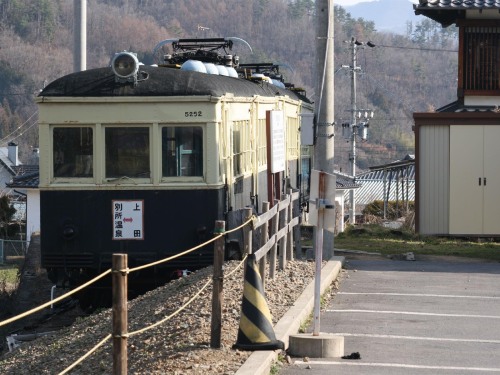
5月25日は「別所線の日」
5月25日は「別所線の日」。別所線を盛り上げようと、市民団体「別所線の将来を考える会」が、記念日として登録したもので、かつて上田電鉄別所線を走っていた「丸窓電車」ことモハ5250形の形式名にちなんで5月25日とされた。そこで今日は別所線の現状と将来について書き綴っていきたい。他の全国のローカル線と同様に乗客の減少に悩まされていた別所線であったが、2003(平成15)年以降、地元自治体である上田市は別所線存続チーム「アイプロジェクト」を発足させ、「別所線再生計画」の名のもと、市民団体との連携、企画きっぷ販売などの支援強化、親会社である東京急行電鉄から池上線で使用されていた1000系の譲受による車両の近代化などで、乗客数を回復させることに成功したが、2009(平成21)年度に再び減少に転じ、2011(平成23)年に発生した東北地方太平洋沖地震(東日本大震災)と長野県北部地震による自粛ムードが追い討ちをかけ、明るい将来が見えた矢先に、急に出口が遠退いた格好となってしまった。2012(平成24)年度は上昇に転じたものの、決して楽観視することはできず、上田電鉄と上田市は新たな乗客獲得が急務となっている。この先別所線を未来永劫に走らせるためには、従来の企画きっぷの販売に加えて、地元自治体(別所線の場合は上田市)が線路・信号・駅設備の維持管理費用に公費を充て、これらに係る固定資産税を減免する「みなし(所有権を転位しない)上下分離」の導入などより積極的な支援が必要であると言いたい。公費、すなわち税金で一民間企業の赤字を補填することには、単年度補助となり長期的な資金計画が立てづらくなるうえ、補助金目当てに企業が赤字体質から脱却できなくなる事態を招き、金の無駄遣いという悪いイメージが付きまとう。しかし「みなし上下分離」方式では、公費が充てられる箇所が、鉄道施設の中でも公共性の強い線路・信号・駅などのインフラ部分の維持管理に限定され、旧来の赤字補填よりも効率的かつ長期的な支援が可能となる。欧米諸国では、都市内の路面電車の線路などを都市の重要なインフラであると捉え、これらの維持管理に積極的に公費が充てられることが当たり前なのである。これと同じ考え方を別所線に採り入れることで、長期的に別所線を上田の街の都市機能を成す施設として、積極的に上田市が、そして上田市民が支援していくことが必要であると言いたい。別所線が一鉄道路線として、地元上田市の方々からはもちろんのこと、沿線以外の鉄道ファンや別所温泉への観光客からも愛される鉄道であり続けるために、上田市や支援団体の皆様との支援体制と連携を強化し、永続的に走り続けることを願う。Today, May 25, is "Bessho Line Day", established by a local support organization "Bessho-sen no Shorai wo Kangaeru Kai (Thinking future of Bessho Line)" to promote Ueda Electric Railway Bessho Line, the railway between Ueda and Bessho-onsen in Nagano Prefecture, after the number of an old train on Bessho Line, 5250 Series, famous for oval window next to each door. This time I would like to write about Bessho Line's present and future.The same as the other railways in rural area, Bessho Line gradually lost the passengers. Since 2003, as the local government, Ueda City's I Project has implemented the plan of strengthening the partnership with civil groups, selling discount tickets, and introducing 1000 Series coming from Tokyu Ikegami Line to improve the number of annual passengers. However, the number of passengers suddenly fell down in 2009 and since then it had gradually decreased for a couple of years again. Especially in 2011, the Great Tohoku and North of Nagano Earthquakes lead the decreasing of it more. Though the number in 2012 increased again, Ueda Electric Railway and Ueda City have to get the new passengers.I really argue that more long-term support, such as financial separation between train operation and infrastructure maintenance, for the railway to last permanently would be needed as well as discount tickets. Compensation for loss using the tax is sometimes criticized by political and economic analysts because it makes hard the company to turn into black to give the subsidy and to create a long-term plan. On this scheme the public funds are used only for infrastructure maintenance and it is believed that the scheme make it possible to create a long-term business and support plan.In the Europe and America, it is natural that the local government uses the public funds to maintain the tram/streetcar infrastructure in the city. Accepting the same or similar scheme to Bessho Line, I would like to say it can be important to support the railway as a urban device by the local government and persons.I wish the more financial support for maintenance to be needed so that Bessho Line will have been beloved by not only local persons, but also railway supporters and tourists from other places and can be lasted for good.【新幹線付プラン】別所温泉 玉屋旅館<信州別所温泉>(JR東日本びゅう提供)別所線の魅力を知るには実際に乗ってみるのが1番!!北陸(長野)新幹線「あさま」で行く別所温泉の旅 上田~別所温泉間の別所線往復乗車券付!! (1泊2日のみ) Travelling with the train is the best way to notice the attraction of Bessho Line!! Travel to Bessho hot spring area with Shinkansen Asama and Bessho Line!! (one-night stay only)
May 25, 2013
コメント(0)
-

東急5050系4000番台が西武秩父駅に初入線!!
『鉄道ファン』のWebサイトによると、5月1日深夜から2日未明にかけて、東急5050系電車4000番台が西武西武秩父線西武秩父駅まで試運転を行ったという。5050系が西武秩父駅に入線するのは今回が初めてで、10両編成の列車が西武秩父線に入線することも珍しい。この試運転は、元町・中華街駅~西武秩父駅間に臨時列車を走らせようという計画があるということを暗示しているのだろうか。東急電鉄での長距離臨時列車といえば、田園都市線中央林間駅・長津田駅~東武伊勢崎線太田駅間の「フラワーエクスプレス」が何度か運転されている実績がある。そのため、元町・中華街駅~西武秩父駅の長距離臨時列車も実現可能だと言えるのではないだろうか。実際に走るとなれば、龍勢祭か秩父夜祭の日に運転されるのだろうか?今後が気になる。According to the website of "Japan Railfan Magazine", a Tokyu 5050-4000 Series set did the trial run to Seibu-chichibu Station on Seibu Seibu-chichibu Line at midnight on May 1st and 2nd. It was first time for 5050-4000 Series to run to Seibu-chichibu Station. It is also rare that a 10-carriage set came to the Seibu-chichibu Station.This trial run probably means that the special train between the two stations may be planning. The plan for this long-distance train may come true because "Flower Express" between Chuo-rinkan Station or Nagatsuta Station on Den-en-toshi Line and Ota Station on Tobu Isesaki Line had served several times. If the train were to realise, It would operate on the day of Ryuzei Festival in October or Chichibu Night Festival in December.I'm looking forward to seeing how the plan goes.『鉄道ファン』鉄道ニュース 「東急5050系4102編成が西武秩父線で試運転」
May 4, 2013
コメント(2)
-
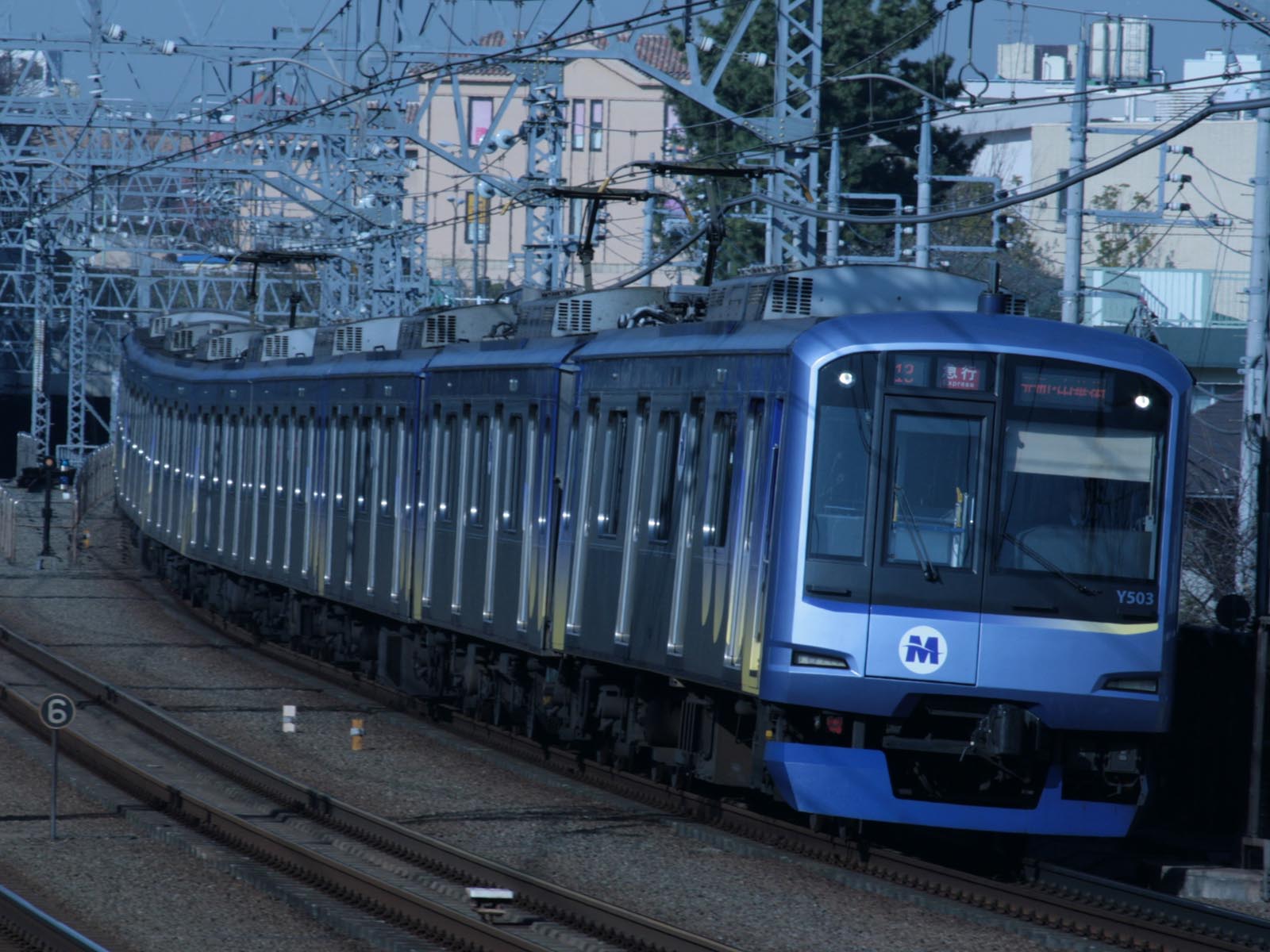
横浜高速鉄道みなとみらい線の現状と運賃改訂案
横浜高速鉄道みなとみらい線は、神奈川県横浜市の横浜駅~元町・中華街駅間を結ぶ2004(平成16)年に開業した鉄道路線。書類上はみなとみらい線は線路・駅などの所有と列車の運行をともに横浜高速鉄道が担当(第1種鉄道事業者)となっているが、実際は列車運行業務は東急電鉄に委託され、東急電鉄の乗務員がみなとみらい線内も引き続き乗務している。そのうえほぼすべての列車が東急東横線へ乗り入れている。このため、「東急みなとみらい線」と言っても過言ではないのだ。現在のみなとみらい線の運賃は、横浜駅を基準に見てみると、横浜駅~新高島駅、みなとみらい駅、馬車道駅間が180円、横浜駅~日本大通り駅、元町・中華街駅間が200円である。渋谷駅からの乗車の場合、そこに東急東横線渋谷駅~横浜駅の運賃260円が加算され、それぞれ440円、460円となる。かつての東急東横線渋谷駅~桜木町駅間の運賃が290円であった。東急電鉄とは別会社(第1種鉄道事業者)の路線として建設されたために、桜木町駅と近接するみなとみらい駅までの運賃を比較すると、150円もの値上げになってしまった。そのため古くからの東横線利用者の中にはみなとみらい線の運賃に割高感を抱いている人もいらっしゃるのではないだろうか。そこでみなとみらい線の事業形態を実態に合わせて見直し、横浜高速鉄道が線路・駅施設を所有・管理する第3種鉄道事業者、東急電鉄が列車の運行を担当する第2種鉄道事業者に変更することを提案する。東急の運賃を普通に適用した場合、渋谷駅~新高島駅間が260円、渋谷駅~みなとみらい駅、馬車道駅、日本大通り駅、元町・中華街駅間が290円。横浜駅までの運賃と同額で新高島駅へ、かつての渋谷駅~桜木町駅の運賃と同額でみなとみらい駅や元町・中華街駅まで行けるようになる。仮に、「P線方式」やニュータウン鉄道補助などの鉄道建設・運輸施設整備支援機構の支援制度を利用して建設された新規開業区間を通過する際に、または他社が所有する線路を通過する際に運賃に上乗せされる、加算運賃を30円に設定した場合であっても、渋谷駅~新高島駅間は290円、渋谷駅~みなとみらい駅、馬車道駅、日本大通り駅、元町・中華街駅間は320円で行けるようになる。この仕組みの提案の背景には、大阪港トランスポートシステムテクノポート線の失敗がある。同線は大阪府大阪市の大阪港駅~コスモスクエア駅間を結ぶ鉄道として1997(平成9)年に開業した。開業当初から大阪市地下鉄中央線および近鉄東大阪線(現:けいはんな線)と相互直通運転を実施していた。しかし大阪市交通局とは別会社の路線としたために、大阪港駅~コスモスクエア駅間は1区間しかないのに、同区間の運賃が230円と割高となり、利用者が想定よりも低迷していた。そのため2005(平成17)年より、大阪港トランスポートシステムが線路を所有する第3種鉄道事業者、大阪市交通局が線路を借りて列車営業をする第2種鉄道事業者という形態に変更された。運賃も大阪市交通局のものが適用されるようになり、梅田駅~コスモスクエア駅間の運賃が480円から270円へと210円も値下げが実現した。この反省を踏まえてか、以降新規開業した京阪中之島線、阪神なんば線、京成成田スカイアクセス線などでは、新会社が建設・所有を担当するものの、列車の運行は既存の鉄道事業者とする事例が多く見られる。新規参入の第1種鉄道事業者は、既存路線の引継会社を除くと、首都圏新都市鉄道以来誕生していない。Upon the face of the document handed to the Ministry of Land, Infrastructure, and Transport, Minatomirai Line, spreading from Yokohama Station to Motomachi-chukagai [Motomachi and Yokohama Chinatown] Station in Yokohama, Kanagawa Prefecture, is owned and operated by Yokohama Minatomirai Railway Line. However, the train drivers on Minatomirai Line belong to Tokyu Corporation and most of the trains go through Tokyu Toyoko Line. It is said that some railfans see it as a part of Toyoko Line.The fare of Minatomirai costs \180(up to 3.0km, for example, from Yokohama Station to Shin-takashima, Minatomirai, and Bashamichi Stations) or \200(3.1km and over, for example from Yokohama Station to Nihon-odori, and Motomachi-chukagai Stations). If passengers come from Shibuya Station, it costs \440 or \460, adding Toyoko Line's fare between Shibuya Station and Yokohama Station, \260. As a guide, before the open of Minatomirai Line, the fare between Shibuya Station and Sakuragicho Station, which was abolished in 2004, cost \290. Because of the present fare more \150 expensive than the former one, some people knowing the fare of Toyoko Line may feel the one of Minatomirai Line can be too expensive because it was constructed by the other railway company.This time I would like to suggest that the operator and the fare of Minatomirai Line officially change to fit reality.Applying the present Tokyu's fare directly, it costs \260 to Shin-takashima Station, the same as Yokohama Station, and \290 to Minatomirai, Bashamichi, Nihon-odori, and Motomachi-chukagai Stations, the same as Sakuragicho Station in the past. If the added fare, applying when travelling on the newly constructed section giving support or subsidy of Japan Railway Construction, Transport and Technology Agency, set price of \30, the passengers could go to Shin-takashima Station with \290, and to Minatomirai, Bashamichi, Nihon-odori, and Motomachi-chukagai Stations with \320.What this suggestion leads is the failure of Osaka Port Transportation System, which spread Osakako [Osaka Port] Station and Cosmosquare Station in Osaka City opened in 1997. Though it was just only the next station, the fare between Osakako [Osaka Port] Station and Cosmosquare Station was \230, which lead fewer passengers than the first expectation. To draw more passengers, it was merged into Osaka Municipal Chuo Line in 2005 and the fare slash \210 off the price, from \480 to \270 when the passenger travels from Umeda on Osaka Municipal Subway Midosuji Line to Cosmosquare.Reflecting this failure, In case of Keihan Nakanoshima Line, Hanshin Nanba Line, and Keisei Narita Skyaccess Line, etc., the infrastructure constructor doesn't operate the train on its own and lends it to the existing railway company. Since the open of Metropolitan Interurban Railway(MIR) in 2005, no more railway companies that both own and manage its infrastructure and operate the train newly opened excepting the one inheriting existing lines.
Mar 8, 2013
コメント(0)
-
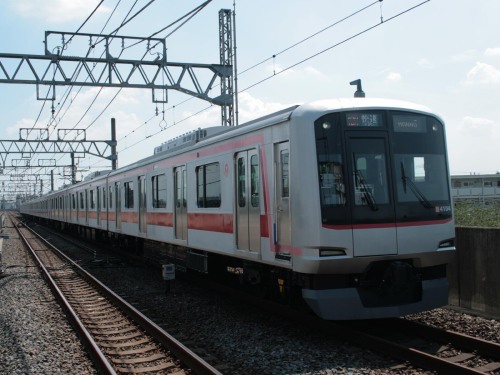
東横線・副都心線直通デビューダイヤを考察する
すでにご存知の方もいらっしゃるとは思うが、去る1月22日、3月16日にいよいよスタートが迫った横浜高速鉄道みなとみらい線・東急東横線・東京メトロ副都心線・東武東上線・西武池袋線の直通運転のダイヤ概要が発表された。横浜高速鉄道・東急電鉄・東京メトロ・西武鉄道・東武鉄道各社のプレスリリース、および2月に東急電鉄が発表した新しい東横線の時刻表をまとめた運行計画は以下のとおり。まずは東横線・みなとみらい線、副都心線、池袋線、東上線それぞれで列車種別が変わるということ。新しい東横線の時刻表によると、平日日中の1時間あたりの副都心線直通列車14本の内訳は、各停列車6本、急行列車(副都心線各停)4本 、東横特急列車(副都心線急行)4本。このうち各停列車2本が新宿三丁目駅止まり、東横特急列車2本と各停列車2本が池袋線方面、急行列車4本と各停列車2本が和光市行き、東横特急列車2本が東武東上線方面への直通列車となる。みなとみらい線・東横線の看板列車である「東横特急」は、副都心線内では急行列車、池袋線内では快速急行列車、東上線内では従来どおり和光市駅以西が各停として運行される。現行ダイヤの西武池袋線快速急行列車は練馬駅には停車しないが、3月16日より東横線・みなとみらい線直通の快速急行列車のみ練馬駅に(西武有楽町線新桜台駅・小竹向原駅にも)停車する。平日夕ラッシュ時の東横特急列車と通勤特急列車も副都心線内では急行列車となる。池袋線直通列車は、池袋線内快速で運行される。急行列車は、日中時間帯は各停列車となるが、副都心線内朝ラッシュ時は急行列車または通勤急行列車としての運転となる。このほか朝ラッシュ時に千川駅発と池袋駅止まりの副都心線各停列車が新設される。ここから僕の考察に入る。まずは所要時間について。横浜駅~池袋駅間の所要時間を対比すると、東横特急・副都心線急行列車が38分、JR東日本湘南新宿ライン特別快速列車が35分と、湘南新宿ライン列車のほうが3分早い。しかし横浜駅~川越駅間の所要時間になると、JR東日本は大崎駅で湘南新宿ライン特別快速から埼京線快速へ乗り換え、東急・東京メトロ・東武は東上線直通の東横線内東横特急・副都心線内急行・東上線内各停と種別が変わる列車で対比してみると、東横特急・急行・各停が78分、JR東日本が湘南新宿ライン特別快速列車19分・乗換待ち時間3分、埼京線快速列車68分で合計90分。横浜駅~池袋駅ではJR東日本の勝ちだが、横浜駅~川越駅では乗換なしという利便性が功を奏し、東急・東京メトロ・東武の勝ちとなる。このため東急・東京メトロ・東武がJR東日本に対抗するためには、「乗換なしで川越へ」を大々的に宣伝する必要があると僕は考えている。次に列車種別について書く。池袋線直通列車が、練馬駅停車という制約から現行ダイヤでは快速列車または準急列車として運行されているが、これが一気に料金不要種別で最も速い快速急行列車に格上げされた。東横特急列車を主力に置きたい東急電鉄の姿勢に、東京メトロと西武鉄道がそれぞれの最速達種別である急行と快速急行の種別を与える形で、好反応を示したようにも思える。自社線内では速いものの、地下鉄に乗り入れると各停になってしまう列車が多い中で、「『東横特急』は地下鉄でも、西武線でも速い」と東横特急の存在感を見せ付けることだろう。僕も個人的な考えとして、以前から地下鉄直通列車を急行または快速急行に格上げされることを望んでいた。しかし今改正でも相変わらず、東上線直通列車はすべて東上線内は各停列車としての運行である。川越市駅以西は各停列車では時間がかかりすぎる、もしくは日中の副都心線・東横線直通需要はないと考えられているのだろうか。平日日中時間帯の副都心線直通列車の運行本数を見てみると、和光市まで、もしくは西武池袋線直通に力を入れたダイヤ編成となっているため、所要時間と乗換回数でJRより勝っている横浜~川越間輸送にもっと力をいれてはいかがと思う。各停または急行を和光市止まりにせず、各停でもよいので川越市まで延長することを望む。東横特急と急行が1時間に4本ずつを基本としているため、増発は望めないが、東武東上線に直通する東横特急を、東上線内快速または快速急行にして森林公園まで運行させることも提案する。歴史的経緯をからめて考えてみると、かつて五島慶太の勢力下にあった東急電鉄と、その五島慶太と敵対関係にあった堤康次郎勢力下の西武鉄道が、永遠のライバルと言われた東急電鉄の車両・列車を乗り入れさせること、さらには料金不要の最速達種別を名乗る権利を与えることは、両社がいがみ合っていた過去を知る者の目には、相当な妥協、もしくは和解のようにも映るであろう。そして新宿三丁目駅に元町・中華街方面からの列車が折り返せるように引上線を設けたことは、当初の計画とは経路が違うものの、五島慶太の「東京横浜電鉄(東急東横線)新宿延伸計画」が長い年月を経てようやく実現したと捉えることもできる。On January 22nd, the five railway companies, Yokohama Minatomirai Railway, Tokyu Corporation, Tokyo Metro, Tobu Railway, and Seibu Railway, announced the outline about their new timetables for going-through service between Hanno Station on Seibu Ikebukuro Line or Shinrin-koen Station on Tobu Tojo Line, and Motomachi-chukagai Station on Yokohama Minatomirai Railway Line via Tokyo Metro Fukutoshin Line and Tokyu Toyoko Line.According to the press releases and new timetables, it is an important point that those five lines have a different pattern of train service and most trains change the name of service at the border station between the companies. For example, In case of a limited express train on Toyoko Line going through Fukutoshin Line and Ikebukuro Line, the name of service changes to express on Fukutoshin Line at Shibuya Station and does to rapid express on Ikebukuro Line at Kotake-mukaihara Station.On the weekdays, fourteen trains go through Fukutoshin Line from Toyoko Line an hour. Six local trains (as local trains on Fukutoshin Line), four express trains (as local trains on Fukutoshin Line), and four limited express trains (as express trains on Fukutoshin Line) serve. More specifically, two local trains terminate at Shinjuku-sanchome Station, four express trains and two local trains are bound for Wakoshi Station, two limited express trains and two local trains go toward Ikebukuro Line, and two limited express trains toward Tojo Line. In the morning and evening, the limited express trains and the commuter limited express trains go through Fukutoshin Line (as commuter express trains) and Ikebukuro Line (as rapid trains). The express trains do (as express trains toward Ikebukuro Line or commuter express trains toward Tojo Line). Also, some local trains from Senkawa Station toward Toyoko Line and terminated at Ikebukuro Station from Toyoko Line started to serve.From here, I would like to write about my opinions. First is about the comparison to JR East Shonan-shinjuku Line, second is the pattern of the train service.It takes 38 minutes by going-through train on Toyoko Line and Fukutoshin Line between Yokohama Station and Ikebukuro Station, which is three minutes longer than that of Shonan-shinjuku Line. However, the travel time of the going-through service train between Yokohama Station and Kawagoe Station is shorter. It takes 78 minutes without transfer. In case of travelling JR lines, it does more 12 minutes via Shonan Shinjuku Line and Saikyo Line with a transfer.About the pattern on Ikebukuro Line, the fast trains from Fukutoshin Line serve as the rapid trains or semi express trains on Ikebukuro Line because the trains have to stop at Nerima Station. However, those from Toyoko Line does as the rapid express trains, which is the second-fastest service. I see that Tokyo Metro and Seibu may accept Tokyu's request to serve the fast and convenient service on Fukutoshin Line and Ikebukuro Line.On the other hand, all trains from Fukutoshin Line stop at all stations on Tojo Line. In my opinion, it would be better that the express trains on Fukutoshin Line serve as the express trains or the rapid express trains on Tojo Line to be faster and to extend its service to Shinrin-koen Station. Because of a few train services toward Tojo Line, some local trains from Fukutoshin Line need to extend the service to Kawagoeshi Station. However, Tobu Railway has no plan to extend trains toward Fukutoshin Line and Toyoko Line to farther than Kawagoeshi Station because of long distance and no demand.Some railfans who know the history of Japanese railway may be surprised at the going-through service between Toyoko Line and Ikebukuro Line. In 1950s and 1960s, Tokyu Corporation and Seibu Railway competed to develop tourist attractions in Hakone, Kanagawa Prefecture. Also, the sidetrack at Shinjuku-sanchome Station for returning the trains from Toyoko Line may remind some railfans of an old extension plan to Shinjuku Station of Toyoko Line.
Feb 17, 2013
コメント(0)
-
減らない第4種踏切と踏切の廃止
2013(平成25)年1月18日に埼玉県行田市の秩父鉄道秩父本線の遮断機も警報機もない踏切(第4種踏切)で、自転車に乗って踏切を渡ろうとした小学5年生の少年が電車に轢かれて死亡する事故が発生した。この事故を受けて行田市は、ここを含む市内すべての秩父本線の第4種踏切の廃止を固め、これから住民と協議していく方向であるという。秩父鉄道では、現在でも秩父本線に99ヵ所存在する第4種踏切を廃止したい一方で、沿線住民の利便性への考慮と、遮断機と警報機の設置に多額の資金が必要となることから、これらの踏切が手付かずの状態になっているのだという。2008(平成20)年以降、秩父本線の第4種踏切では、この少年も含めて4人の死者が出てしまった。踏切の廃止については、踏切の管理義務は鉄道事業者と行政のどちらが負うのか、踏切は鉄道事業者の独断で廃止できるのかという点が争点となる。まず踏切の所有権と管理義務については、踏切は鉄道事業者の固定資産であると鉄道事業会計規則で定められているため、管理義務も鉄道事業者に帰属する。そのため行政が一方的に民間企業の資産に手を付けることができない。今回の秩父鉄道の場合、行政側である行田市が踏切の廃止を決定したが、踏切を撤去し、その費用を負担するのは秩父鉄道である。鉄道事業者の資産であることから、鉄道事業者の独断で踏切を廃止できるかというと、そうではない。踏切など鉄道施設の廃止・変更に関しては「当該変更に係る工事計画を定め、国土交通大臣の認可を受けなければならない。」と鉄道事業法第十二条で定められている。踏切の撤去については、高架化、地下化といった立体交差化を伴う場合、鉄道事業者と道路管理者の共同負担となることが、踏切道改良促進法で定められている。また立体交差化や第4種踏切や第3種踏切(警報機はあるものの遮断機がない踏切)への警報機・遮断機の設置に対しては鉄道建設・運輸施設整備支援機構からの補助金があり、秩父鉄道もこの補助制度を利用していた。しかしこれらの踏切のように立体交差化を伴わない、単純に踏切の廃止が目的の場合は、鉄道事業会計規則で定められている「鉄道事業固定資産の除却」にあたるため、固定資産除却費として鉄道事業者が全額負担しなければならない。鉄道建設・運輸施設整備支援機構の補助制度も存在しない。秩父鉄道では以前から第4種踏切の整理と第1種踏切への改良を進めているようだが、前述のとおり費用負担が難しいために、99ヵ所もの第4種踏切が手を付けられずにいるのだと見られる。これまた地方鉄道の経営の厳しさを見せ付けられた。On January 18th, 2013, a 5th grade elementary schoolboy riding a bicycle was killed by a Chichibu Railway Chichibu Main Line train on a crossing without the signal and bar in Gyoda City, Saitama Prefecture.This accident lead the decision of Gyoda City office that all railway crossings without the signal and bar on Chichibu Main Line would be abolished and the city would discuss the city people with removing these crossings.On Chichibu Main Line, 99 crossings without the signal and bar remains and the company wants to remove them. However, it is hard to remove them for the convenience for people living along the railway and the luck of money. Since 2008 seven accidents happened and four persons including that boy had been killed at the crossings.To remove the railway crossings, which railway company or roadway manager own and to be able to abandoned on the railway company's own become a point of issue.Because the railway business accounting law provide that the railway crossing and the other parts being attatched to the crossing are the asset belonging to the railway company, the city can't touch private company's assets and Chichibu Railway has to pay the cost to remove the crossings.However, the railway company can't abandon the crossings by the company's own; the railway business account law provides that the railway company needs the allowance of Transportation Minister when the company changes or abolishes the infrastructures.In the cases of replacing grade crossings with overpasses and setting the signal and bar onto the crossing, Japan Railway Construction, the cost of crossings' abolishment pays both the railway company and the roadway manager, and, in some cases, Transportation and Technology Agency gives a grant. Chichibu Railway has also been given some grant when the signal and the bar put on some crossings. However, in case of just removing the crossings the railway company is responsible for all scrapping of property and there is no subsidy.Though Chichibu Railway has struggled to improve some crossings without the signal and the bar, it seems to be hard to remove the 99 crossings. I saw the difficult atmosphere to manage the railways in remote area.
Feb 9, 2013
コメント(0)
-
遅延がさらに遅延を呼ぶ現状
5日朝、西武池袋線が遅れた。原因は中村橋~練馬間での車両の架線の繋ぎ目(エアセクション)内停止だという。僕が大泉学園駅のホームに着いた時、東京メトロ10025Fの7:52発の準急新木場行きが停車中だった。そこで僕は列車遅延が更なる遅延を引き起こす原因であることを目の当たりにする。列車の車内はすでに超満員なのにも関わらず、乗ろうとする客がいることだ。駅員が「この辺でドアを閉めます。」とアナウンスしていることにもお構いなしで乗ろうとする客が後をたたず、車掌はドアを閉められない。発メロが鳴り車掌がドア扱いをするも大勢の乗客に支障されてドアが閉まらないどころか、少し動いただけで動かなくなってしまったドアもあった。10025Fは車掌のドアスイッチ扱いからすべての車両の側灯が消えるまで30秒近く時間を要した。列車が遅れると、乗客も1本でも早い列車に乗ろうとする心理が働いて、駅に停車中の列車に、すでに満員であっても乗ろうとする。しかし乗客が支障となりドアが閉まらない。これが更に遅れの時間を延ばす原因なのではと見て取れる。これがホームドアを設置している路線で発生したらどうなるのか。以前東京メトロ有楽町線小竹向原駅で僕が見た光景である。発車時刻になり車掌がドアを閉めようとするが、ホームドアが閉まったが車両のドアの側灯が点灯のままで再開閉扱いした。車両のドアが開くとホームドアも連動して開く仕組みになっていたため、ホームドアも開く。そして再び両方のドアが閉まり、ようやく列車は発車できた。両方のドアが開放されたために、このわずかな隙を狙って駆け込もうとする客が発生する。こうなると再び車両のドアとホームドア両方が閉まるまで発車できなくなってしまうという訳だ。ホームドアによる遅れへの解決策としては、車両のドアとホームドアの動きを連動させずに独立して動かせるようにすることだ。車両のドアにだけ物が挟まって閉められない状況においては、ホームドアを閉めたまま車両のドアを再開閉させた方が、駆け込み乗車をなくし、遅延防止に繋がるのではと考える。On the morning of 5th, Seibu Ikebukuro Line delayed because of a train's stop in the joint of electric line between Nakamurabashi and Nerima Stations.As I came to the platform of Oizumi-gakuen Station, a semi express train for Shin-kiba by 10025F set of Tokyo Metro 10000 Series at 7:52 was stopping. Then I saw the evidence that the train delay made itself worse.Once the train delayed, in spite of being already crowded, people tried to get on the faster one to reach where they go. Though the train was already crowded and as the announcement by a station staff that the doors soon be closing heard, the conductor couldn't close the doors because of some people trying to rush into. Soon after the departure sign ended to play, the conductor tried to close the doors, but the passengers standing near the doors had their closing disturbed. Especially, some of them stopped as soon as trying to close, which I found lead the worse delay. As a result, it took 30 seconds to close all doors.If this situation happened at a station with platform screen doors, it may take much time. This was what I saw at Kotake-mukaihara Station on Tokyo Metro Yurakucho Line.The red lights on the train side completely turned off to tell the conductor some of them couldn't close, though the platform screen doors completely closed. He reopened them but the platform screen doors followed them because the platform screen doors worked automatically as the train doors opened and closed without conductor's or driver's command. The conductor retried to close, then both doors closed completely and the train left. I found this brief time opening both doors let some people rush into the train, which the train needed more time to stop until closing both doors.To solve the delay attributed to the platform screen, I suggest that the each door works indipendently. In the situation that only a train door caught an object while closing, it would be better to reopen it without the platform screen to reduce people's rushing into and train's delay.
Feb 5, 2013
コメント(0)
-

さようなら 「夏色キセキ」電車
今年2012年7月から伊豆急行線で運転されてきた2100系第5編成「アルファ・リゾート21」の「夏色キセキ」ラッピング仕様車が、10月31日でラストランを迎えた。車体に主役の夏海ちゃん、紗季ちゃん、優香ちゃん、凛子ちゃんの4人や、アニメの名シーンがラッピングされ、車内アナウンスも4人を演じた人気声優4人組ユニット・スフィア(寿美菜子さん、高垣彩陽さん、戸松遥さん、豊崎愛生さん)の声が使用された特別仕様となり、人気を博した。ここで伊豆急行と「夏色キセキ」のつながりを振り返ってみよう。伊豆急行は「夏色キセキ」に、下田市、下田ロープウェイとともに製作段階から協力しており、アニメの7話と8話に2100系第4編成「黒船電車」が、11話と12話に第5編成「アルファ・リゾート21」が登場した。2012年6月、伊豆急行と、伊豆急行の親会社である東急電鉄が夏海ちゃんを、伊豆急行線沿線の観光振興を目的とした「オモシロ駅長」に就任させ、伊豆急下田駅に伊豆急行の制服を着た夏海ちゃんを中心に、主役の4人が描かれたパネルが設置されたり、4人と2100系第4編成「黒船電車」が描かれた車内広告や駅ポスターが掲出された。これと同時に、まず2100系第5編成「アルファ・リゾート21」で、主役の4人の声による車内アナウンスが始まった。7月の伊豆高原車庫で開催された「伊豆急電車まつり」で、車内アナウンスが導入されていた2100系第5編成が「夏色キセキ」ラッピング電車としてお披露目され、7月30日から10月31日までの間、アニメの舞台となった下田への観光客を乗せて走った。ラストランを迎えるにあたって、10月25日から31日までの間、第5編成車内でシナリオ、絵コンテ、原画や台本などを展示するイベントも開催された。また、関連グッズも多く登場し、2100系「リゾート21」を象ったパッケージに入った「伊豆急電車サブレ」の「夏色キセキ」ラッピング電車バージョンや金目鯛のひものや金目鯛せんべい、「夏色キセキ」記念きっぷが伊豆急下田駅限定で販売された。これからはラッピングを剥がし、車内放送も車掌さんの声になるが、「夏色キセキ」の11話と12話に登場した電車として、「夏色キセキ」ファンから写真を撮られることだろう。そして、伊豆急行線と下田の街が「夏色キセキ」ファンに末永く愛されるように祈りたい…。On 31st, October, 2100 Series "Alpha Resort 21 Natsuiro Kiseki version" finished its regular operation.Because of the decoration of the main characters, Natsumi Aizawa, Saki Mizukoshi, Yuka Hanaki, and Rinko Tamaki and some scenes and the announcement by the voice actresses of the 4 girls, Sphere (Minako Kotobuki, Ayahi Takagaki, Haruka Tomatsu, and Aki Toyosaki), the train was paid attention of anime fans and railway supporters.Then this blog review the relation between Izu Kyuko and "Natsuiro Kiseki".Izu Kyuko cooperated with the anime production in the work together with Shimoda City and Shimoda Cable Car. Because of this cooperation, the 4th model of 2100 Series "Black Ship Train" appeared on the episode 7 and 8, and 5th model of that train "Alpha Resort 21" did on the episode 11 and 12. On June Izu Kyuko appoint Natsumi to a tourist ambassador at Izukyu-shimoda Station. Since that day the announcement of the train operated by 2100 Series 5th model changed to the one by the voice actresses of 4 girls, the life-size cut-out of the 4 girls, in which Natsumi-chan standing at the centre wore the uniform of the station staff, put at the station, and the poster featuring the 4 and 2100 Series 4th model was shown at the stations and in the trains. In the event at Izu-kogen train shed on July, the 2100 Series 5th model was shown with the decoration of the 4 girls and the famous scenes. The train had run between July 30th and October 31st to carry the tourists to see the scene of the work. For its last run, between October 25th and 31st some scripts, pictures, and continuities were shown in the train.Some products, such as special ticket, cookies in the train-looking package, dried splendid alfonsino, and rice cracker mixed with dried splendid alfonsino, etc. was sold at Izukyu-shimoda Station.From November 1st, the 5th model changes to the original one and the announcement does to the conductor's one, but I wish the train would continue to be paid attention and and photographed by "Natsuiro Kiseki" fans because it appeared on the work.
Oct 31, 2012
コメント(0)
-
PASMO利用履歴漏洩事件について
先日のニュースでも放送された、東京メトロ元駅員による、女性乗客が持っていた記名式PASMOの利用履歴を駅の機械で読み取り、インターネットの掲示板に公開した事件。Suica・PASMOなどの鉄道ICカード乗車券は、自動改札機に1秒間タッチするだけで入場でき、残高がなくなったらお金をチャージして繰り返し使えるカードとして、全国的に広まった。しかし今回の事件はICカード乗車券の便利さに隠れた危険を露呈することとなりそうだ。2007(平成19)年に登場した記名式の「My Suica」「記名式PASMO」は、それまで定期券機能が付いたSuicaのみで行われていた、紛失による再発行を、定期券機能のないものでも、名前・住所・電話番号を登録することで可能にしたものである。しかし紛失した際に、登録した情報や利用履歴が発見者によって不正に読み取られてしまえば、利用履歴をもとに、居住地や会社所在地だけでなく、チャージや電子マネーの利用履歴から、利用傾向、性格までもが外部に漏れ出る危険があると専門家は言う。一時期、クレジットカードのスキミングが社会問題になったため、クレジットカードにSuica同様のICチップを埋め込ませ、偽造が簡単にできないように工夫された。以前、テレビドラマ「科捜研の女」で、容疑者の足どりをつかむために、ICOCAを機械に読み取り利用履歴を調べるというシーンがあったが、情報を読み取るICカードリーダーは簡単に手に入ってしまう。ICカードリーダーは3000円程度の値段で一般に売られているほか、ソニーのノートパソコンにはほぼ標準で「FeliCaポート」と呼ばれる搭載されている。これにSuica・PASMOなど対応のICカード乗車券をタッチしてしまえば、いとも簡単に履歴を見られるようになってしまう。そして、利用者の動きだけでなく性格までもが漏洩する危険にさらされるのだ。以前の西武鉄道と相模鉄道の駅員がSuicaの利用履歴を改ざんし不正乗車をした事件も衝撃的だったが、今回の事件も鉄道会社の信頼を揺らぎかねない深刻な事態になりそうだ。A couple of days ago, I heard the news that a station staff of Tokyo Metro showed the history of a PASMO on the Internet.The smartcard, such as Suica and PASMO etc., has spread all over Japan because of its convenience with a one-second touch on the station gate and able to charge fare permanently.However, this problem exposes a hidden danger when the passenger loses the card.The smartcard with the registration of the user's name, address, and telephone number, started to sell in 2007 and can reissue when they lost the card. However, an expert said that if a finder illegally loads the travelling history of the card, the user's workplace, the railway line on commuting, activity, and character can be revealed as well.A few years later, credit card skimming was recognized as a social problem and the card with RFID issued to prevent illegal payment and load of the user's ID.In a Japanese TV drama "THE WOMAN OF SCIENCE RESEARCH INSTITUTE", the heroine and her co-workers researched the history of a suspect's ICOCA to trace his activity. However, you can get the IC card reader at electric appliance stores from about 3,000 yen. Also, the laptop PCs made by SONY has the built-in reader named "FeliCa Port". If the card was touched these readers, everyone can know not only your ID, but also how you are doing in detail.This time is more shocking than the problem that Seibu and Sotetsu station staffs altered their Suica to do illegal travel.
Apr 20, 2012
コメント(0)
全75件 (75件中 1-50件目)










